This is “Rational Expressions and Equations”, chapter 7 from the book Beginning Algebra (v. 1.0). For details on it (including licensing), click here.
For more information on the source of this book, or why it is available for free, please see the project's home page. You can browse or download additional books there. To download a .zip file containing this book to use offline, simply click here.
Chapter 7 Rational Expressions and Equations
7.1 Simplifying Rational Expressions
Learning Objectives
- Determine the restrictions to the domain of a rational expression.
- Simplify rational expressions.
- Simplify expressions with opposite binomial factors.
- Simplify and evaluate rational functions.
Rational Expressions, Evaluating, and Restrictions
A rational number, or fraction , is a real number defined as a quotient of two integers a and b, where . Similarly, we define a rational expressionThe quotient of two polynomials P and Q, where Q ≠ 0., or algebraic fractionTerm used when referring to a rational expression. , as the quotient of two polynomials P and Q, where . Some examples of rational expressions follow:

The example consists of linear expressions in both the numerator and denominator. Because the denominator contains a variable, this expression is not defined for all values of x.
Example 1: Evaluate for the set of x-values {−3, 4, 5}.
Solution: Substitute the values in for x.

Answer: When , the value of the rational expression is 0; when , the value of the rational expression is −7; and when , the value of the rational expression is undefined.
This example illustrates that variables are restricted to values that do not make the denominator equal to 0. The domain of a rational expressionThe set of real numbers for which the rational expression is defined. is the set of real numbers for which it is defined, and restrictionsThe set of real numbers for which a rational expression is not defined. are the real numbers for which the expression is not defined. We often express the domain of a rational expression in terms of its restrictions.
Example 2: Find the domain of the following: .
Solution: In this example, the numerator is a linear expression and the denominator is a quadratic expression. If we factor the denominator, then we will obtain an equivalent expression.

Because rational expressions are undefined when the denominator is 0, we wish to find the values for x that make it 0. To do this, apply the zero-product property. Set each factor in the denominator equal to 0 and solve.

We conclude that the original expression is defined for any real number except 3/2 and −2. These two values are the restrictions to the domain.
It is important to note that −7 is not a restriction to the domain because the expression is defined as 0 when the numerator is 0.
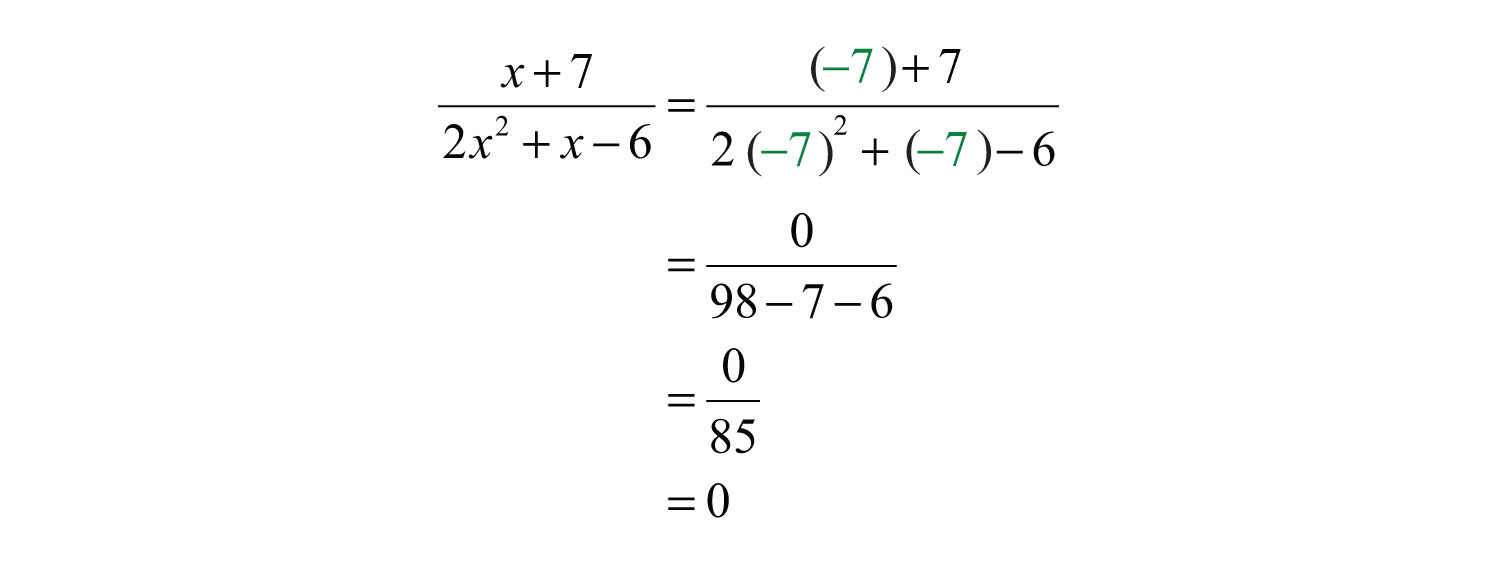
Answer: The domain consists of any real number x, where and .
We can express the domain of the previous example using notation as follows:

The restrictions to the domain of a rational expression are determined by the denominator. Ignore the numerator when finding those restrictions.
Example 3: Determine the domain: .
Solution: To find the restrictions to the domain, set the denominator equal to 0 and solve:

These two values cause the denominator to be 0. Hence they are restricted from the domain.
Answer: The domain consists of any real number x, where .
Example 4: Determine the domain: .
Solution: There is no variable in the denominator and thus no restriction to the domain.
Answer: The domain consists of all real numbers, R.
Simplifying Rational Expressions
When simplifying fractions, look for common factors that cancel. For example,

We say that the fraction 12/60 is equivalent to 1/5. Fractions are in simplest form if the numerator and denominator share no common factor other than 1. Similarly, when working with rational expressions, look for factors to cancel. For example,

The resulting rational expression is equivalent if it shares the same domain. Therefore, we must make note of the restrictions and write

In words, is equivalent to , if and . We can verify this by choosing a few values with which to evaluate both expressions to see if the results are the same. Here we choose and evaluate as follows:
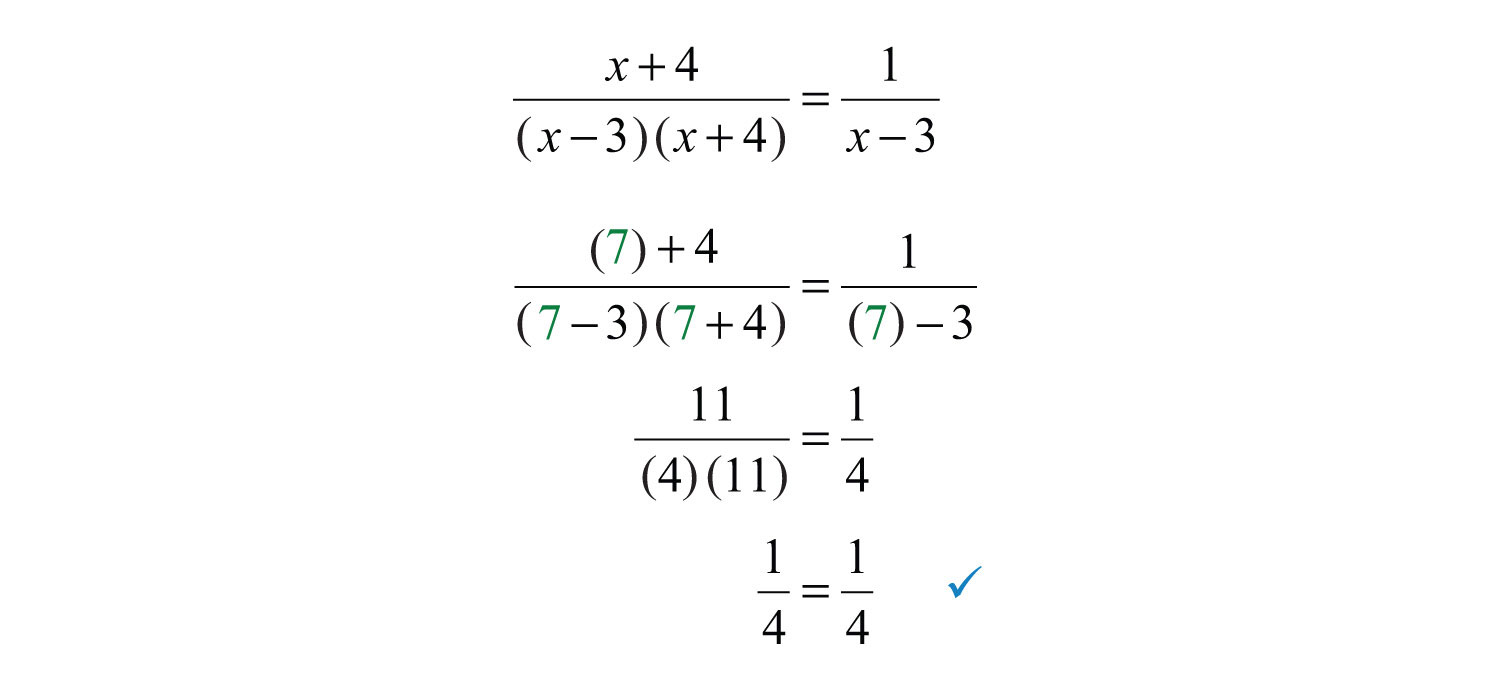
It is important to state the restrictions before simplifying rational expressions because the simplified expression may be defined for restrictions of the original. In this case, the expressions are not equivalent. Here −4 is defined for the simplified equivalent but not for the original, as illustrated below:

Example 5: Simplify and state the restriction: .
Solution: In this example, the expression is undefined when x is 0.

Therefore, the domain consists of all real numbers x, where . With this understanding, we can cancel common factors.

Answer: , where
Example 6: State the restrictions and simplify: .
Solution: To determine the restrictions, set the denominator equal to 0 and solve.

The domain consists of all real numbers except for −1/2 and 5. Next, we find an equivalent expression by canceling common factors.

Answer: , where and
Typically, rational expressions are not given in factored form. If this is the case, factor first and then cancel. The steps are outlined in the following example.
Example 7: State the restrictions and simplify: .
Solution:
Step 1: Completely factor the numerator and denominator.

Step 2: Determine the restrictions to the domain. To do this, set the denominator equal to 0 and solve.

The domain consists of all real numbers except −2 and 1.
Step 3: Cancel common factors, if any.

Answer: , where and
Example 8: State the restrictions and simplify: .
Solution: First, factor the numerator and denominator.

Any value of x that results in a value of 0 in the denominator is a restriction. By inspection, we determine that the domain consists of all real numbers except 4 and 3. Next, cancel common factors.

Answer: , where and
It is important to remember that we can only cancel factors of a product. A common mistake is to cancel terms. For example,

Try this! State the restrictions and simplify: .
Answer: , where and
Video Solution
(click to see video)In some examples, we will make a broad assumption that the denominator is nonzero. When we make that assumption, we do not need to determine the restrictions.
Example 9: Simplify: . (Assume all denominators are nonzero.)
Solution: Factor the numerator by grouping. Factor the denominator using the formula for a difference of squares.

Next, cancel common factors.

Answer:
Opposite Binomial Factors
Recall that the opposite of the real number a is −a. Similarly, we can define the opposite of a polynomial P to be −P. We first consider the opposite of the binomial :

This leads us to the opposite binomial propertyIf given a binomial , then the opposite is .:

This is equivalent to factoring out a –1.

If , then we can divide both sides by and obtain the following:

Example 10: State the restrictions and simplify: .
Solution: By inspection, we can see that the denominator is 0 if . Therefore, 3 is the restriction to the domain. Apply the opposite binomial property to the numerator and then cancel.

Answer: , where
Since addition is commutative, we have

or

Take care not to confuse this with the opposite binomial property. Also, it is important to recall that

In other words, show a negative fraction by placing the negative sign in the numerator, in front of the fraction bar, or in the denominator. Generally, negative denominators are avoided.
Example 11: Simplify and state the restrictions: .
Solution: Begin by factoring the numerator and denominator.
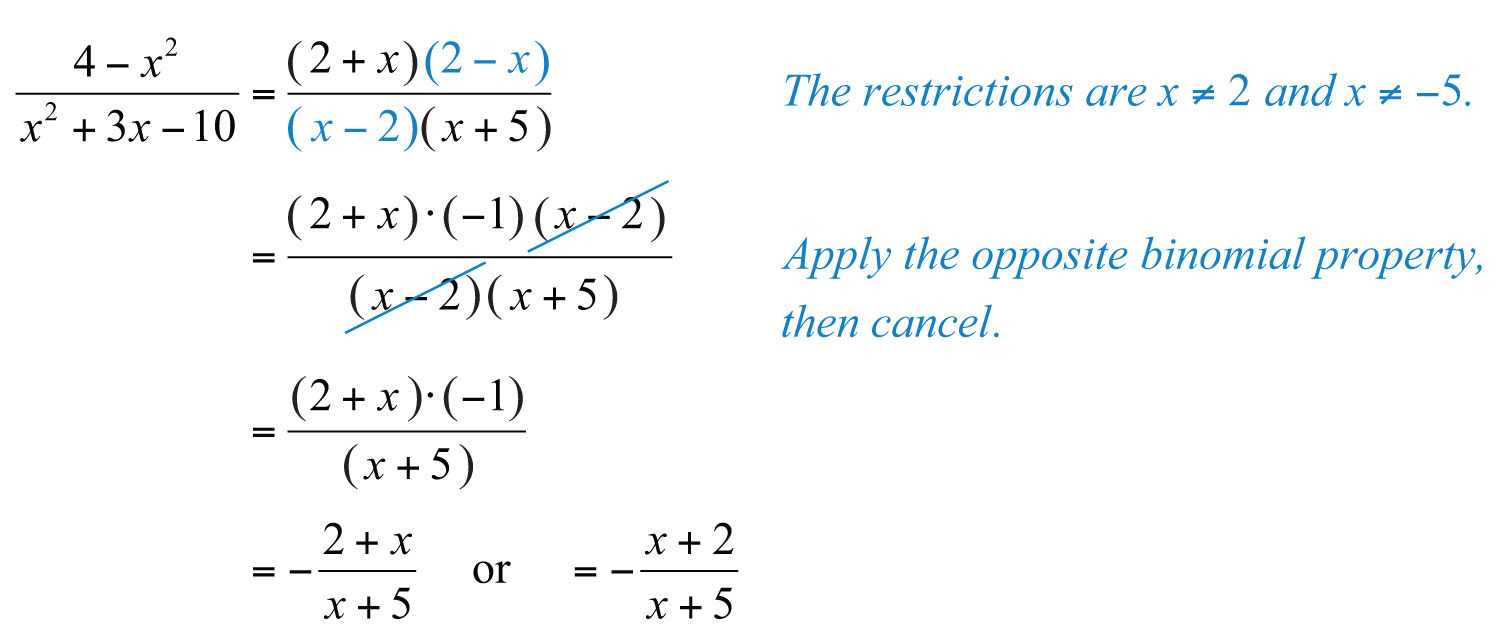
Answer: , where and
Try this! Simplify and state the restrictions: .
Answer: , where
Video Solution
(click to see video)Rational Functions
Rational functions have the form

where and are polynomials and . The domain of a rational function consists of all real numbers x such that the denominator .
Example 12:
a. Simplify: .
b. State the domain.
c. Calculate .
Solution:
a. To simplify the rational function, first factor and then cancel.

b. To determine the restrictions, set the denominator of the original function equal to 0 and solve.

The domain consists of all real numbers x, where and .
c. Since −2 is not a restriction, substitute it for the variable x using the simplified form.

Answers:
a.
b. The domain is all real numbers except 0 and −3.
c.
If a cost functionA function that represents the cost of producing a certain number of units. represents the cost of producing x units, then the average costThe total cost divided by the number of units produced, which can be represented by , where is a cost function. is the cost divided by the number of units produced.

Example 13: The cost in dollars of producing t-shirts with a company logo is given by , where x represents the number of shirts produced. Determine the average cost of producing
a. 40 t-shirts
b. 250 t-shirts
c. 1,000 t-shirts
Solution: Set up a function representing the average cost.

Next, calculate , , and .

Answers:
a. If 40 t-shirts are produced, then the average cost per t-shirt is $12.00.
b. If 250 t-shirts are produced, then the average cost per t-shirt is $7.80.
c. If 1,000 t-shirts are produced, then the average cost per t-shirt is $7.20.
Key Takeaways
- Rational expressions usually are not defined for all real numbers. The real numbers that give a value of 0 in the denominator are not part of the domain. These values are called restrictions.
- Simplifying rational expressions is similar to simplifying fractions. First, factor the numerator and denominator and then cancel the common factors. Rational expressions are simplified if there are no common factors other than 1 in the numerator and the denominator.
- Simplified rational expressions are equivalent for values in the domain of the original expression. Be sure to state the restrictions if the denominators are not assumed to be nonzero.
- Use the opposite binomial property to cancel binomial factors that involve subtraction. Use to replace factors that will then cancel. Do not confuse this with factors that involve addition, such as .
Topic Exercises
Part A: Rational Expressions
Evaluate for the given set of x-values.
1. ; {−1, 0, 1}
2. ; {−1, 0, 1}
3. ; {−10, −9, 0}
4. ; {−6, 0, 5}
5. ; {0, 1/2, 2}
6. ; {0, 1/3, 7}
7. ; {−3, 0, 3}
8. ; {−5, −4, 5}
9. Fill in the following chart:
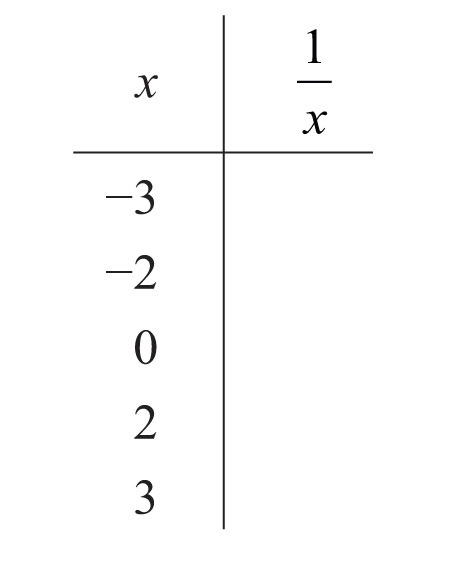
10. Fill in the following chart:
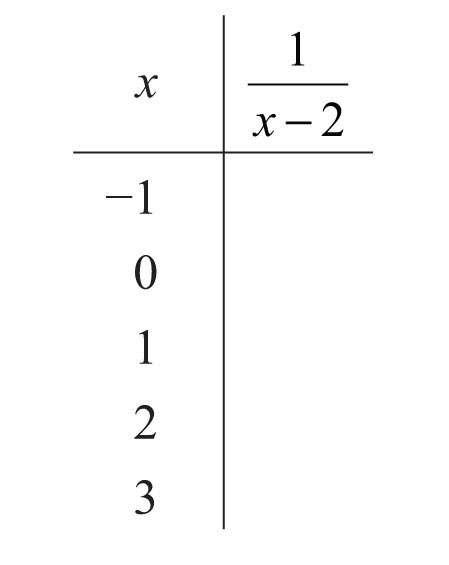
11. Fill in the following chart:

12. Fill in the following chart:
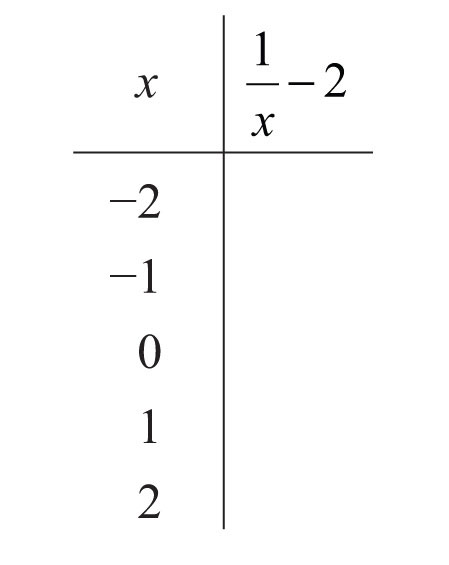
An object’s weight depends on its height above the surface of earth. If an object weighs 120 pounds on the surface of earth, then its weight in pounds, W, x miles above the surface is approximated by the formula
For each problem below, approximate the weight of a 120-pound object at the given height above the surface of earth. (1 mile = 5,280 feet)
13. 100 miles
14. 1,000 miles
15. 44,350 feet
16. 90,000 feet
The price to earnings ratio (P/E) is a metric used to compare the valuations of similar publicly traded companies. The P/E ratio is calculated using the stock price and the earnings per share (EPS) over the previous 12‑month period as follows:
If each share of a company stock is priced at $22.40, then calculate the P/E ratio given the following values for the earnings per share.
17. $1.40
18. $1.21
19. What happens to the P/E ratio when earnings decrease?
20. What happens to the P/E ratio when earnings increase?
State the restrictions to the domain.
21.
22.
23.
24.
25.
26.
27.
28.
29.
30.
31.
32.
33.
34.
Part B: Simplifying Rational Expressions
State the restrictions and then simplify.
35.
36.
37.
38.
39.
40.
41.
42.
43.
44.
45.
46.
47.
48.
49.
50.
51.
52.
53.
54.
Part C: Simplifying Rational Expressions with Opposite Binomial Factors
State the restrictions and then simplify.
55.
56.
57.
58.
59.
60.
61.
62.
63.
64.
65.
66.
67.
68.
69.
70.
71.
72.
Simplify. (Assume all denominators are nonzero.)
73.
74.
75.
76.
77.
78.
79.
80.
81.
82.
83.
84.
Part D: Rational Functions
Calculate the following.
85. ; , ,
86. ; , ,
87. ; , ,
88. ; , ,
89. ; , ,
90. ; , ,
State the restrictions to the domain and then simplify.
91.
92.
93.
94.
95.
96.
97. The cost in dollars of producing coffee mugs with a company logo is given by , where x represents the number of mugs produced. Calculate the average cost of producing 100 mugs and the average cost of producing 500 mugs.
98. The cost in dollars of renting a moving truck for the day is given by , where x represents the number of miles driven. Calculate the average cost per mile if the truck is driven 250 miles in one day.
99. The cost in dollars of producing sweat shirts with a custom design on the back is given by , where x represents the number of sweat shirts produced. Calculate the average cost of producing 150 custom sweat shirts.
100. The cost in dollars of producing a custom injected molded part is given by , where x represents the number of parts produced. Calculate the average cost of producing 1,000 custom parts.
Part E: Discussion Board
101. Explain why and illustrate this fact by substituting some numbers for the variables.
102. Explain why and illustrate this fact by substituting some numbers for the variables.
103. Explain why we cannot cancel x in the expression .
Answers
1: −5, undefined, 5
3: −1, undefined, 1/9
5: 0, undefined, 0
7: Undefined, −5/9, undefined
9:
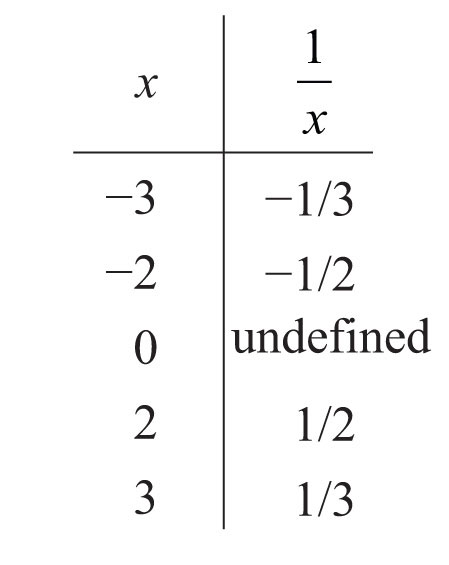
11:
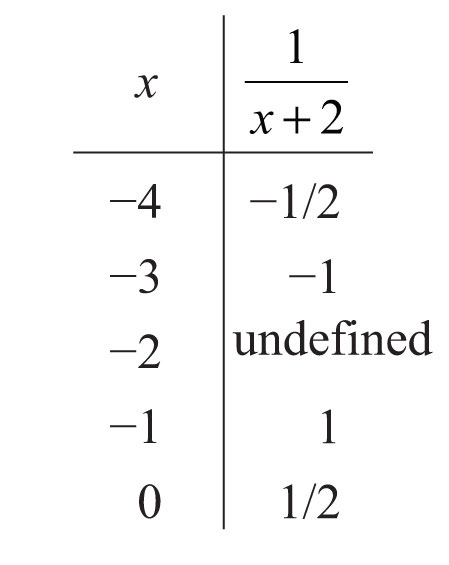
13: 114 pounds
15: 119.5 pounds
17: 16
19: The P/E ratio increases.
21:
23:
25:
27: and
29:
31: , , and
33: and
35: ;
37: ;
39: ;
41: ;
43: ;
45: ;
47: ;
49: ;
51: ;
53: ;
55: −1;
57: 1;
59: ;
61: ;
63: ;
65: ;
67: ;
69: ; none
71: ;
73:
75:
77:
79:
81:
83:
85: , ,
87: , undefined,
89: , ,
91: ;
93: ;
95: ;
97: The average cost of producing 100 mugs is $1.40 per mug. The average cost of producing 500 mugs is $1.08 per mug.
99: $12.50
7.2 Multiplying and Dividing Rational Expressions
Learning Objectives
- Multiply rational expressions.
- Divide rational expressions.
- Multiply and divide rational functions.
Multiplying Rational Expressions
When multiplying fractions, we can multiply the numerators and denominators together and then reduce, as illustrated:

Multiplying rational expressions is performed in a similar manner. For example,

In general, given polynomials P, Q, R, and S, where and , we have

In this section, assume that all variable expressions in the denominator are nonzero unless otherwise stated.
Example 1: Multiply: .
Solution: Multiply numerators and denominators and then cancel common factors.
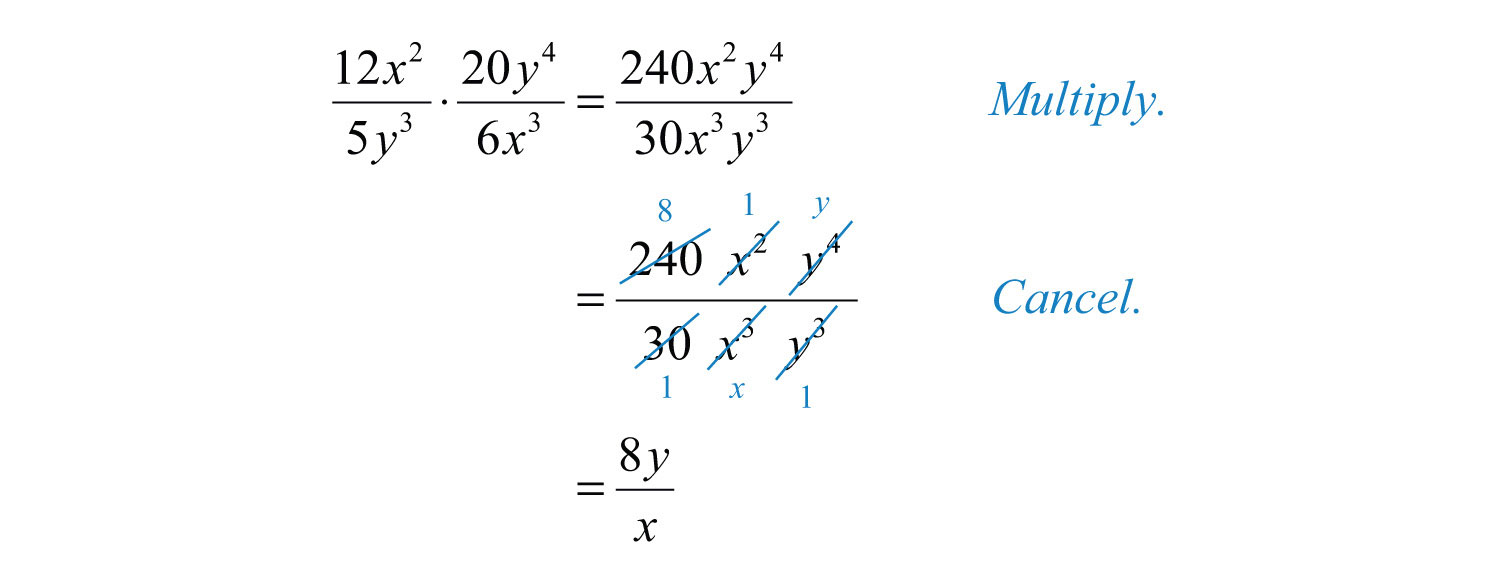
Answer:
Example 2: Multiply: .
Solution: Leave the product in factored form and cancel the common factors.

Answer:
Example 3: Multiply: .
Solution: Leave the polynomials in the numerator and denominator factored so that we can cancel the factors. In other words, do not apply the distributive property.
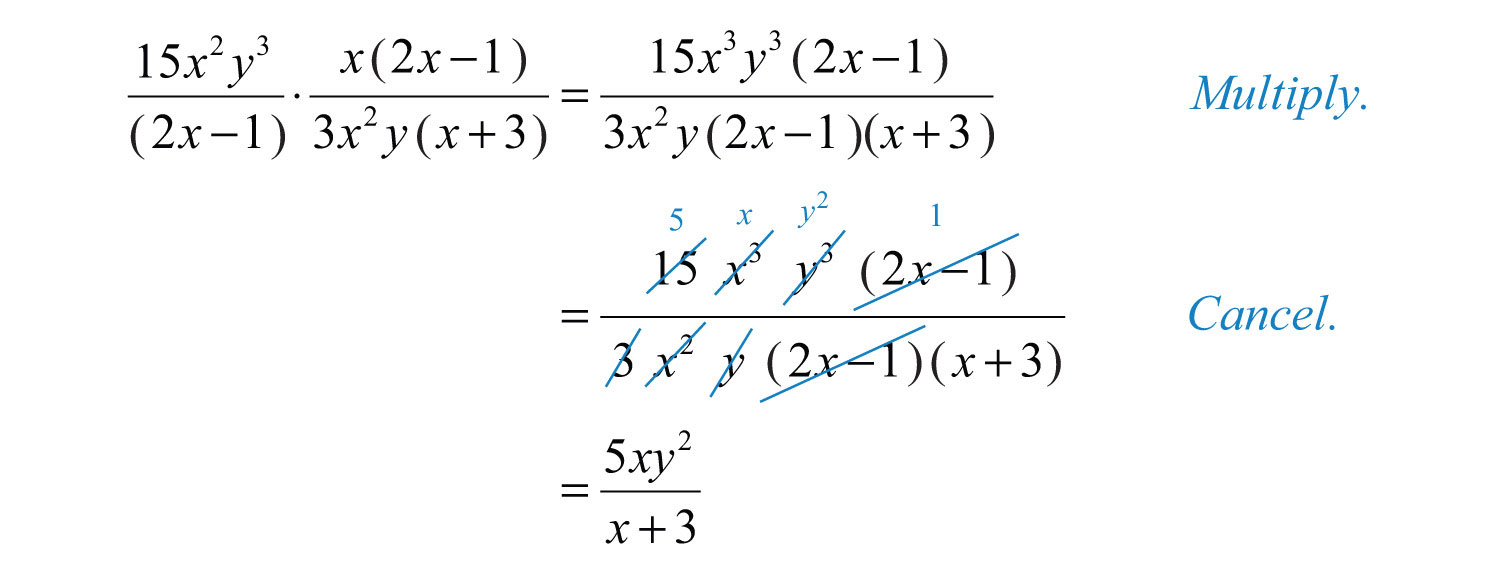
Answer:
Typically, rational expressions will not be given in factored form. In this case, first factor all numerators and denominators completely. Next, multiply and cancel any common factors, if there are any.
Example 4: Multiply: .
Solution: Factor the denominator as a difference of squares. Then multiply and cancel.
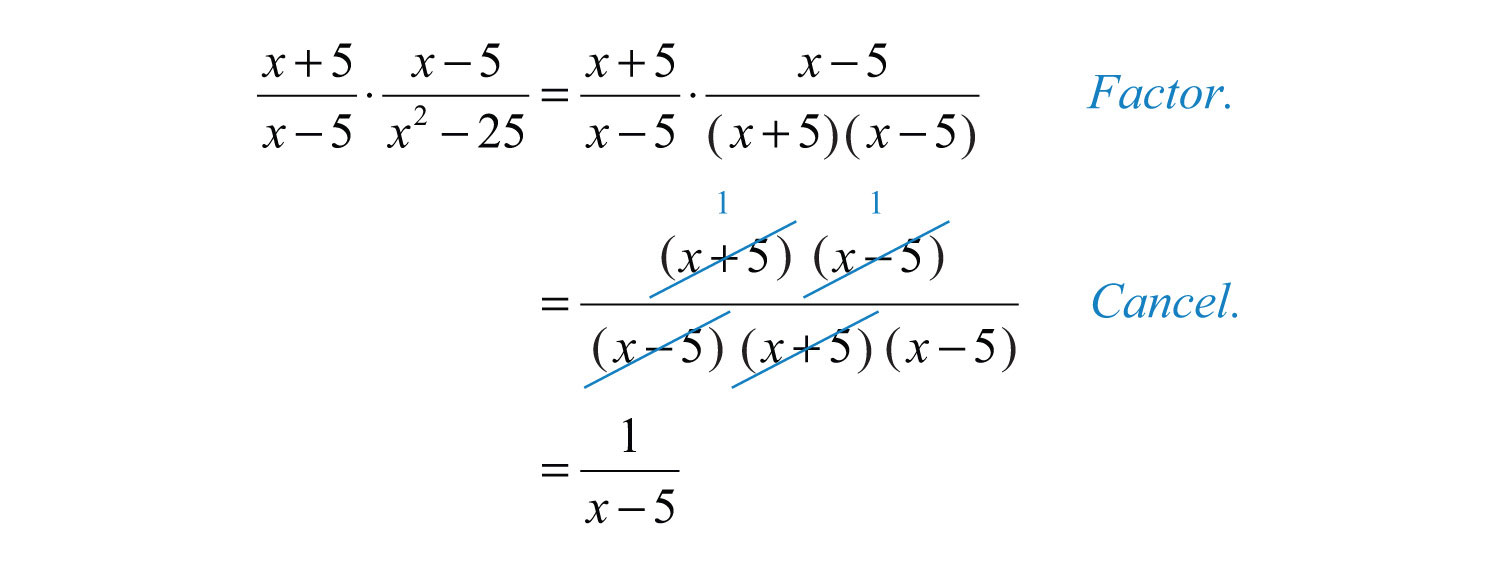
Keep in mind that 1 is always a factor; so when the entire numerator cancels out, make sure to write the factor 1.
Answer:
Example 5: Multiply: .
Solution:
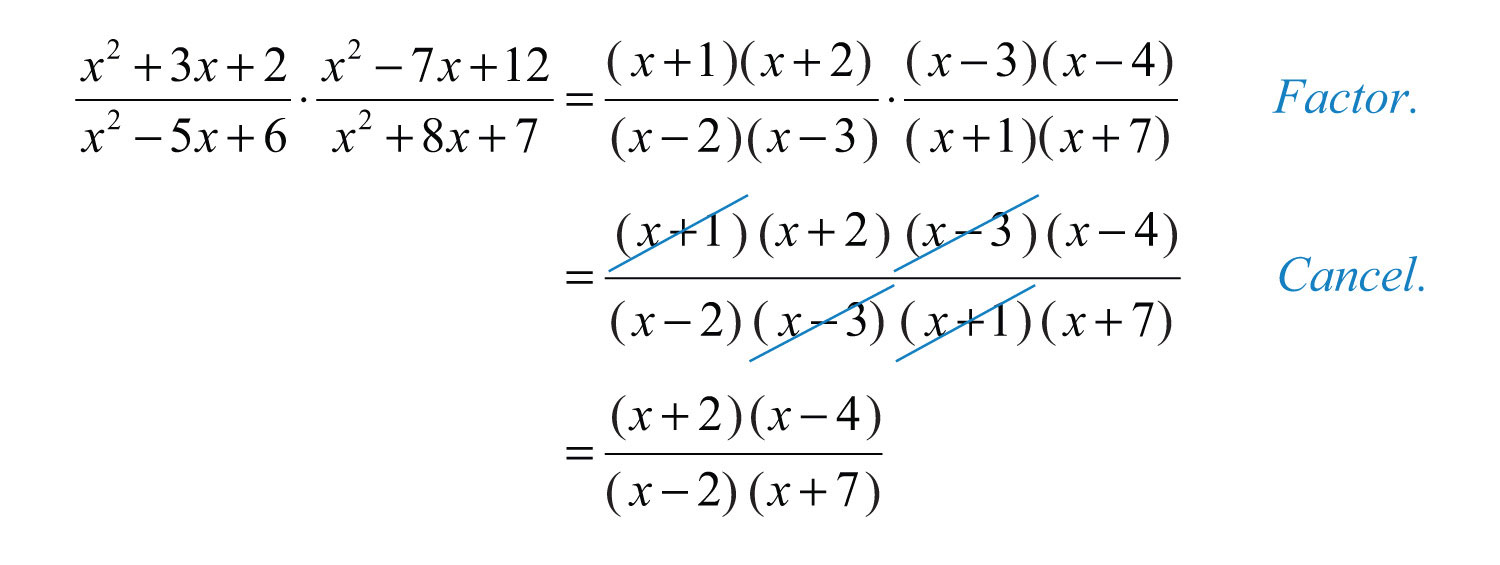
It is a best practice to leave the final answer in factored form.
Answer:
Example 6: Multiply: .
Solution: The trinomial in the numerator has a negative leading coefficient. Recall that it is a best practice to first factor out a −1 and then factor the resulting trinomial.
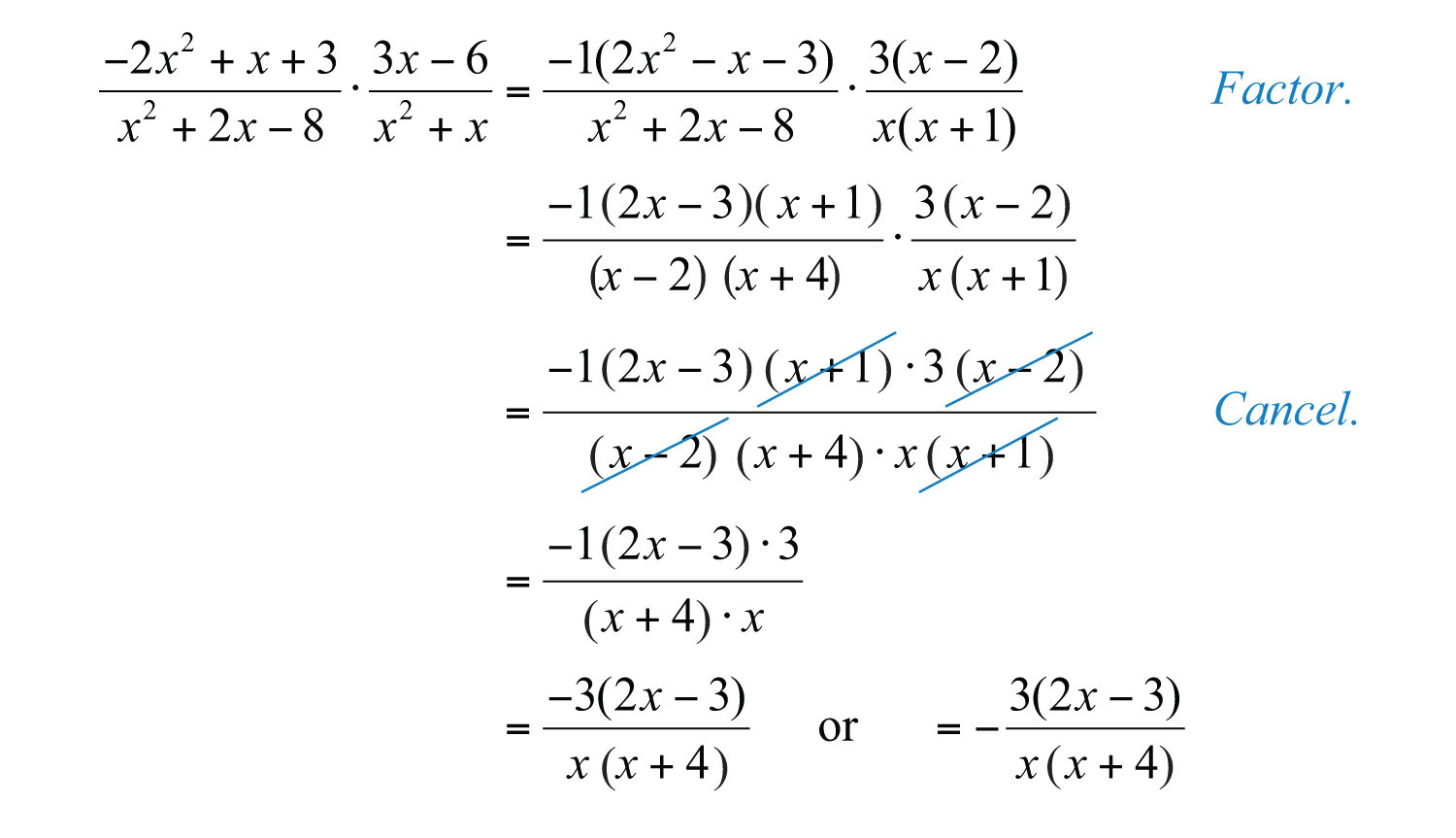
Answer:
Example 7: Multiply: .
Solution: We replace with so that we can cancel this factor.

Answer:
Try this! Multiply: .
Answer:
Video Solution
(click to see video)Dividing Rational Expressions
To divide two fractions, we multiply by the reciprocal of the divisor, as illustrated:

Dividing rational expressions is performed in a similar manner. For example,

In general, given polynomials P, Q, R, and S, where , , and , we have

Example 8: Divide: .
Solution: First, multiply by the reciprocal of the divisor and then cancel.
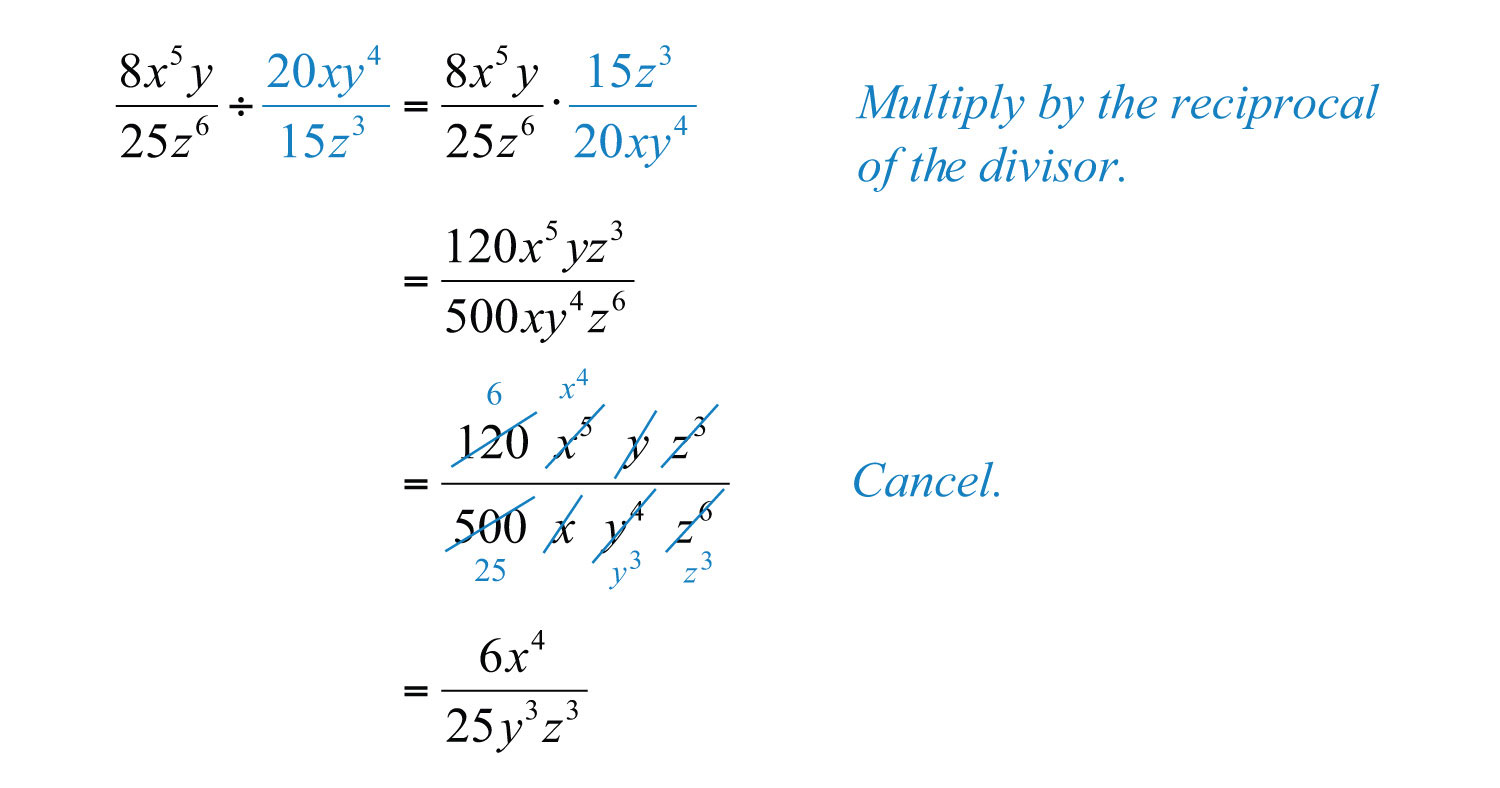
Answer:
Example 9: Divide: .
Solution: After multiplying by the reciprocal of the divisor, factor and cancel.
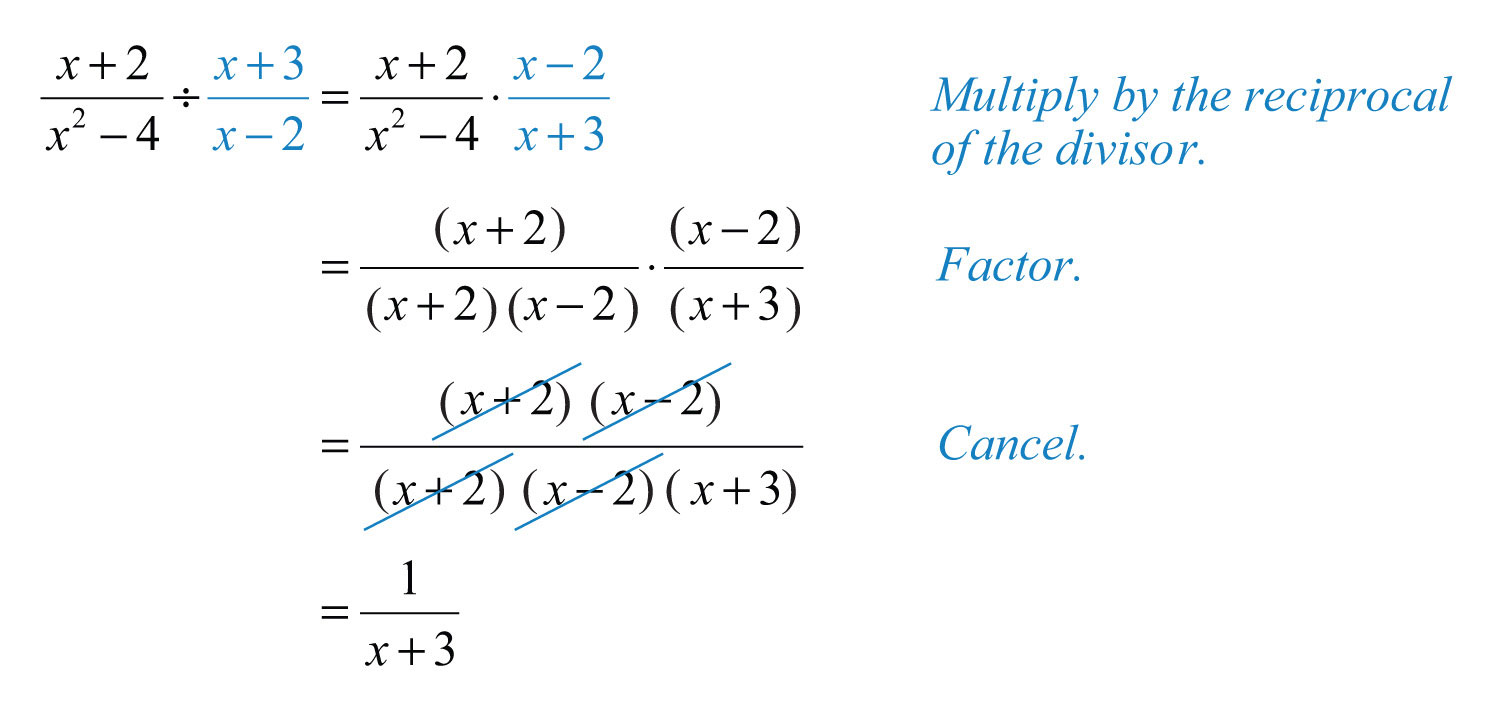
Answer:
Example 10: Divide: .
Solution: Begin by multiplying by the reciprocal of the divisor. After doing so, factor and cancel.
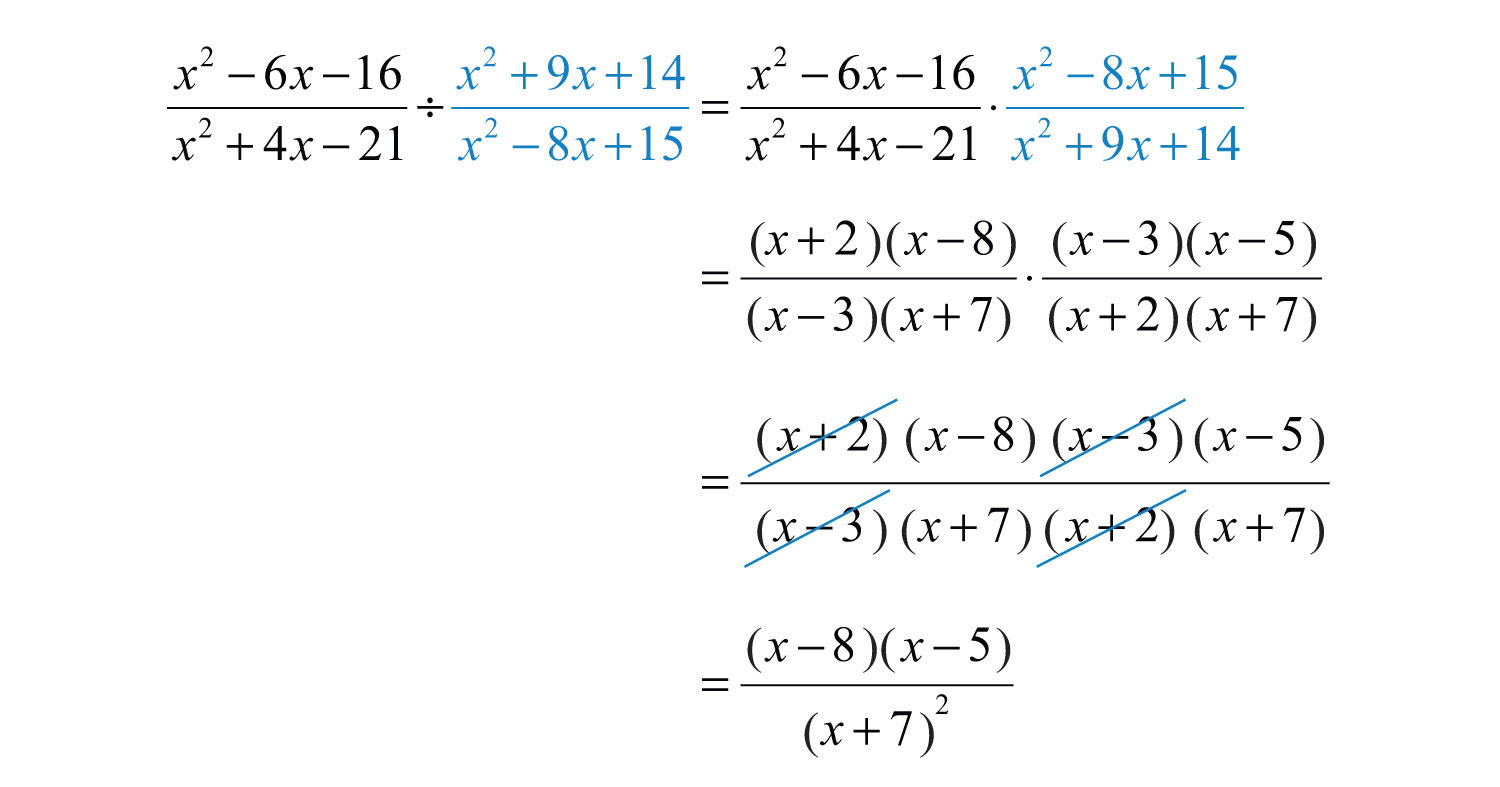
Answer:
Example 11: Divide: .
Solution: Just as we do with fractions, think of the divisor as an algebraic fraction over 1.
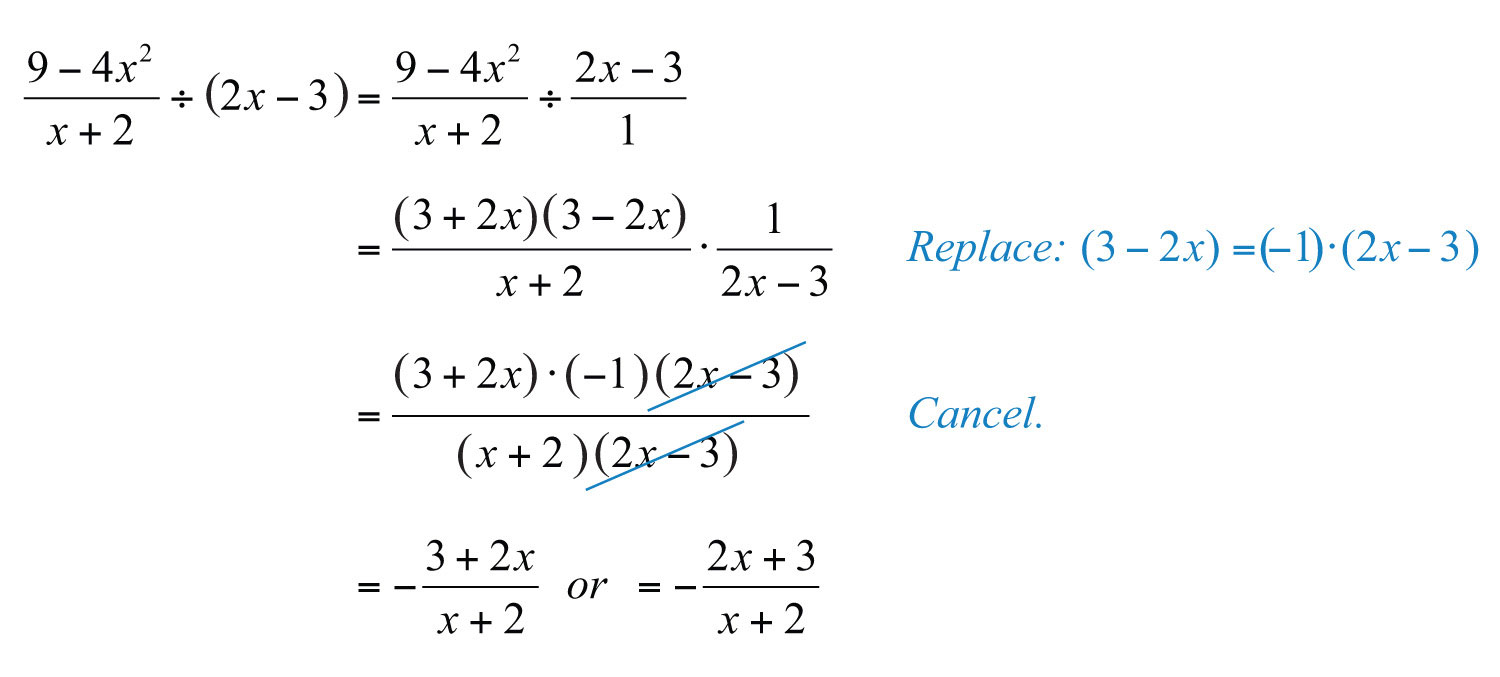
Answer:
Try this! Divide: .
Answer:
Video Solution
(click to see video)Multiplying and Dividing Rational Functions
The product and quotient of two rational functions can be simplified using the techniques described in this section. The restrictions to the domain of a product consist of the restrictions of each function.
Example 12: Calculate and determine the restrictions to the domain.

Solution: In this case, the domain of consists of all real numbers except 0, and the domain of consists of all real numbers except 1/4. Therefore, the domain of the product consists of all real numbers except 0 and 1/4. Multiply the functions and then simplify the result.
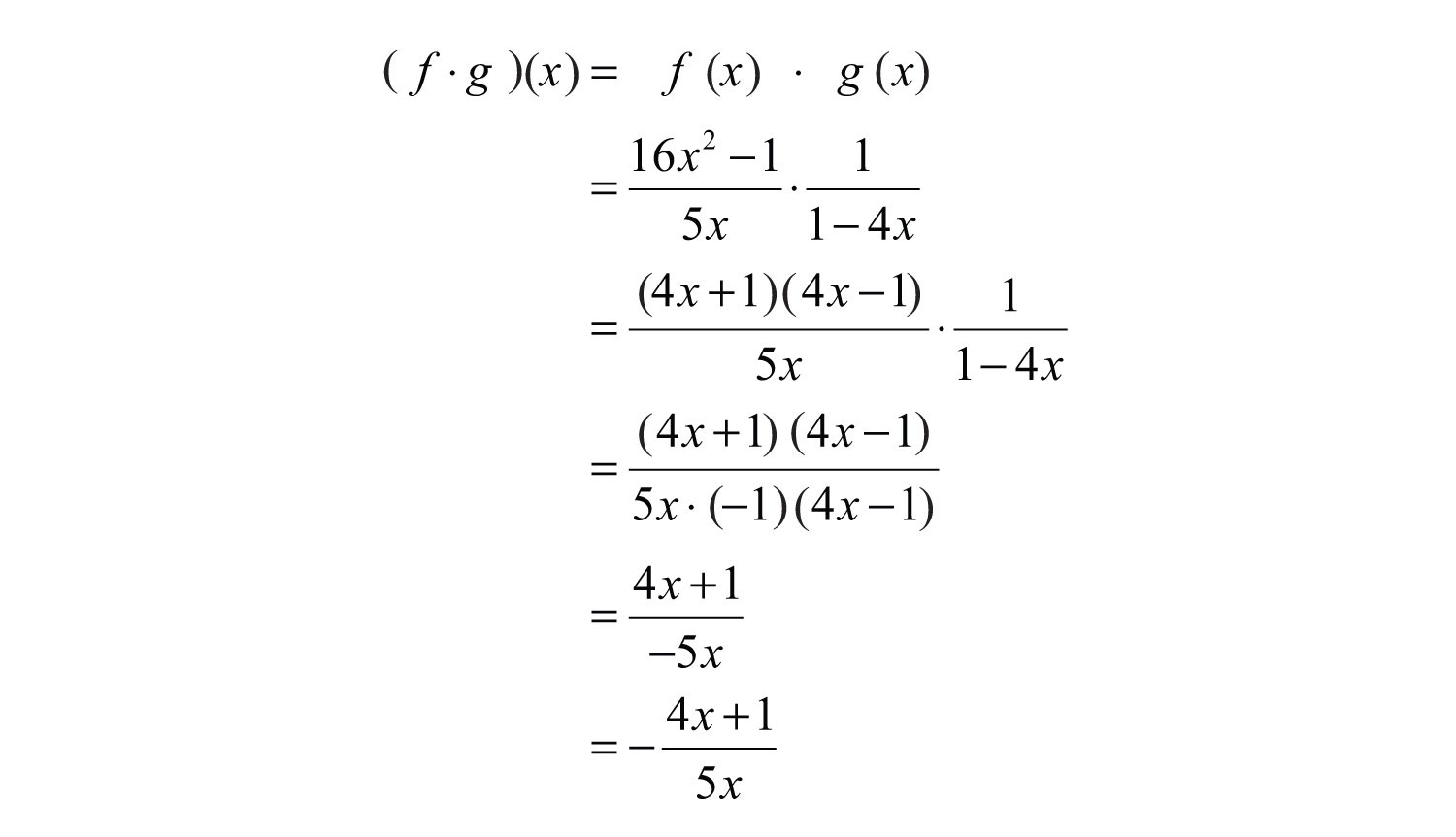
Answer: , where
The restrictions to the domain of a quotient will consist of the restrictions of each function as well as the restrictions on the reciprocal of the divisor.
Example 13: Calculate and determine the restrictions.

Solution:
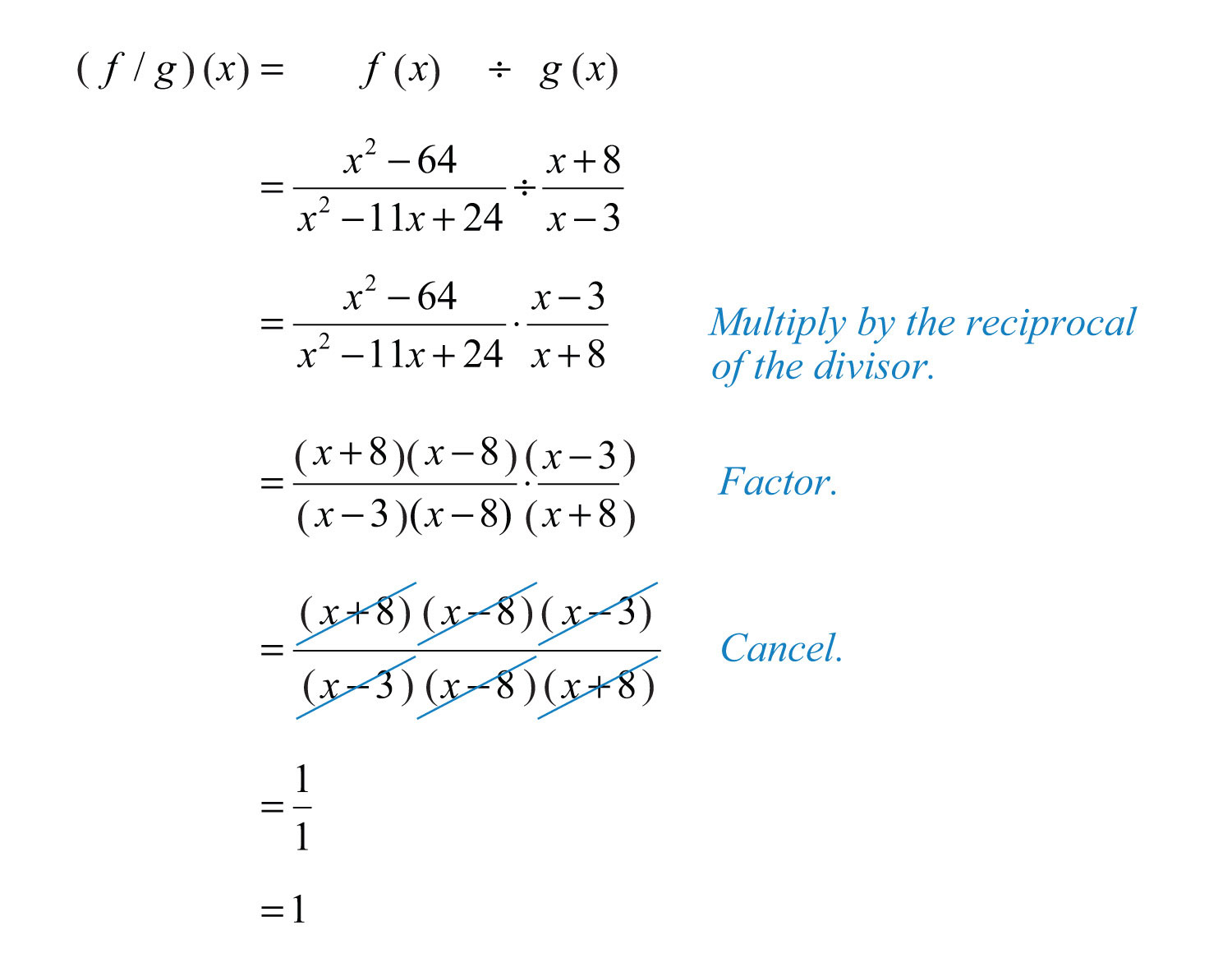
In this case, the domain of consists of all real numbers except 3 and 8, and the domain of consists all real numbers except 3. In addition, the reciprocal of has a restriction of −8. Therefore, the domain of this quotient consists of all real numbers except 3, 8, and −8.
Answer: , where
Key Takeaways
- After multiplying rational expressions, factor both the numerator and denominator and then cancel common factors. Make note of the restrictions to the domain. The values that give a value of 0 in the denominator are the restrictions.
- To divide rational expressions, multiply by the reciprocal of the divisor.
- The restrictions to the domain of a product consist of the restrictions to the domain of each factor.
- The restrictions to the domain of a quotient consist of the restrictions to the domain of each rational expression as well as the restrictions on the reciprocal of the divisor.
Topic Exercises
Part A: Multiplying Rational Expressions
Multiply. (Assume all denominators are nonzero.)
1.
2.
3.
4.
5.
6.
7.
8.
9.
10.
11.
12.
13.
14.
15.
16.
17.
18.
19.
20.
21.
22.
23.
24.
25.
26.
Part B: Dividing Rational Expressions
Divide. (Assume all denominators are nonzero.)
27.
28.
29.
30.
31.
32.
33.
34.
35.
36.
37.
38.
39.
40.
41.
42.
43.
44.
45.
46.
47.
48.
49.
50.
51.
52.
53.
54.
55.
56.
57.
58.
Recall that multiplication and division are to be performed in the order they appear from left to right. Simplify the following.
59.
60.
61.
62.
63.
64.
Part C: Multiplying and Dividing Rational Functions
Calculate and determine the restrictions to the domain.
65. and
66. and
67. and
68. and
69. and
70. and
Calculate and state the restrictions.
71. and
72. and
73. and
74. and
75. and
76. and
Part D: Discussion Board Topics
77. In the history of fractions, who is credited for the first use of the fraction bar?
78. How did the ancient Egyptians use fractions?
79. Explain why is a restriction to .
Answers
1:
3:
5:
7:
9:
11:
13: −1
15:
17:
19:
21:
23:
25: 2/3
27:
29:
31:
33:
35:
37:
39:
41:
43:
45:
47:
49:
51:
53:
55:
57: −1/4
59:
61:
63:
65: ;
67: ;
69: ;
71: ;
73: ;
75: ;
7.3 Adding and Subtracting Rational Expressions
Learning Objectives
- Add and subtract rational expressions with common denominators.
- Add and subtract rational expressions with unlike denominators.
- Add and subtract rational functions.
Adding and Subtracting with Common Denominators
Adding and subtracting rational expressions is similar to adding and subtracting fractions. Recall that if the denominators are the same, we can add or subtract the numerators and write the result over the common denominator.

When working with rational expressions, the common denominator will be a polynomial. In general, given polynomials P, Q, and R, where , we have the following:

In this section, assume that all variable factors in the denominator are nonzero.
Example 1: Add: .
Solution: Add the numerators 3 and 7, and write the result over the common denominator, y.

Answer:
Example 2: Subtract: .
Solution: Subtract the numerators and 1, and write the result over the common denominator, .

Answer:
Example 3: Subtract: .
Solution: We use parentheses to remind us to subtract the entire numerator of the second rational expression.
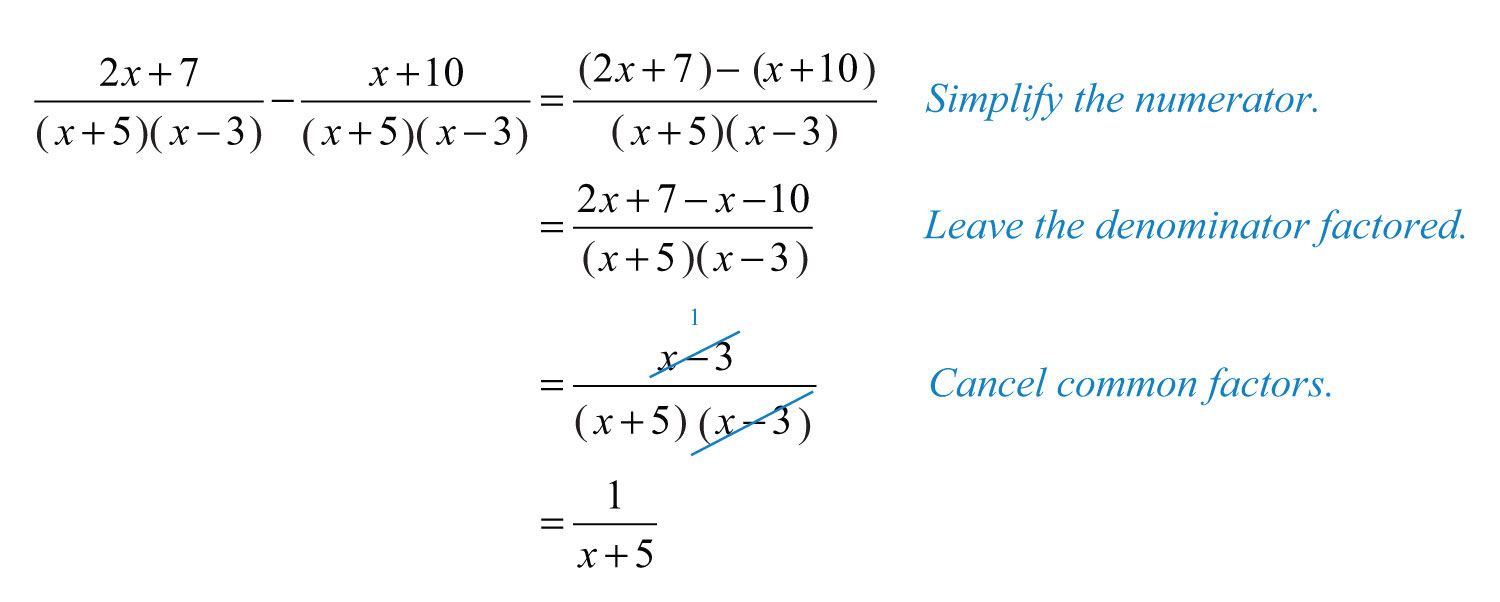
Answer:
Example 4: Simplify: .
Solution: Subtract and add the numerators. Make use of parentheses and write the result over the common denominator, .
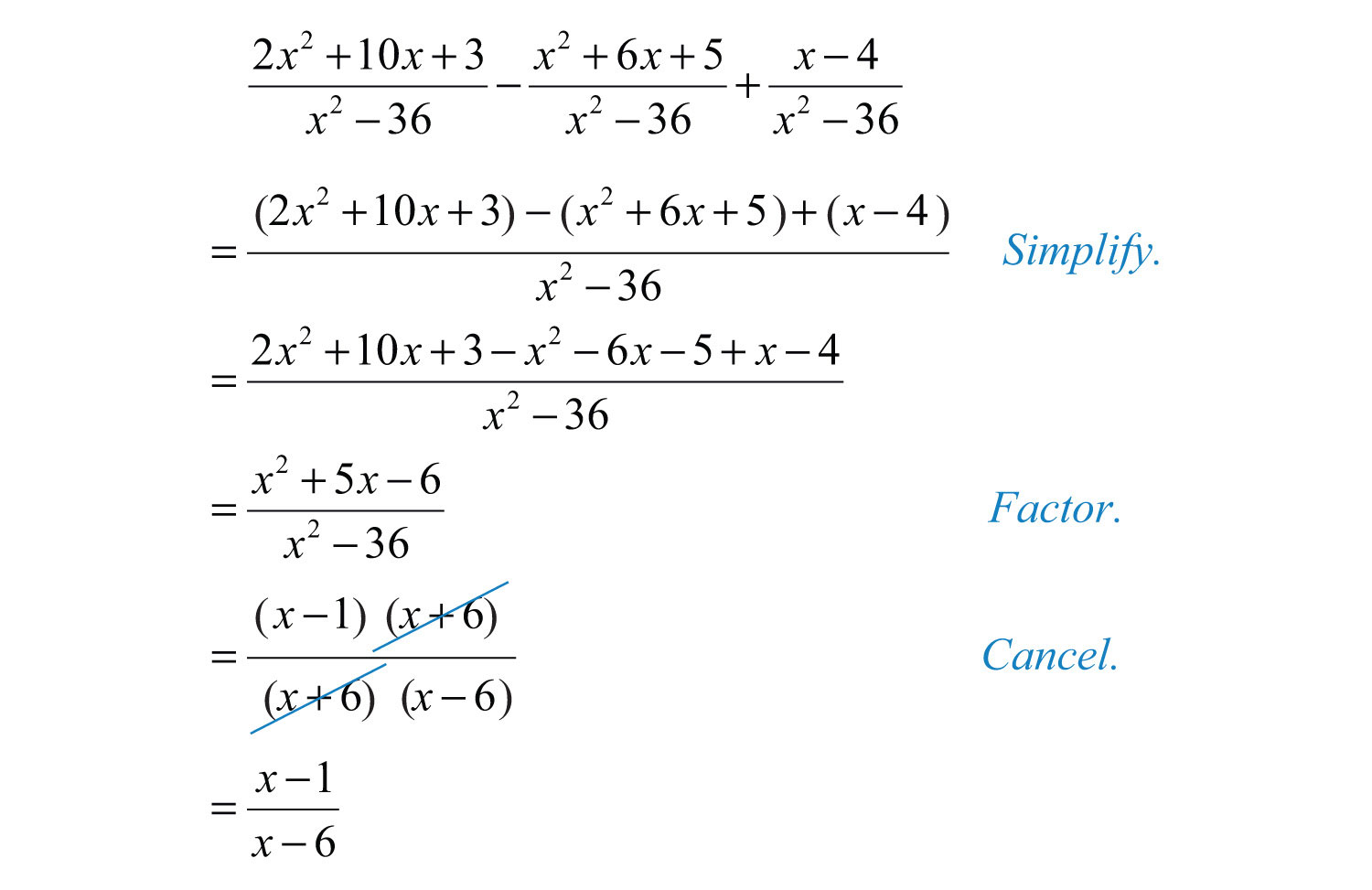
Answer:
Try this! Subtract: .
Answer:
Video Solution
(click to see video)Adding and Subtracting with Unlike Denominators
To add rational expressions with unlike denominators, first find equivalent expressions with common denominators. Do this just as you have with fractions. If the denominators of fractions are relatively prime, then the least common denominator (LCD) is their product. For example,

Multiply each fraction by the appropriate form of 1 to obtain equivalent fractions with a common denominator.
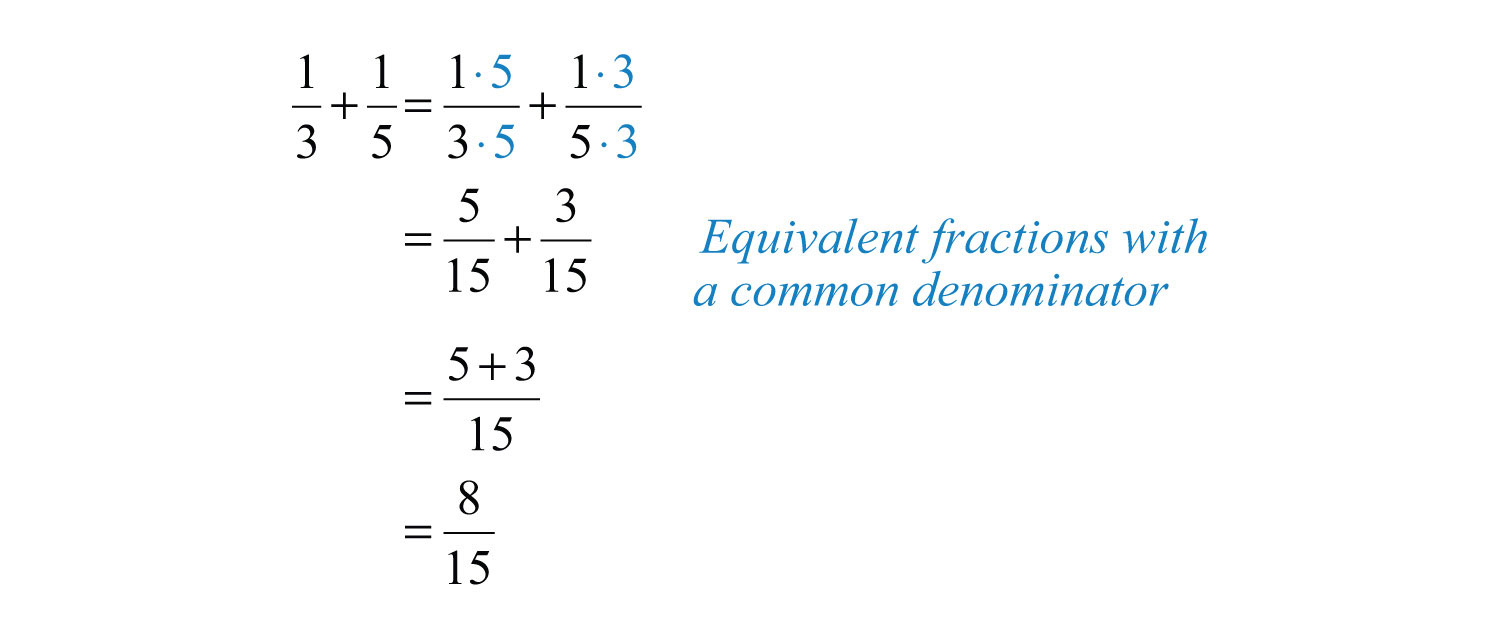
The process of adding and subtracting rational expressions is similar. In general, given polynomials P, Q, R, and S, where and , we have the following:

In this section, assume that all variable factors in the denominator are nonzero.
Example 5: Add: .
Solution: In this example, the . To obtain equivalent terms with this common denominator, multiply the first term by and the second term by .
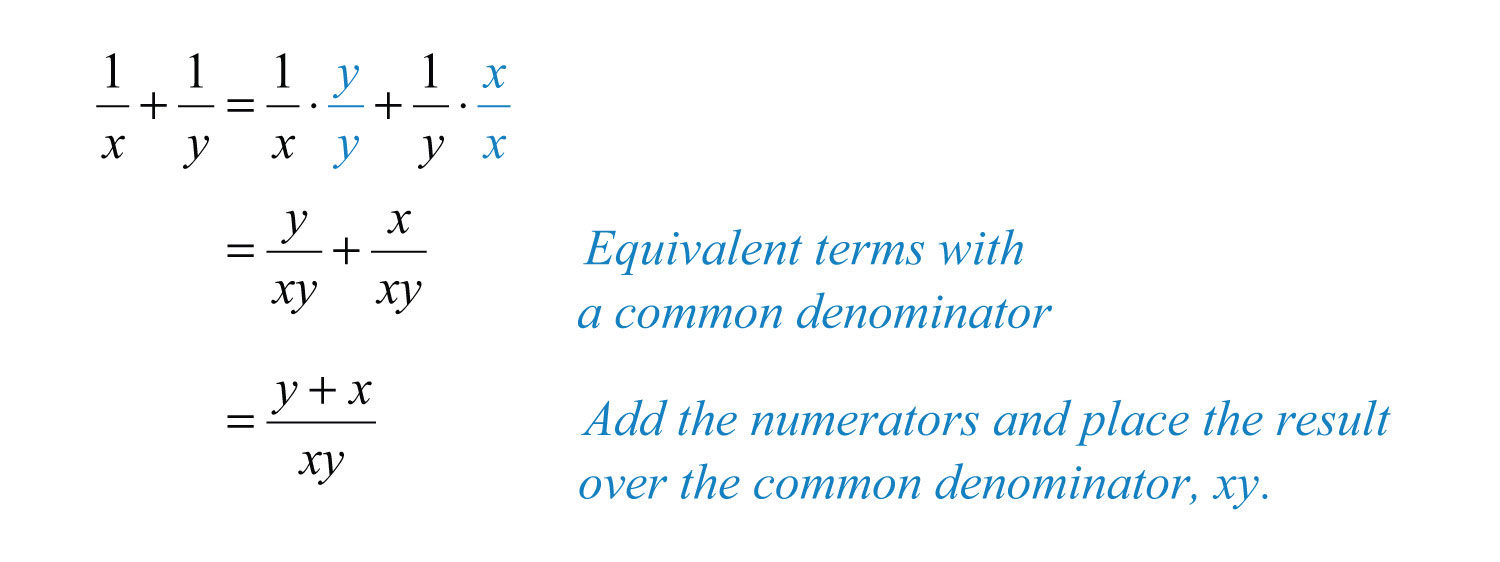
Answer:
Example 6: Subtract: .
Solution: Since the , multiply the first term by 1 in the form of and the second term by .
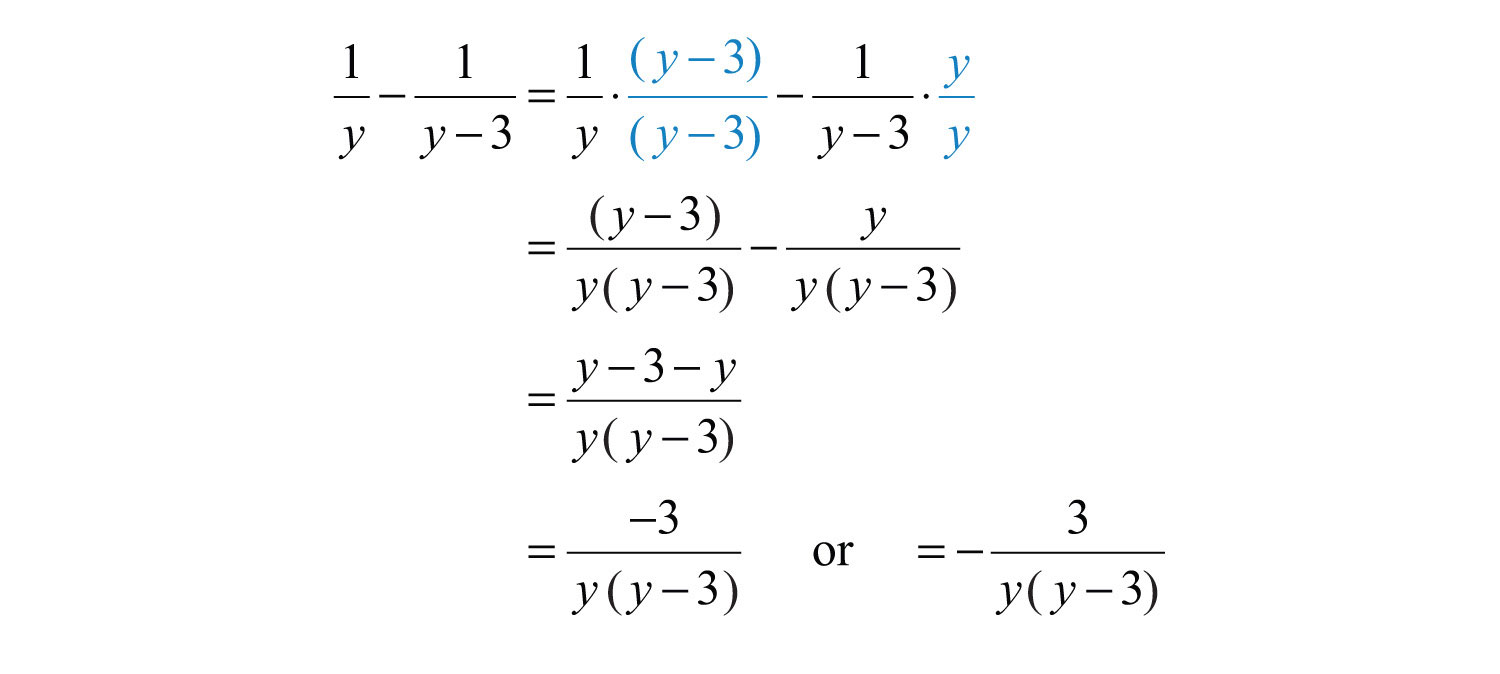
Answer:
It is not always the case that the LCD is the product of the given denominators. Typically, the denominators are not relatively prime; thus determining the LCD requires some thought. Begin by factoring all denominators. The LCD is the product of all factors with the highest power. For example, given

there are three base factors in the denominator: , , and . The highest powers of these factors are , , and . Therefore,

The general steps for adding or subtracting rational expressions are illustrated in the following example.
Example 7: Subtract: .
Solution:
Step 1: Factor all denominators to determine the LCD.

The .
Step 2: Multiply by the appropriate factors to obtain equivalent terms with a common denominator. To do this, multiply the first term by and the second term by .

Step 3: Add or subtract the numerators and place the result over the common denominator.

Step 4: Simplify the resulting algebraic fraction.
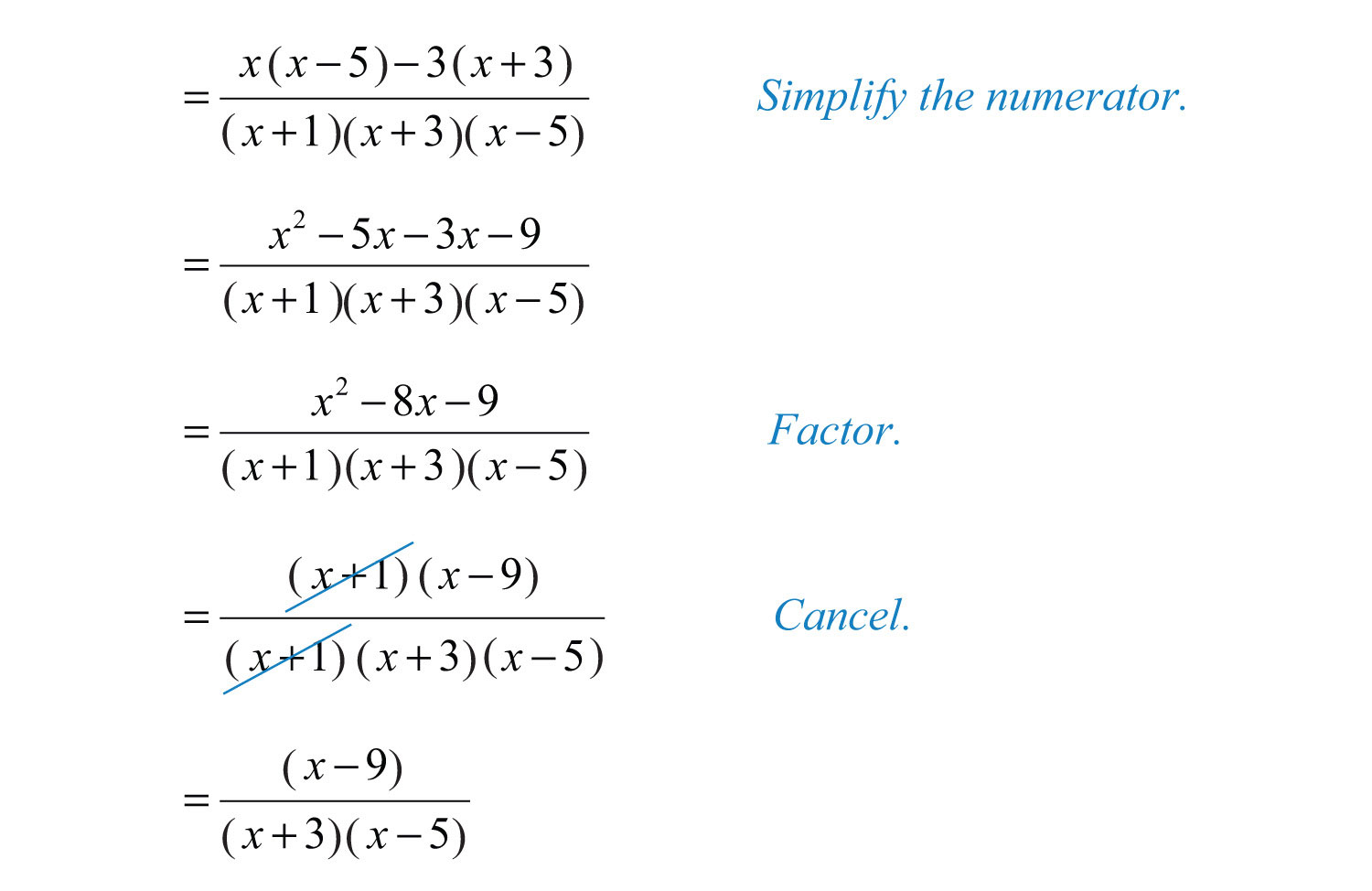
Answer:
Example 8: Subtract: .
Solution: It is best not to factor the numerator, , because we will most likely need to simplify after we subtract.
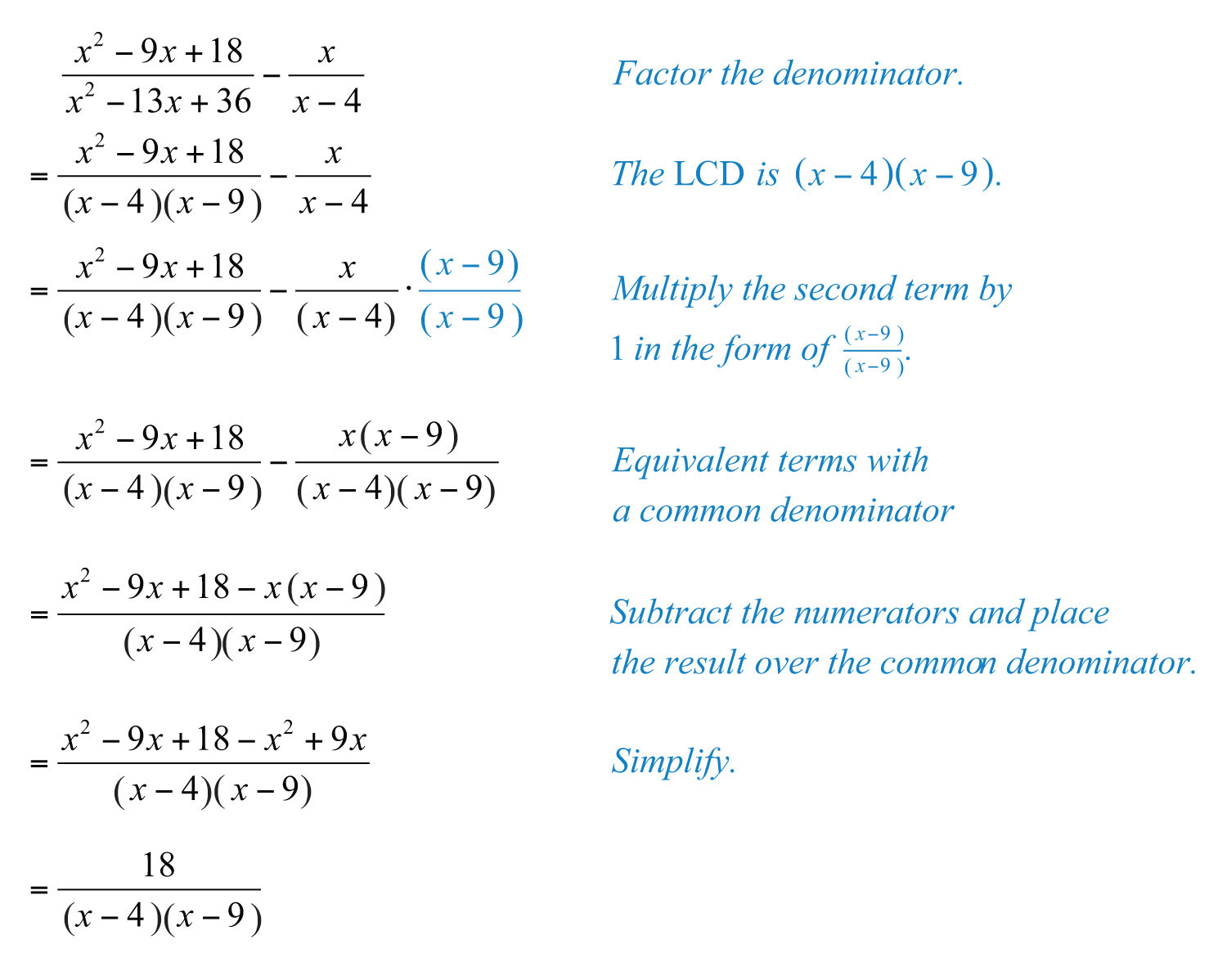
Answer:
Example 9: Subtract: .
Solution: First, factor the denominators and determine the LCD. Notice how the opposite binomial property is applied to obtain a more workable denominator.

The LCD is . Multiply the second term by 1 in the form of .

Now that we have equivalent terms with a common denominator, add the numerators and write the result over the common denominator.
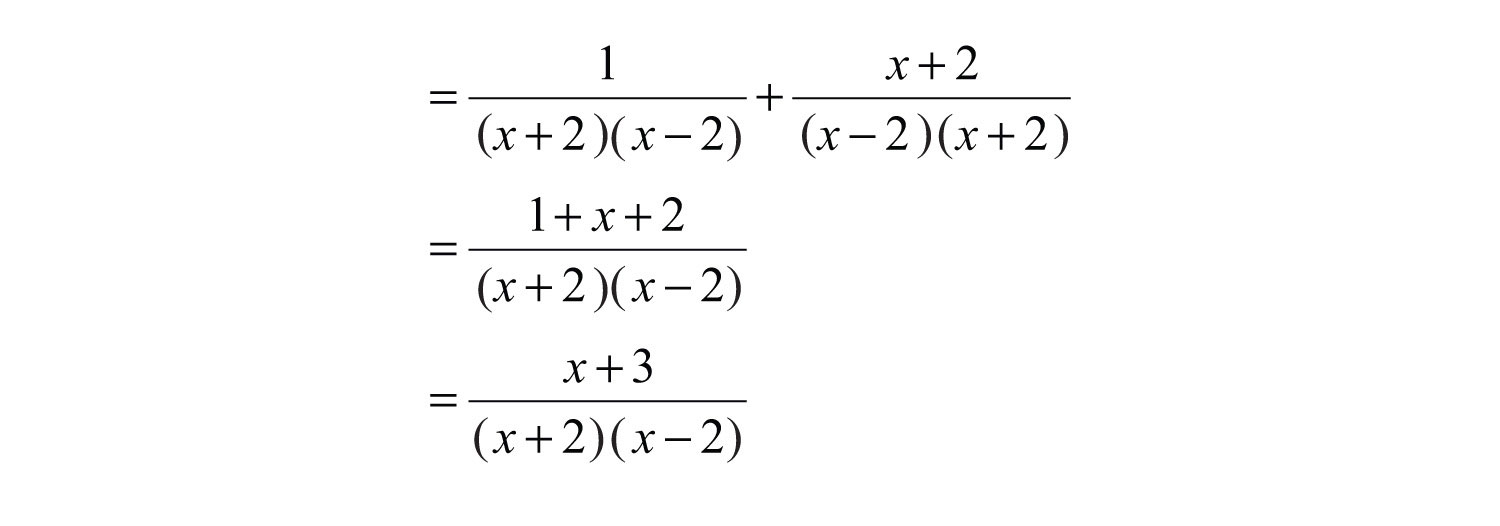
Answer:
Example 10: Simplify: .
Solution: Begin by factoring the denominator.

We can see that the . Find equivalent fractions with this denominator.

Next, subtract and add the numerators and place the result over the common denominator.

Finish by simplifying the resulting rational expression.
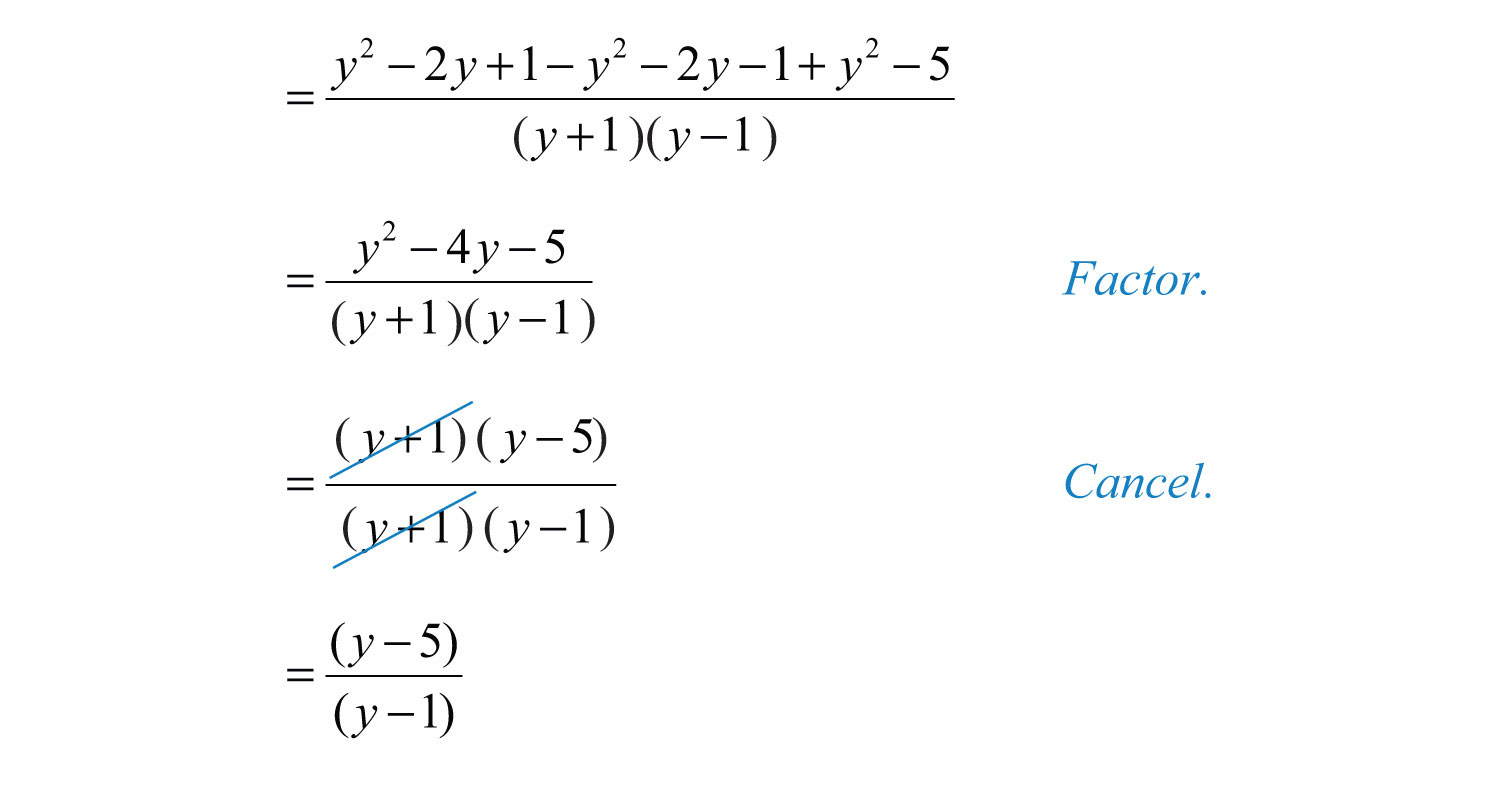
Answer:
Try this! Simplify: .
Answer:
Video Solution
(click to see video)Rational expressions are sometimes expressed using negative exponents. In this case, apply the rules for negative exponents before simplifying the expression.
Example 11: Simplify: .
Solution: Recall that . We begin by rewriting the negative exponents as rational expressions.
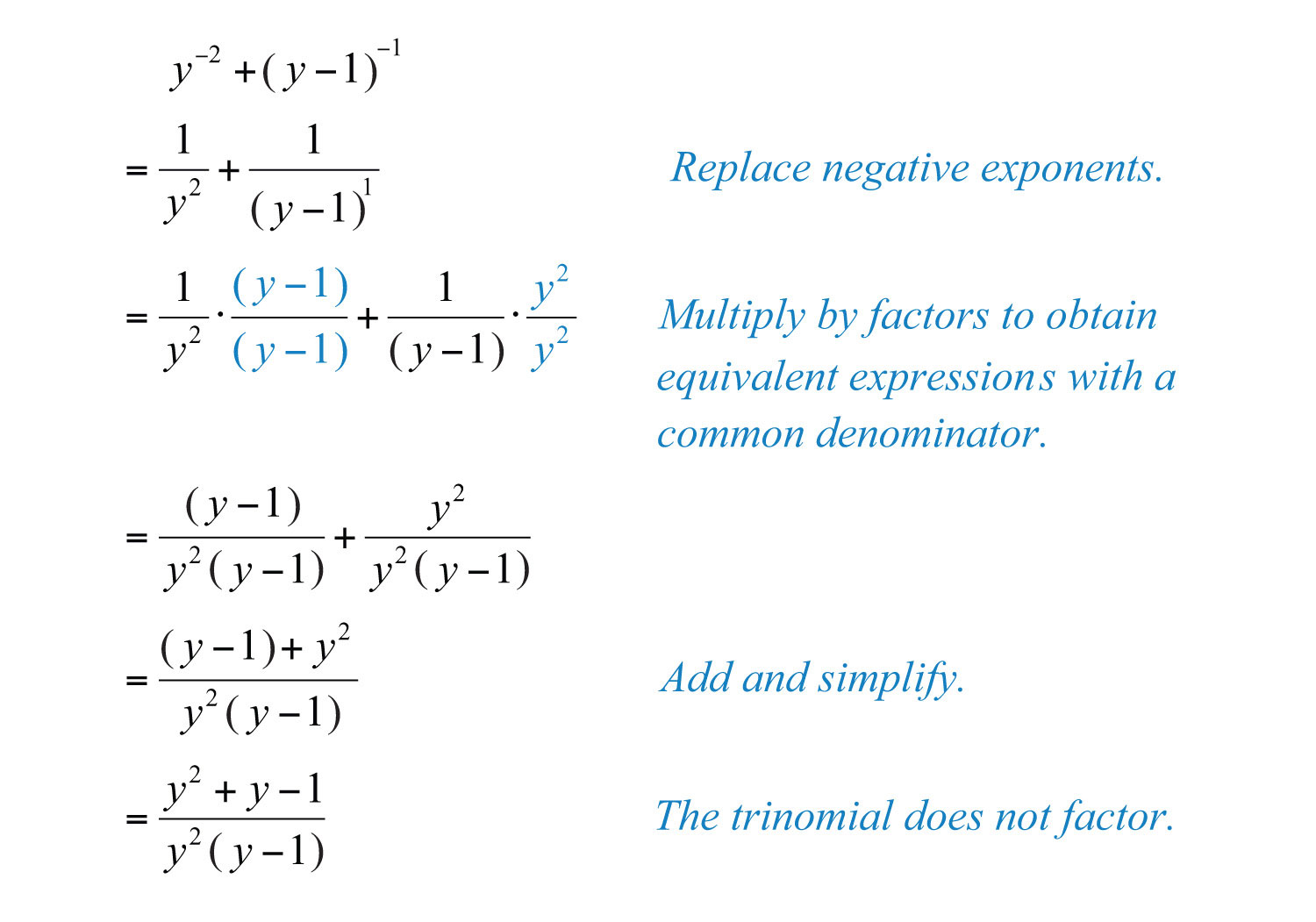
Answer:
Adding and Subtracting Rational Functions
We can simplify sums or differences of rational functions using the techniques learned in this section. The restrictions of the result consist of the restrictions to the domains of each function.
Example 12: Calculate , given and , and state the restrictions.
Solution:

Here the domain of f consists of all real numbers except −3, and the domain of g consists of all real numbers except 2. Therefore, the domain of f + g consists of all real numbers except −3 and 2.
Answer: , where
Example 13: Calculate , given and , and state the restrictions to the domain.
Solution:
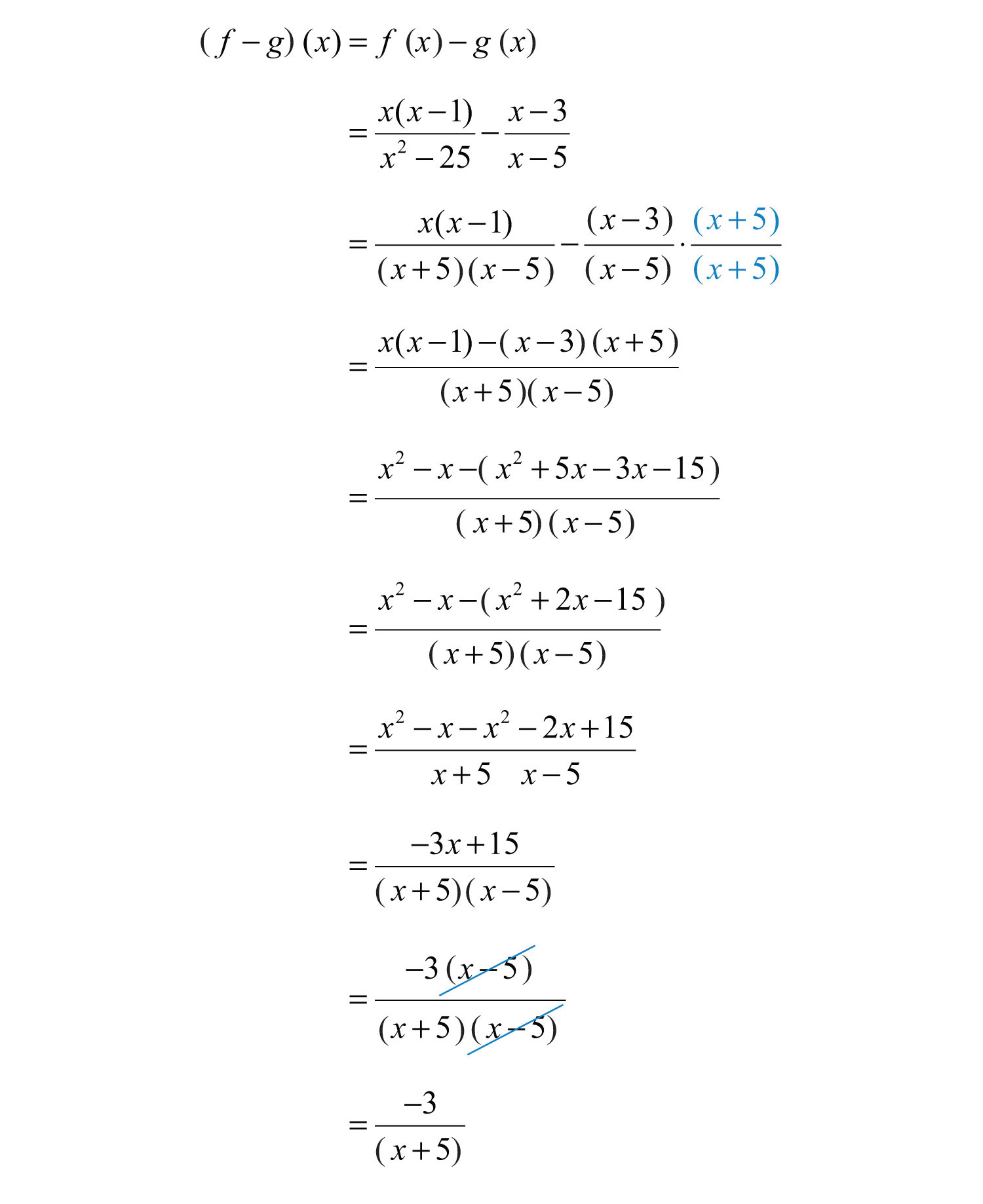
The domain of f consists of all real numbers except 5 and −5, and the domain of g consists of all real numbers except 5. Therefore, the domain of f − g consists of all real numbers except −5 and 5.
Answer: , where
Key Takeaways
- When adding or subtracting rational expressions with a common denominator, add or subtract the expressions in the numerator and write the result over the common denominator.
- To find equivalent rational expressions with a common denominator, first factor all denominators and determine the least common multiple. Then multiply numerator and denominator of each term by the appropriate factor to obtain a common denominator. Finally, add or subtract the expressions in the numerator and write the result over the common denominator.
- The restrictions to the domain of a sum or difference of rational functions consist of the restrictions to the domains of each function.
Topic Exercises
Part A: Adding and Subtracting with Common Denominators
Simplify. (Assume all denominators are nonzero.)
1.
2.
3.
4.
5.
6.
7.
8.
9.
10.
11.
12.
13.
14.
15.
16.
17.
18.
Part B: Adding and Subtracting with Unlike Denominators
Simplify. (Assume all denominators are nonzero.)
19.
20.
21.
22.
23.
24.
25.
26.
27.
28.
29.
30.
31.
32.
33.
34.
35.
36.
37.
38.
39.
40.
41.
42.
43.
44.
45.
46.
47.
48.
49.
50.
51.
52.
53.
54.
55.
56.
57.
58.
59.
60.
61.
62.
63.
64.
65.
66.
67.
68.
69.
70.
71.
72.
73.
74.
75.
76.
77.
78.
79.
80.
Part C: Adding and Subtracting Rational Functions
Calculate and and state the restrictions to the domain.
81. and
82. and
83. and
84. and
85. and
86. and
Calculate and state the restrictions to the domain.
87.
88.
89.
90.
Part D: Discussion Board
91. Explain to a classmate why this is incorrect: .
92. Explain to a classmate how to find the common denominator when adding algebraic expressions. Give an example.
Answers
1:
3:
5:
7: 1
9:
11:
13:
15:
17:
19:
21:
23:
25:
27:
29:
31:
33:
35:
37:
39:
41:
43:
45:
47:
49:
51:
53:
55:
57:
59:
61:
63:
65:
67:
69:
71:
73:
75:
77:
79:
81: ; ;
83: ; ;
85: ; ;
87: ;
89: ;
7.4 Complex Rational Expressions
Learning Objectives
- Simplify complex rational expressions by multiplying the numerator by the reciprocal of the divisor.
- Simplify complex rational expressions by multiplying numerator and denominator by the least common denominator (LCD).
Definitions
A complex fractionA fraction where the numerator or denominator consists of one or more fractions. is a fraction where the numerator or denominator consists of one or more fractions. For example,

Simplifying such a fraction requires us to find an equivalent fraction with integer numerator and denominator. One way to do this is to divide. Recall that dividing fractions involves multiplying by the reciprocal of the divisor.

An alternative method for simplifying this complex fraction involves multiplying both the numerator and denominator by the LCD of all the given fractions. In this case, the LCD = 4.

A complex rational expressionA rational expression where the numerator or denominator consists of one or more rational expressions. is defined as a rational expression that contains one or more rational expressions in the numerator or denominator or both. For example,

We simplify a complex rational expression by finding an equivalent fraction where the numerator and denominator are polynomials. As illustrated above, there are two methods for simplifying complex rational expressions, and we will outline the steps for both methods. For the sake of clarity, assume that variable expressions used as denominators are nonzero.
Method 1: Simplify Using Division
We begin our discussion on simplifying complex rational expressions using division. Before we can multiply by the reciprocal of the divisor, we must simplify the numerator and denominator separately. The goal is to first obtain single algebraic fractions in the numerator and the denominator. The steps for simplifying a complex algebraic fraction are illustrated in the following example.
Example 1: Simplify: .
Solution:
Step 1: Simplify the numerator and denominator. The goal is to obtain a single algebraic fraction divided by another single algebraic fraction. In this example, find equivalent terms with a common denominator in both the numerator and denominator before adding and subtracting.
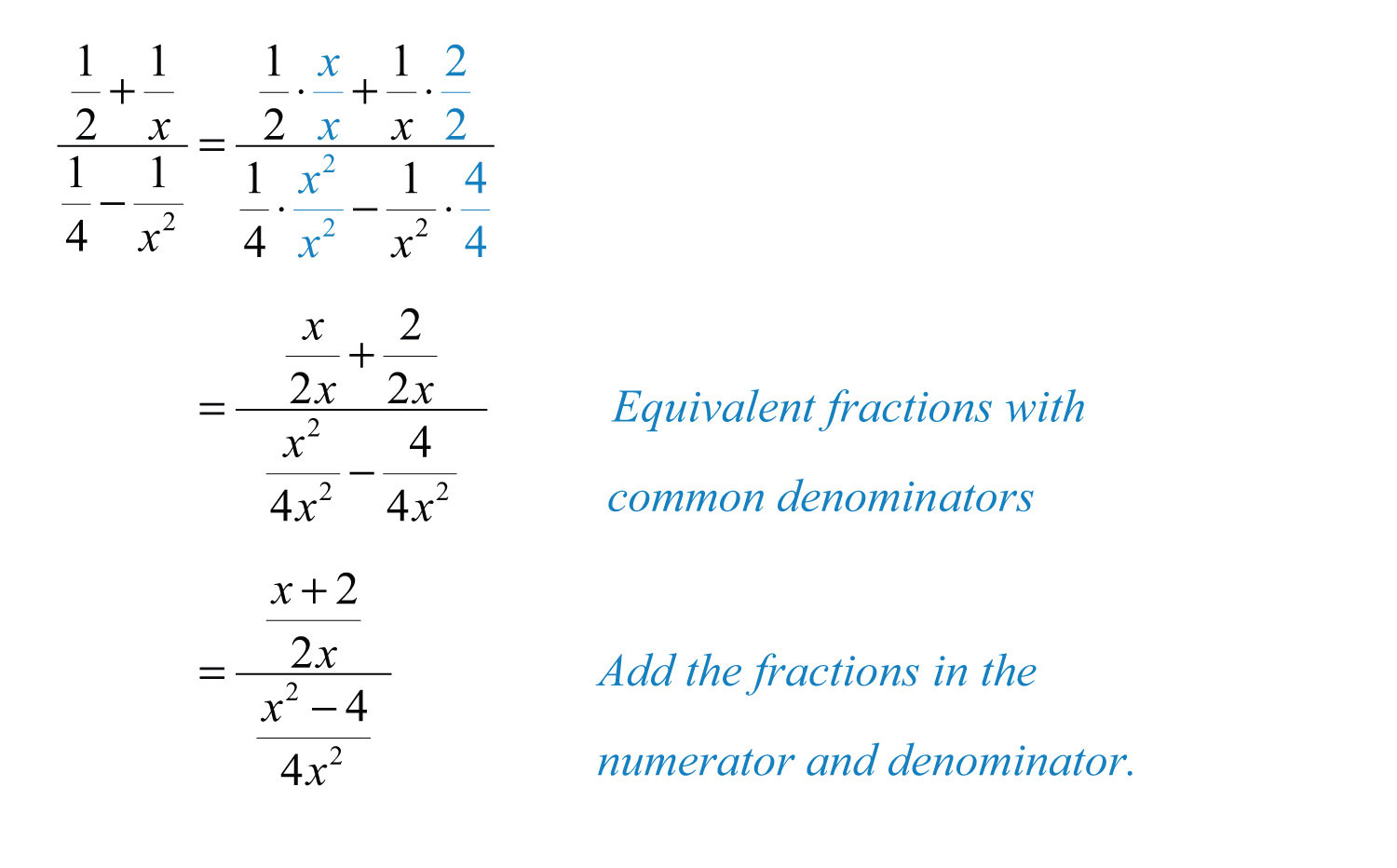
At this point we have a single algebraic fraction divided by a single algebraic fraction.
Step 2: Multiply the numerator by the reciprocal of the divisor.

Step 3: Factor all numerators and denominators completely.

Step 4: Cancel all common factors.
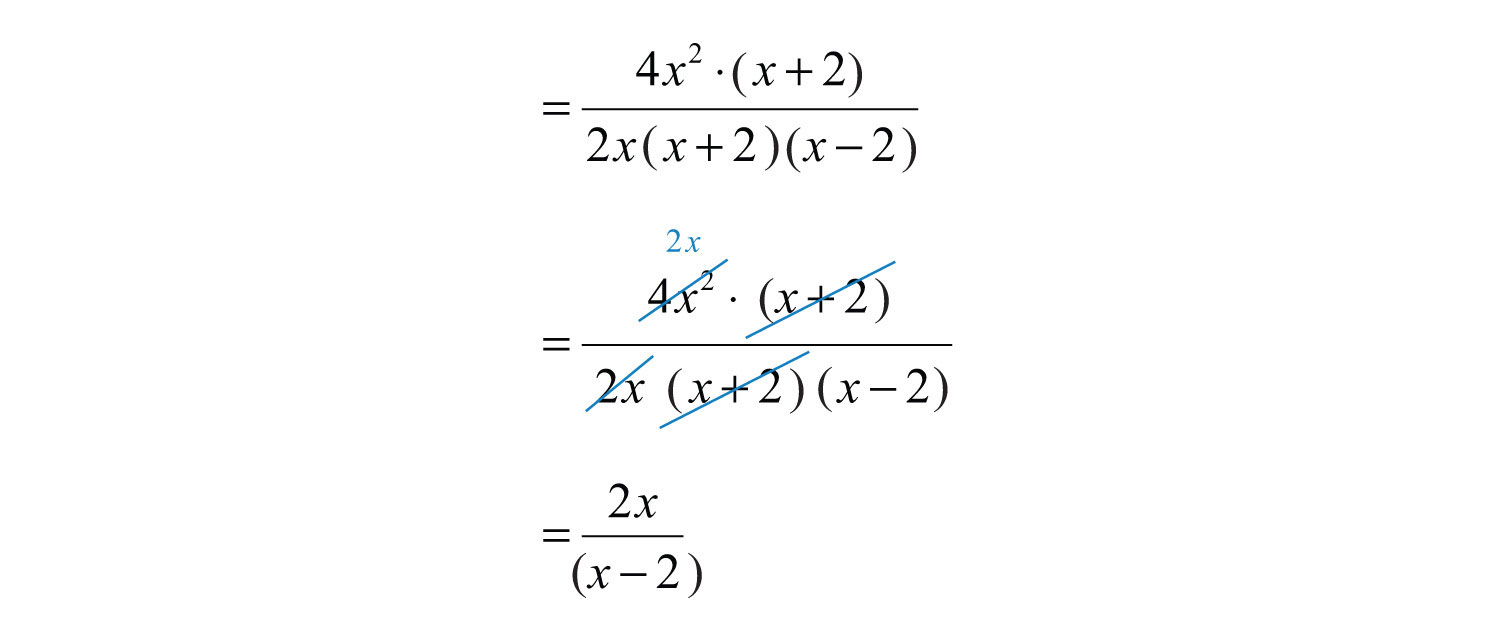
Answer:
Example 2: Simplify: .
Solution:
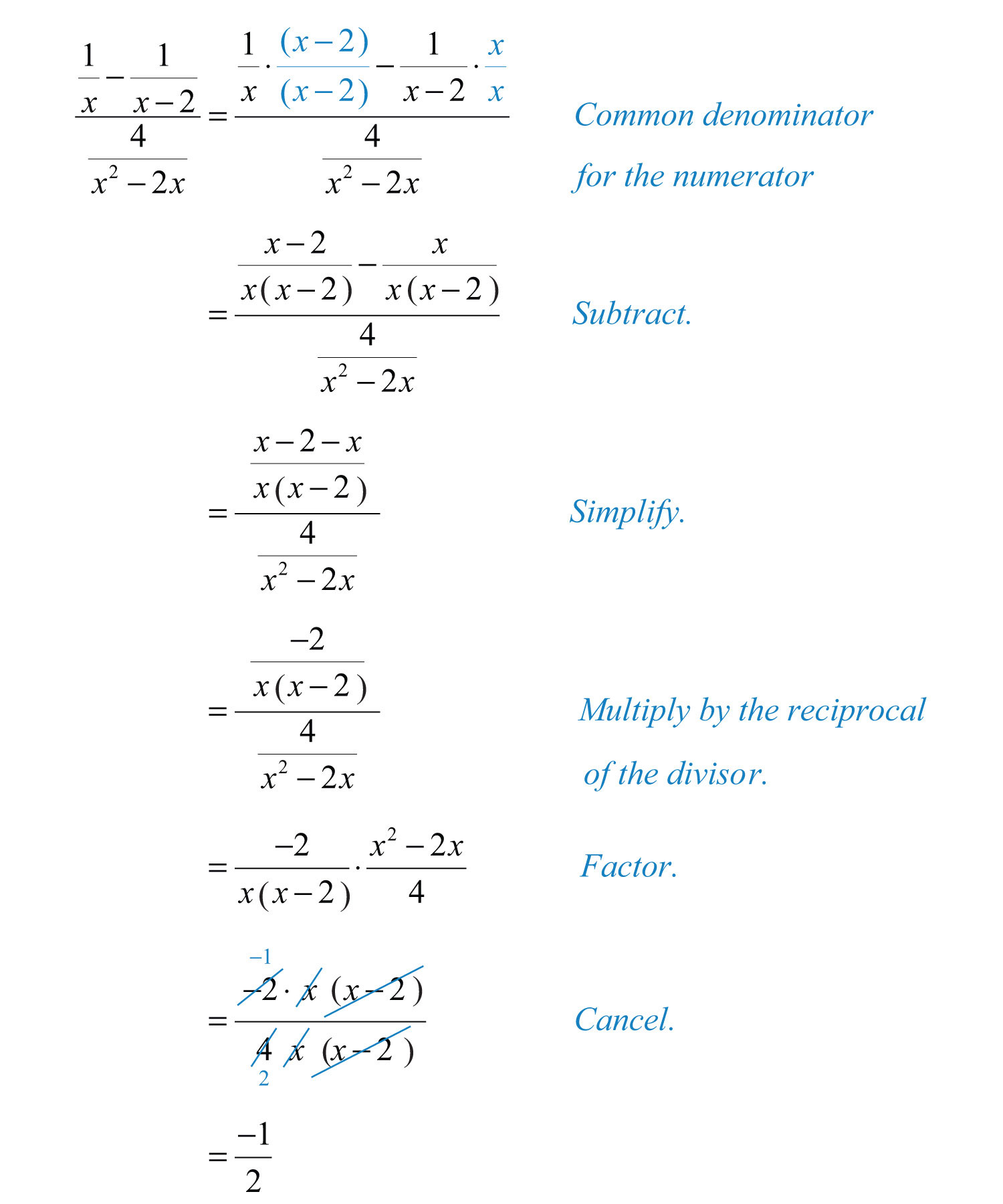
Answer:
Example 3: Simplify .
Solution: The LCD of the rational expressions in both the numerator and denominator is . Multiply by the appropriate factors to obtain equivalent terms with this as the denominator and then subtract.

We now have a single rational expression divided by another single rational expression. Next, multiply the numerator by the reciprocal of the divisor and then factor and cancel.
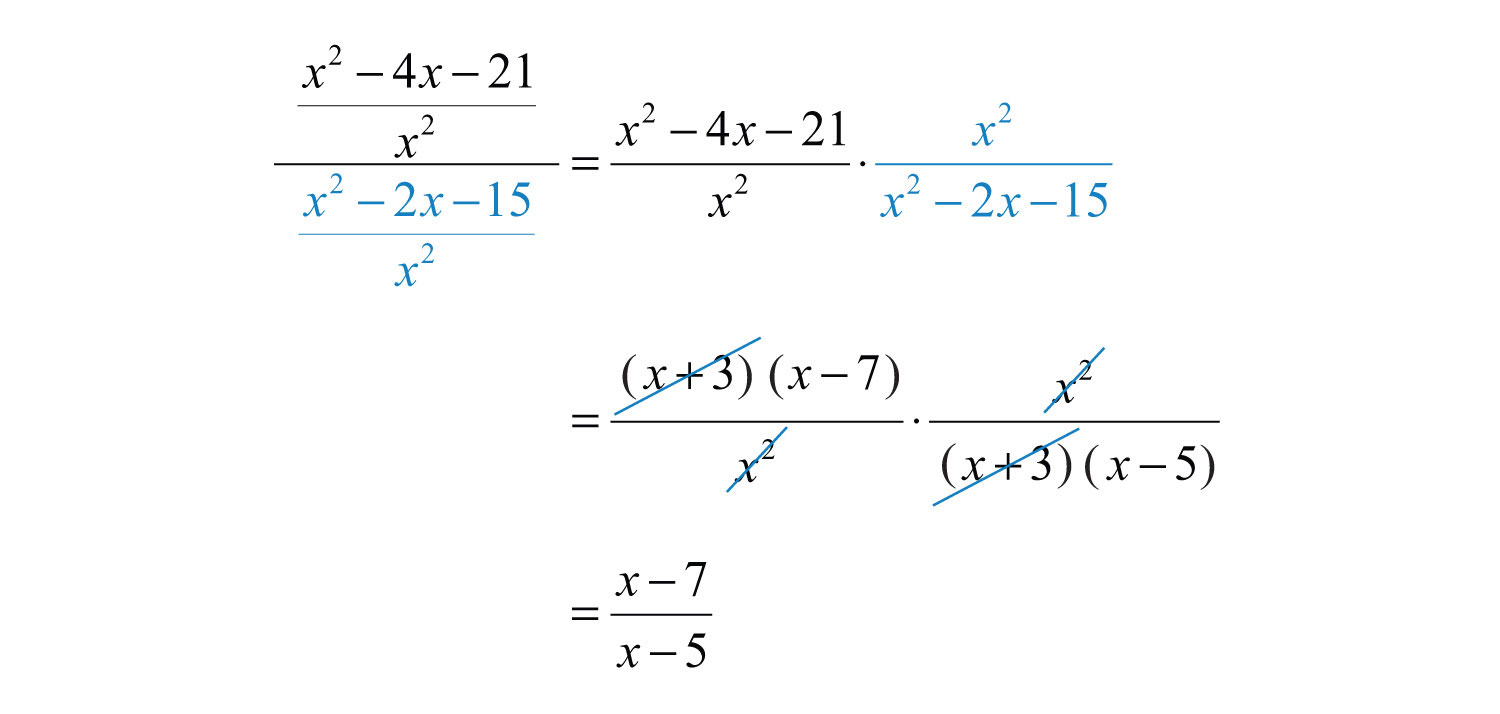
Answer:
Example 4: Simplify: .
Solution:
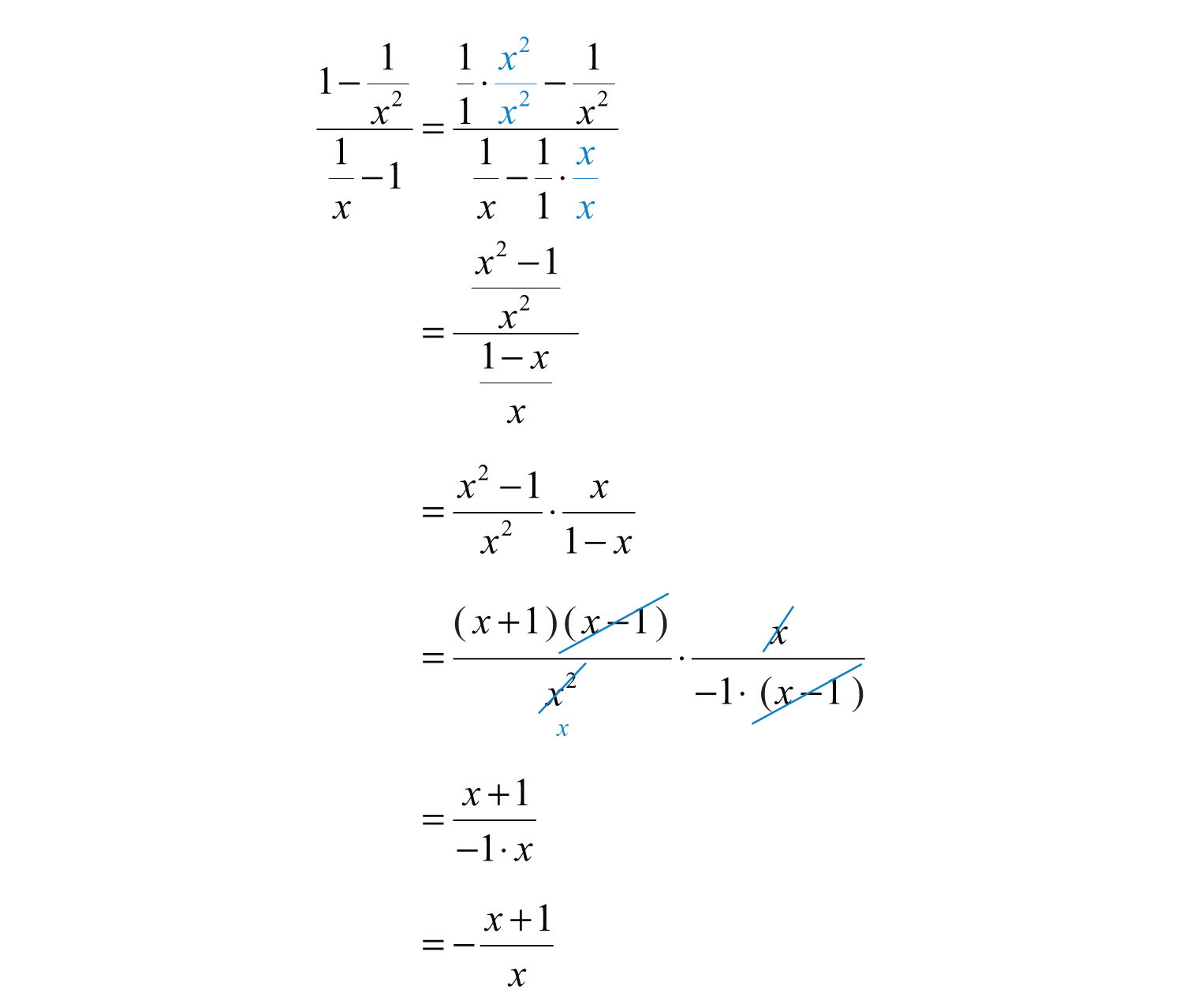
Answer:
Try this! Simplify: .
Answer:
Video Solution
(click to see video)Method 2: Simplify Using the LCD
An alternative method for simplifying complex rational expressions involves clearing the fractions by multiplying the expression by a special form of 1. In this method, multiply the numerator and denominator by the least common denominator (LCD) of all given fractions.
Example 5: Simplify: .
Solution:
Step 1: Determine the LCD of all the fractions in the numerator and denominator. In this case, the denominators of the given fractions are 2, , 4, and . Therefore, the .
Step 2: Multiply the numerator and denominator by the LCD. This step should clear the fractions in both the numerator and denominator.
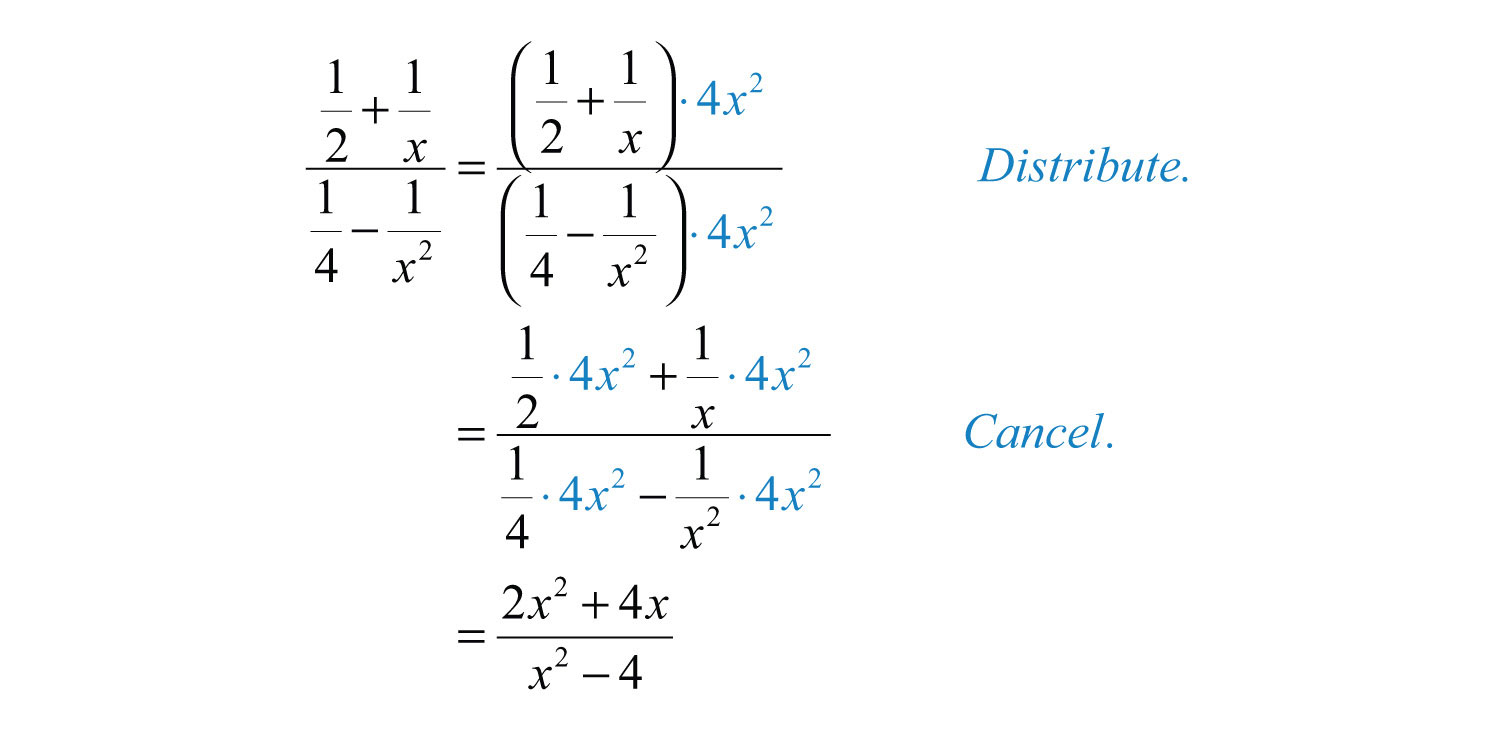
This leaves us with a single algebraic fraction with a polynomial in the numerator and in the denominator.
Step 3: Factor the numerator and denominator completely.

Step 4: Cancel all common factors.

Answer:
Note
This was the same problem that we began this section with, and the results here are the same. It is worth taking the time to compare the steps involved using both methods on the same problem.
Example 6: Simplify: .
Solution: Considering all of the denominators, we find that the . Therefore, multiply the numerator and denominator by :
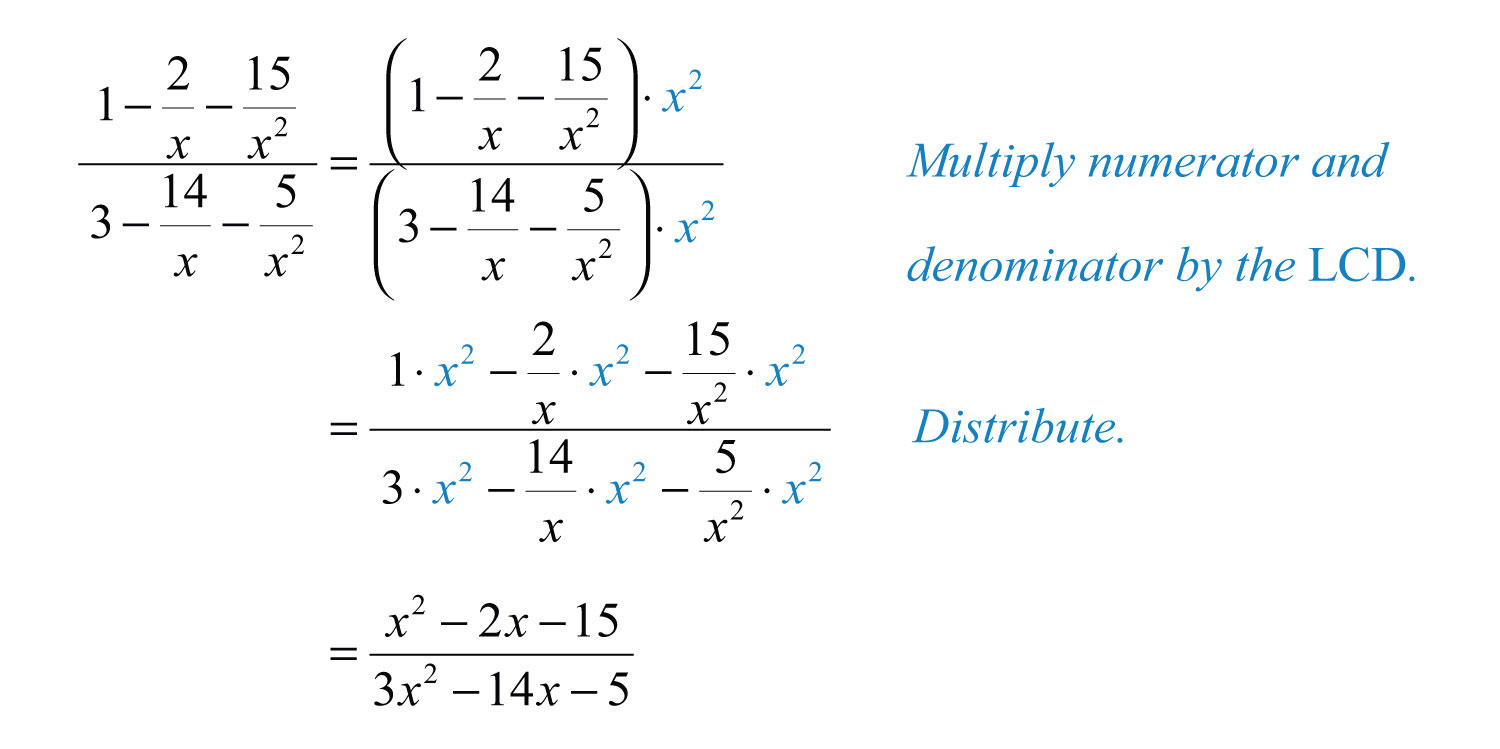
At this point, we have a rational expression that can be simplified by factoring and then canceling the common factors.

Answer:
It is important to point out that multiplying the numerator and denominator by the same nonzero factor is equivalent to multiplying by 1 and does not change the problem. Because , we can multiply the numerator and denominator by in the previous example and obtain an equivalent expression.
Example 7: Simplify: .
Solution: The LCM of all the denominators is . Begin by multiplying the numerator and denominator by these factors.
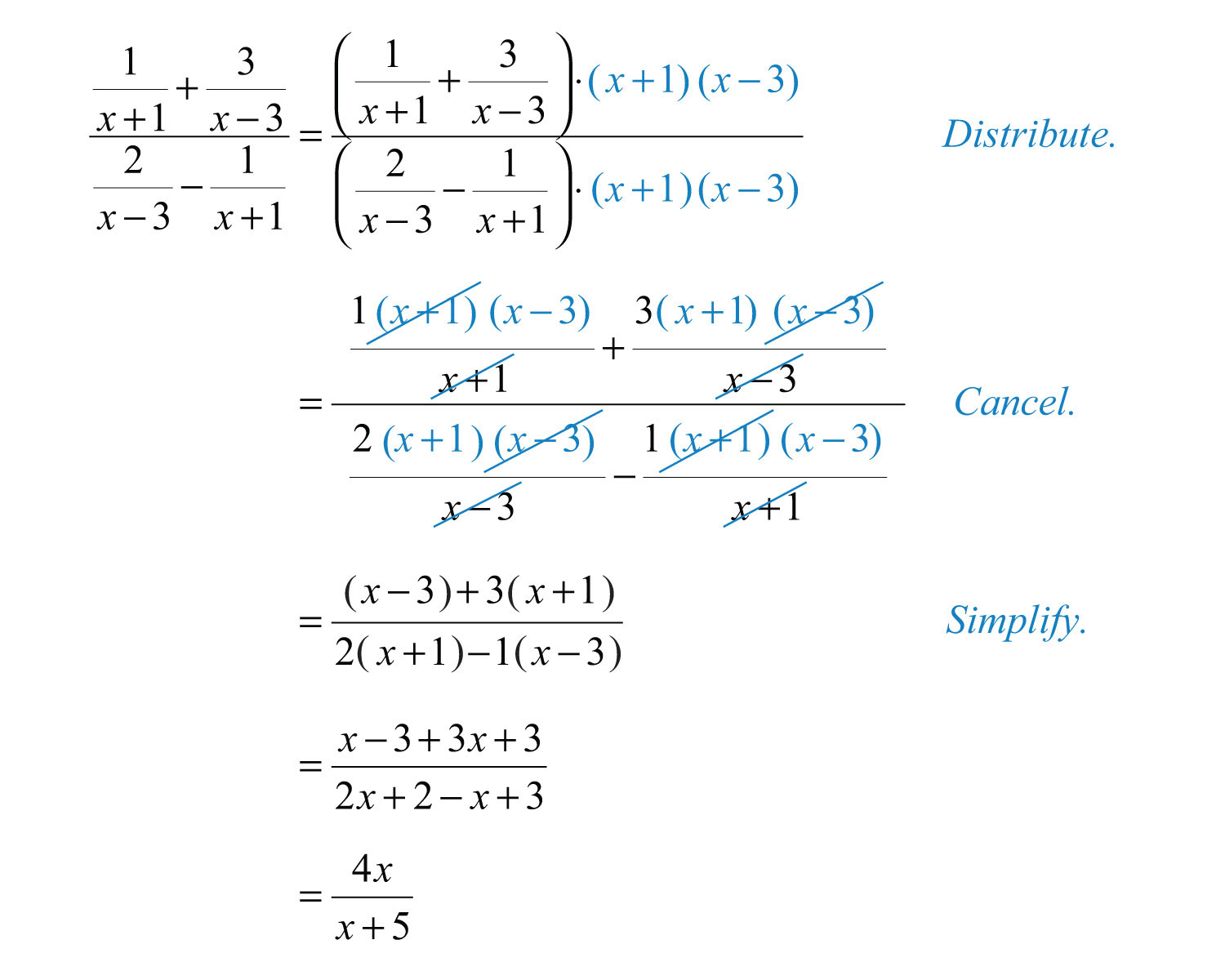
Answer:
Try this! Simplify: .
Answer:
Video Solution
(click to see video)Key Takeaways
- Complex rational expressions can be simplified into equivalent expressions with a polynomial numerator and polynomial denominator.
- One method of simplifying a complex rational expression requires us to first write the numerator and denominator as a single algebraic fraction. Then multiply the numerator by the reciprocal of the divisor and simplify the result.
- Another method for simplifying a complex rational expression requires that we multiply it by a special form of 1. Multiply the numerator and denominator by the LCM of all the denominators as a means to clear the fractions. After doing this, simplify the remaining rational expression.
- An algebraic fraction is reduced to lowest terms if the numerator and denominator are polynomials that share no common factors other than 1.
Topic Exercises
Part A: Complex Rational Expressions
Simplify. (Assume all denominators are nonzero.)
1.
2.
3.
4.
5.
6.
7.
8.
9.
10.
11.
12.
13.
14.
15.
16.
17.
18.
19.
20.
21.
22.
23.
24.
25.
26.
27.
28.
29.
30.
31.
32.
33.
34.
35.
36.
37.
38.
39.
40.
41.
42.
43.
44.
45.
46.
47.
48.
49.
50.
51.
52.
53.
54.
55.
56.
57.
58.
59.
60.
Part B: Discussion Board Topics
61. Choose a problem from this exercise set and clearly work it out on paper, explaining each step in words. Scan your page and post it on the discussion board.
62. Explain why we need to simplify the numerator and denominator to a single algebraic fraction before multiplying by the reciprocal of the divisor.
63. Two methods for simplifying complex rational expressions have been presented in this section. Which of the two methods do you feel is more efficient, and why?
Answers
1:
3:
5: 4/5
7: −6/11
9:
11:
13:
15:
17:
19:
21:
23:
25:
27:
29:
31:
33:
35:
37:
39:
41:
43:
45:
47:
49:
51:
53:
55:
57:
59:
7.5 Solving Rational Equations
Learning Objectives
- Solve rational equations.
- Solve literal equations, or formulas, involving rational expressions.
Solving Rational Equations
A rational equationAn equation containing at least one rational expression. is an equation containing at least one rational expression. Rational expressions typically contain a variable in the denominator. For this reason, we will take care to ensure that the denominator is not 0 by making note of restrictions and checking our solutions.
Solve rational equations by clearing the fractions by multiplying both sides of the equation by the least common denominator (LCD).
Example 1: Solve: .
Solution: We first make a note that and then multiply both sides by the LCD, 3x:
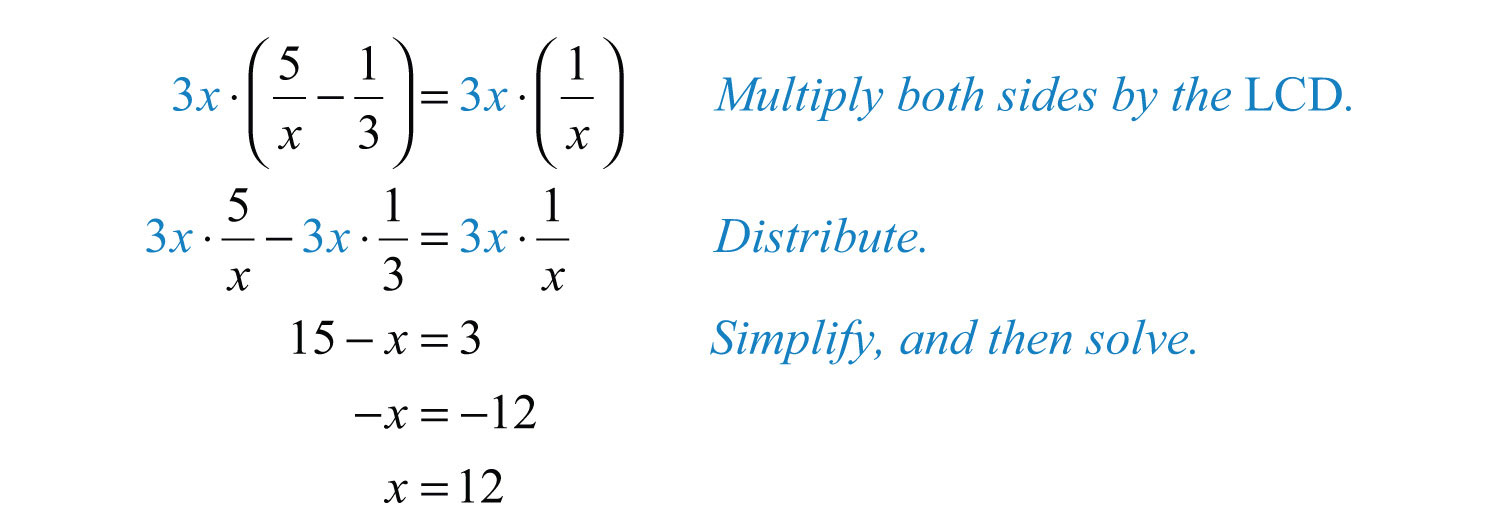
Check your answer by substituting 12 for x to see if you obtain a true statement.

Answer: The solution is 12.
After multiplying both sides of the previous example by the LCD, we were left with a linear equation to solve. This is not always the case; sometimes we will be left with a quadratic equation.
Example 2: Solve: .
Solution: In this example, there are two restrictions, and . Begin by multiplying both sides by the LCD, .
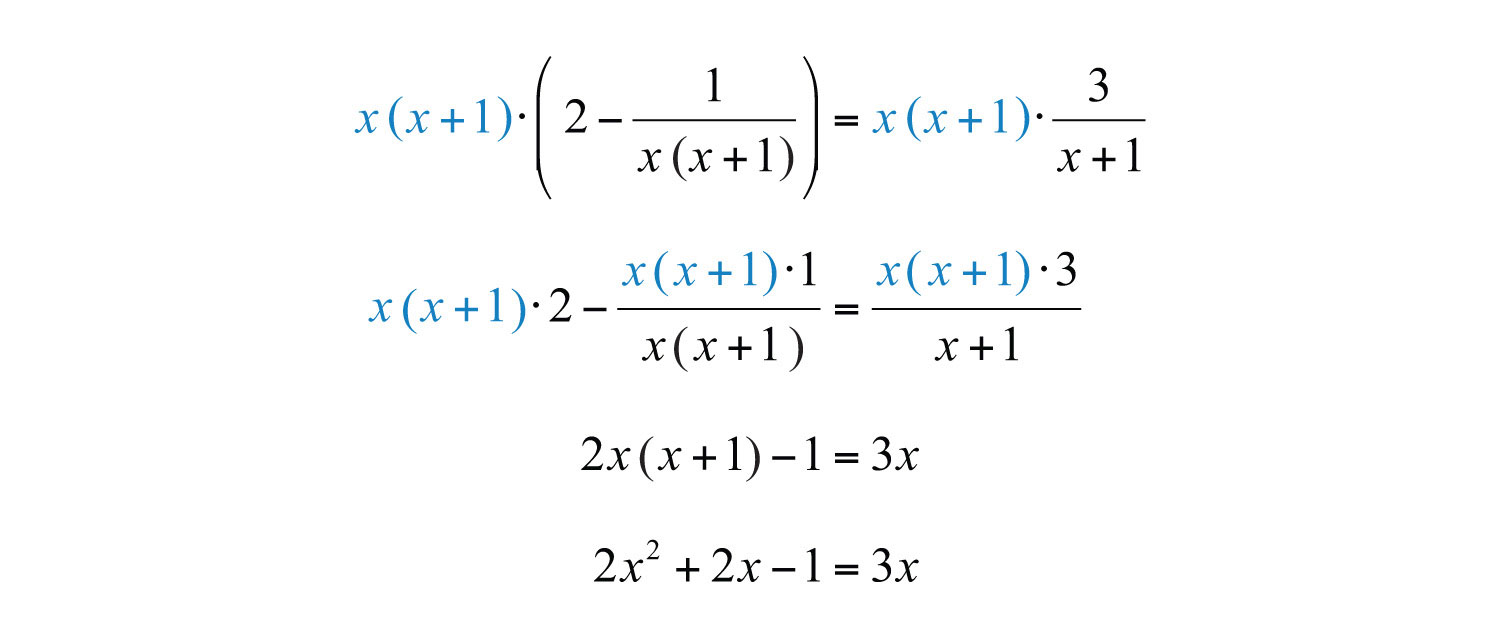
After distributing and dividing out the common factors, a quadratic equation remains. To solve it, rewrite it in standard form, factor, and then set each factor equal to 0.
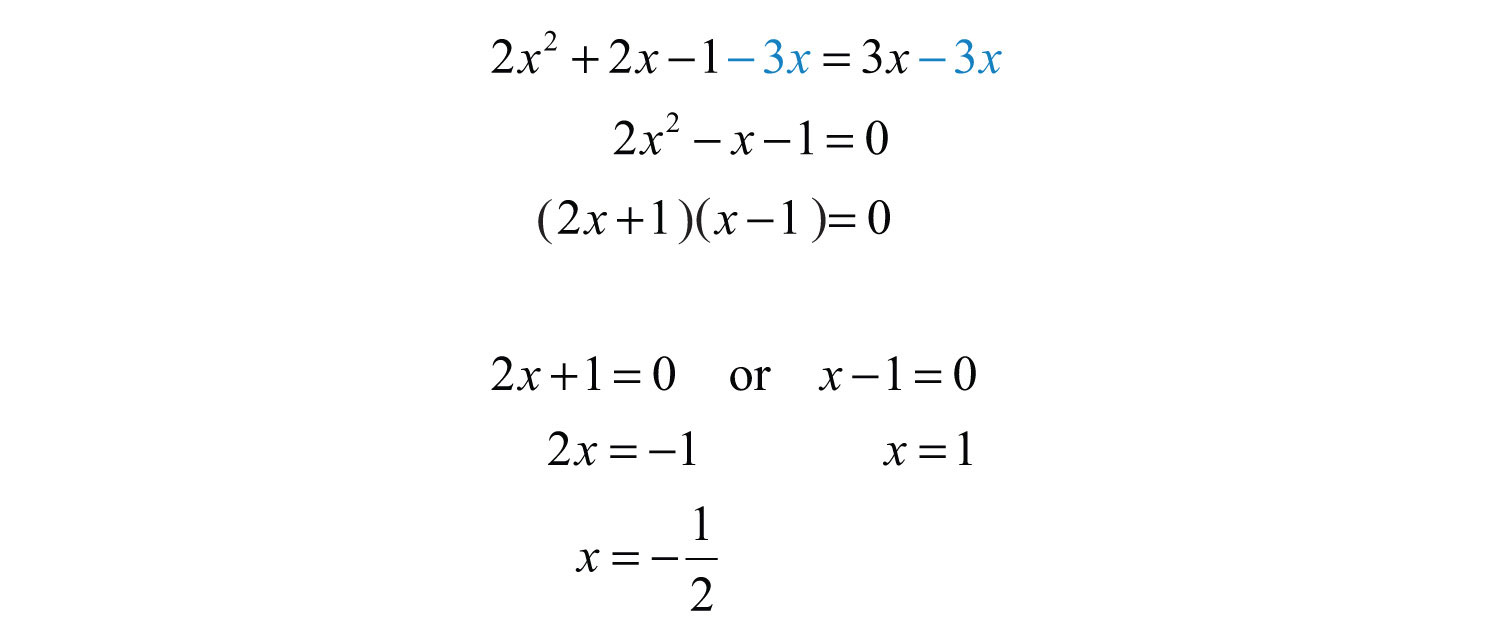
Check to see if these values solve the original equation.
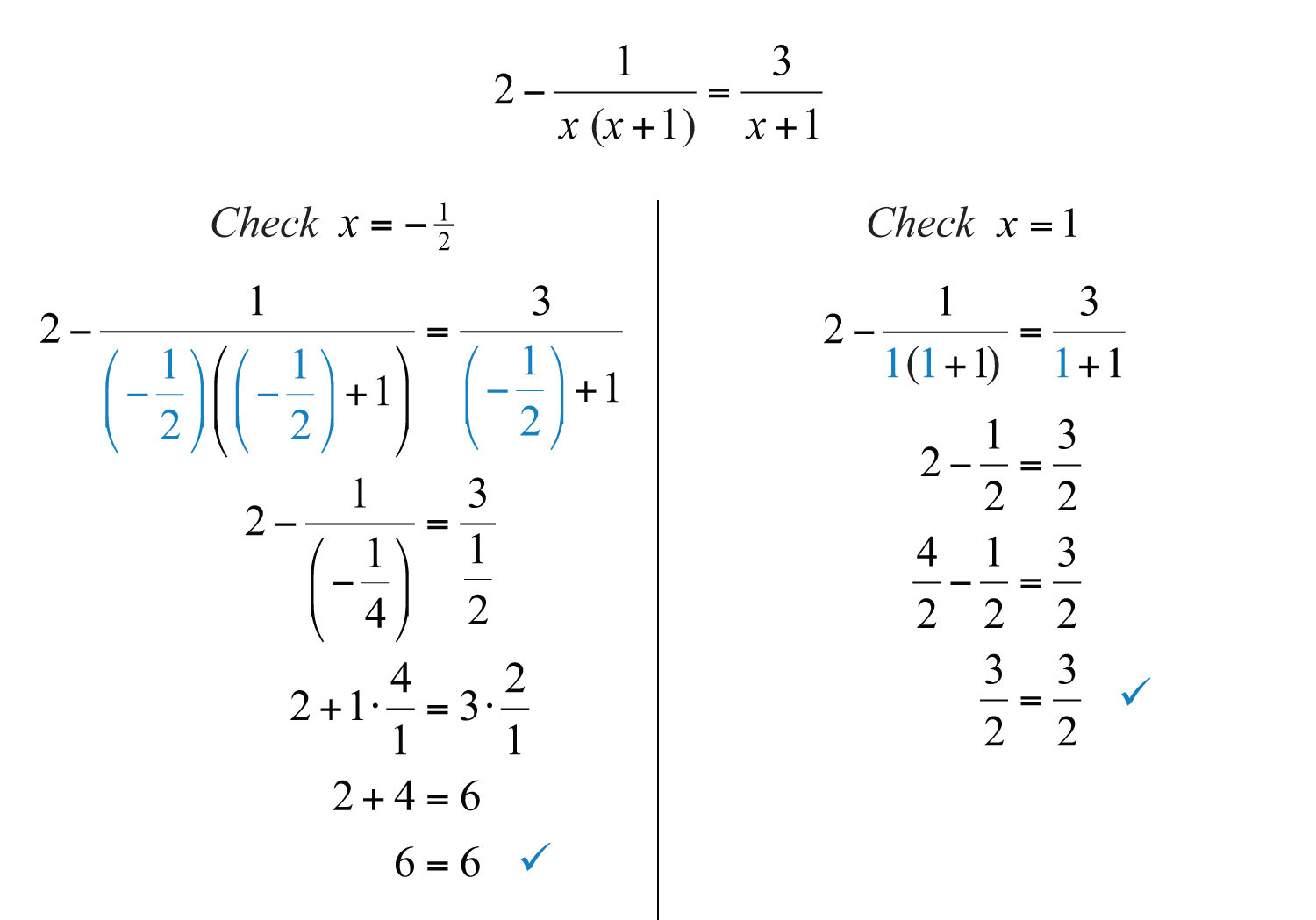
Answer: The solutions are −1/2 and 1.
Up to this point, all of the possible solutions have solved the original equation. However, this may not always be the case. Multiplying both sides of an equation by variable factors may lead to extraneous solutionsA solution that does not solve the original equation., which are solutions that do not solve the original equation. A complete list of steps for solving a rational equation is outlined in the following example.
Example 3: Solve: .
Solution:
Step 1: Factor all denominators and determine the LCD.

The .
Step 2: Identify the restrictions. In this case, they are and .
Step 3: Multiply both sides of the equation by the LCD. Distribute carefully and then simplify.
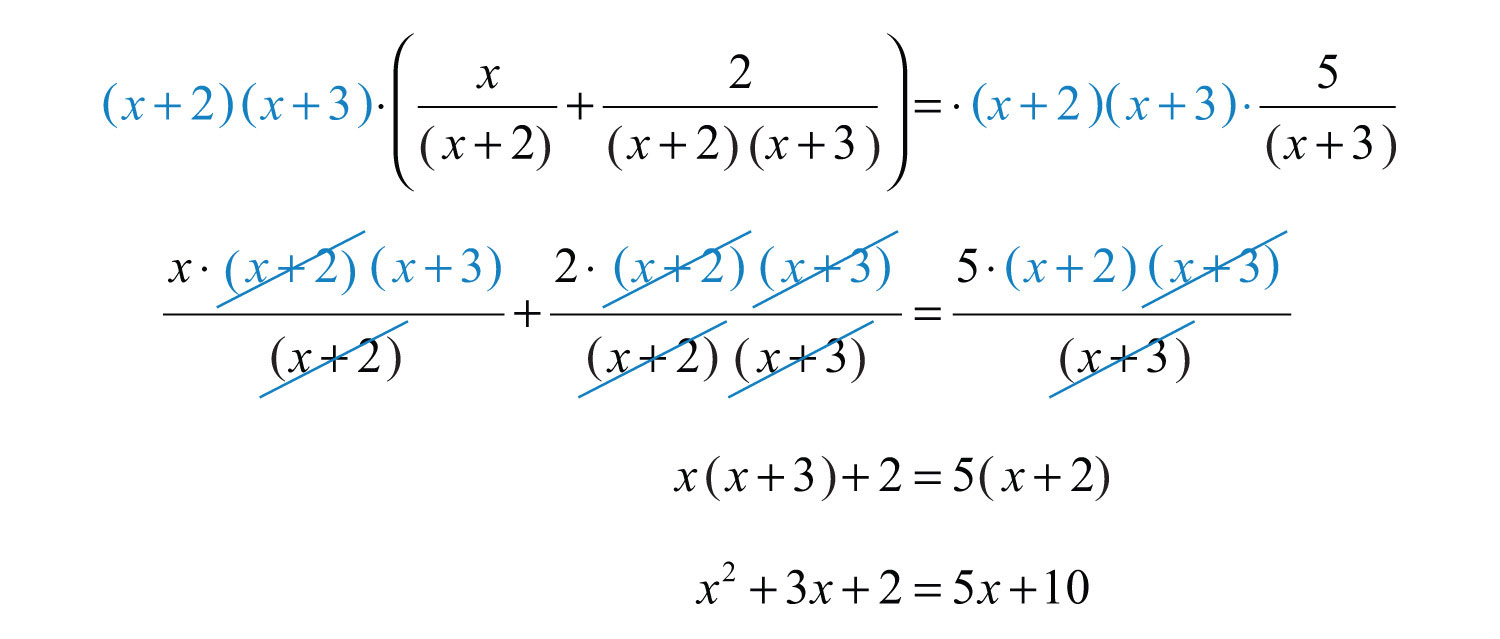
Step 4: Solve the resulting equation. Here the result is a quadratic equation. Rewrite it in standard form, factor, and then set each factor equal to 0.
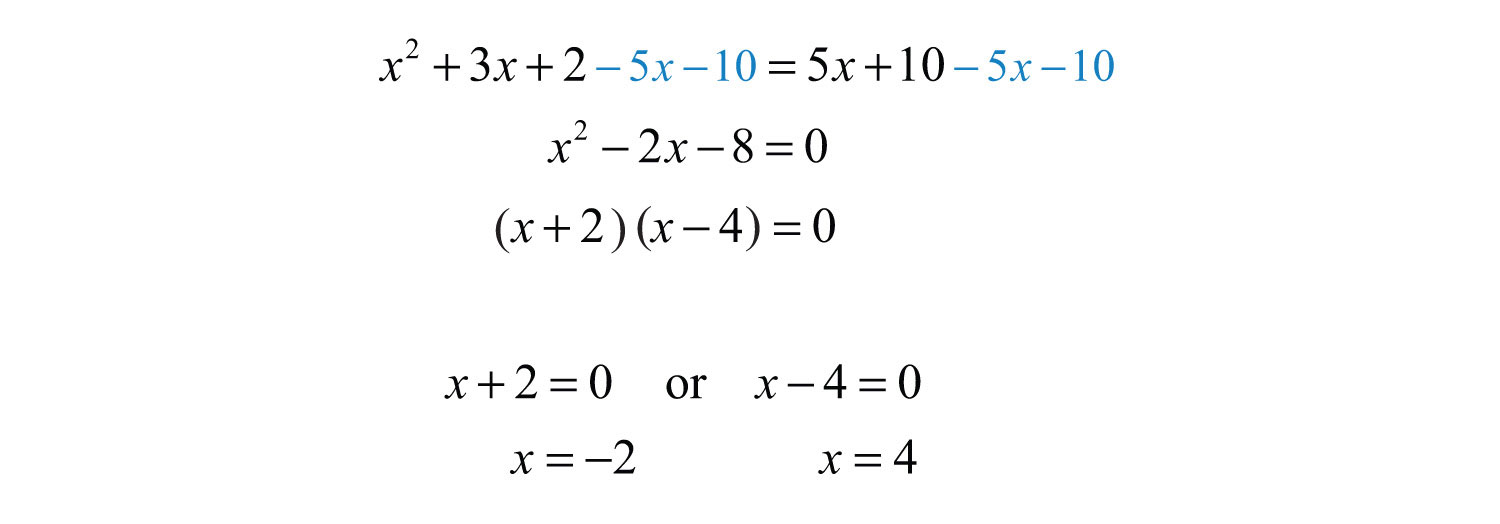
Step 5: Check for extraneous solutions. Always substitute into the original equation, or the factored equivalent. In this case, choose the factored equivalent to check:
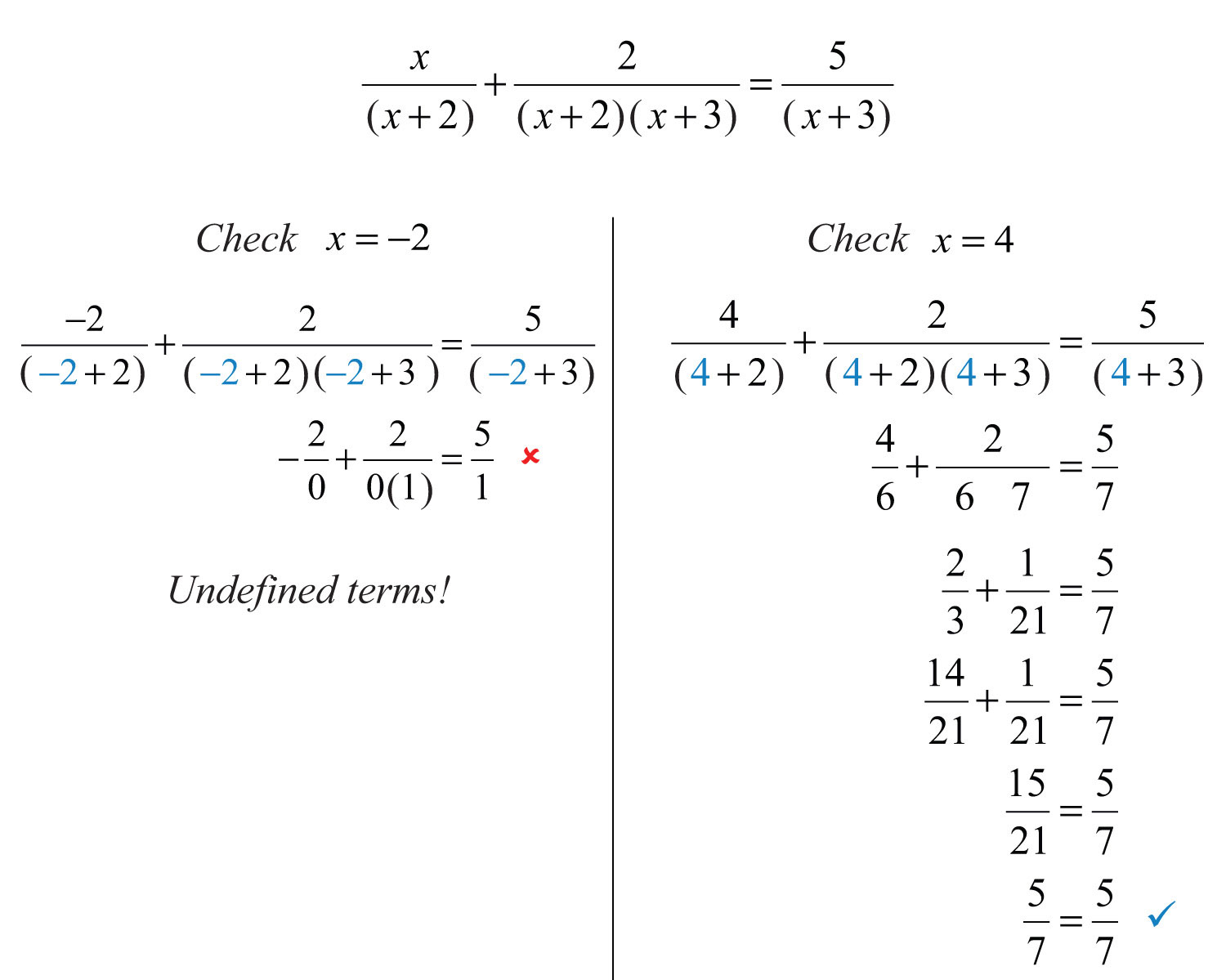
Here −2 is an extraneous solution and is not included in the solution set. It is important to note that −2 is a restriction.
Answer: The solution is 4.
If this process produces a solution that happens to be a restriction, then disregard it as an extraneous solution.
Try this! Solve: .
Answer: −3
Video Solution
(click to see video)Sometimes all potential solutions are extraneous, in which case we say that there is no solution to the original equation. In the next two examples, we demonstrate two ways in which a rational equation can have no solutions.
Example 4: Solve: .
Solution: To identify the LCD, first factor the denominators.

Multiply both sides by the least common denonominator (LCD), , distributing carefully.
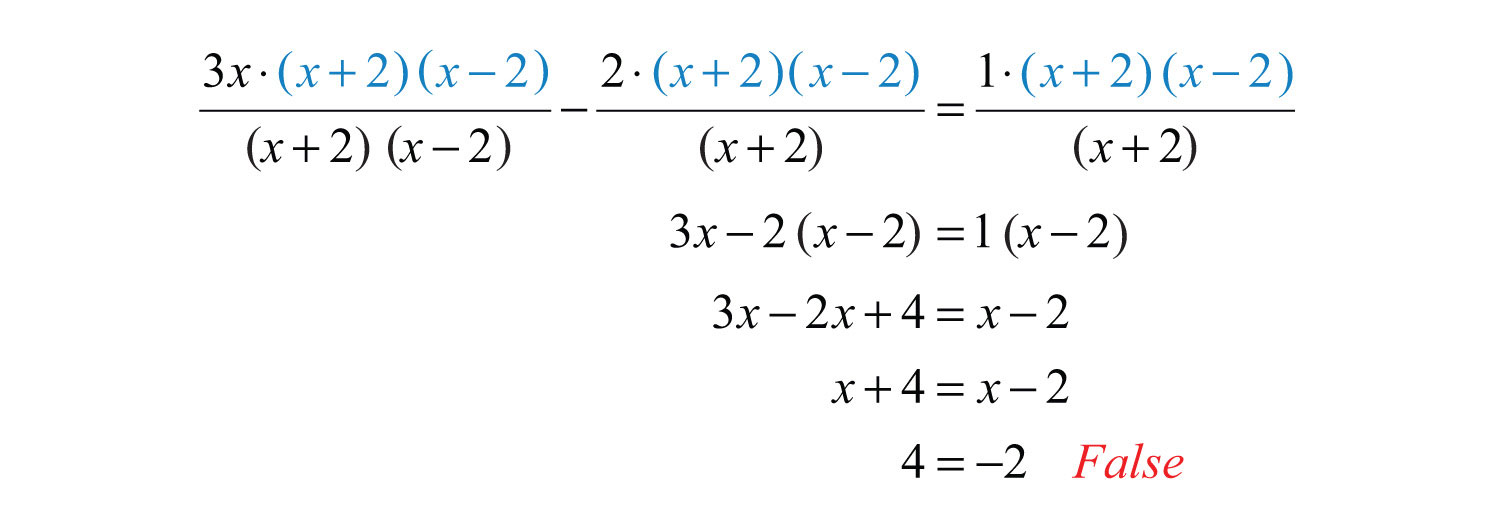
The equation is a contradiction and thus has no solution.
Answer: No solution,
Example 5: Solve: .
Solution: First, factor the denominators.

Take note that the restrictions are and . To clear the fractions, multiply by the LCD, .
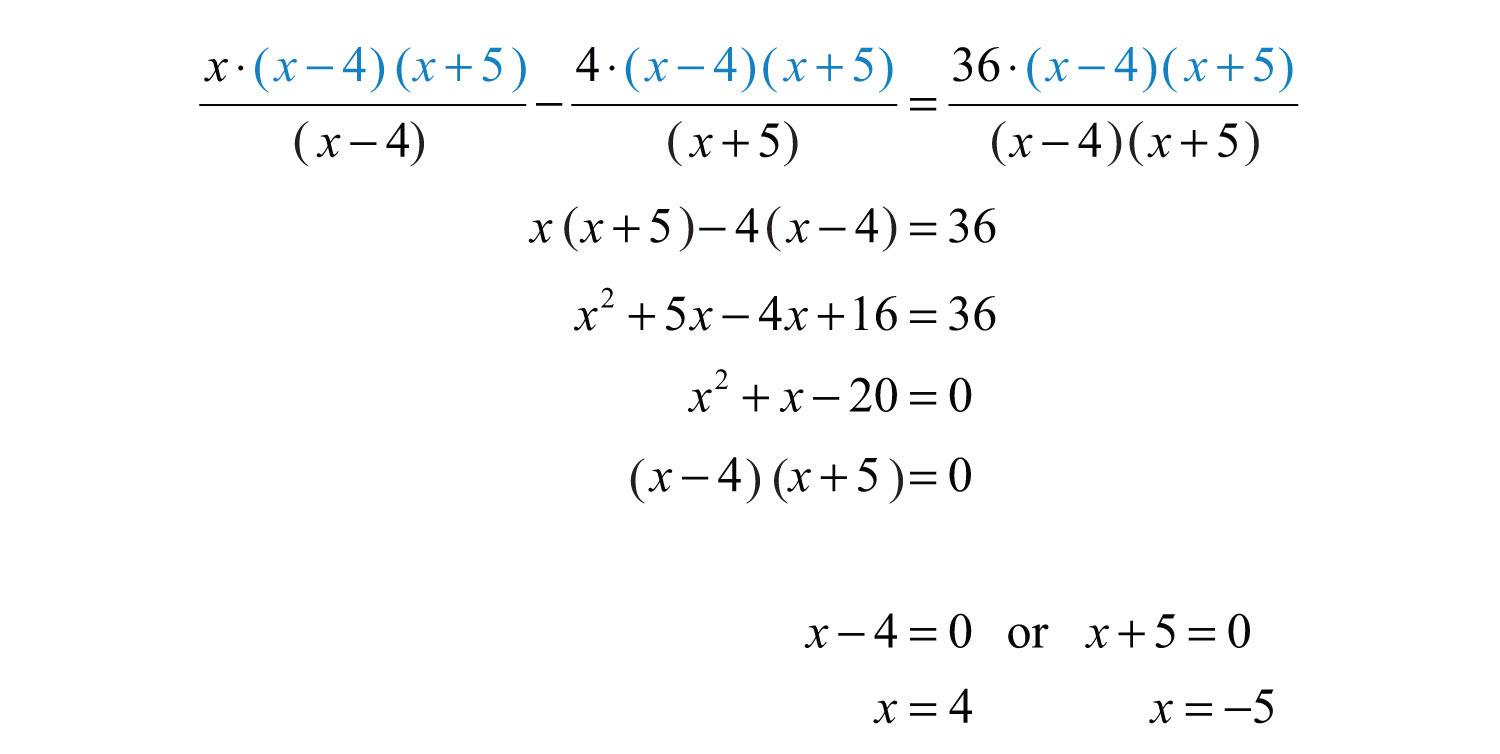
Both of these values are restrictions of the original equation; hence both are extraneous.
Answer: No solution,
Try this! Solve: .
Answer:
Video Solution
(click to see video)It is important to point out that this technique for clearing algebraic fractions only works for equations. Do not try to clear algebraic fractions when simplifying expressions. As a reminder, we have

Expressions are to be simplified and equations are to be solved. If we multiply the expression by the LCD, , we obtain another expression that is not equivalent.
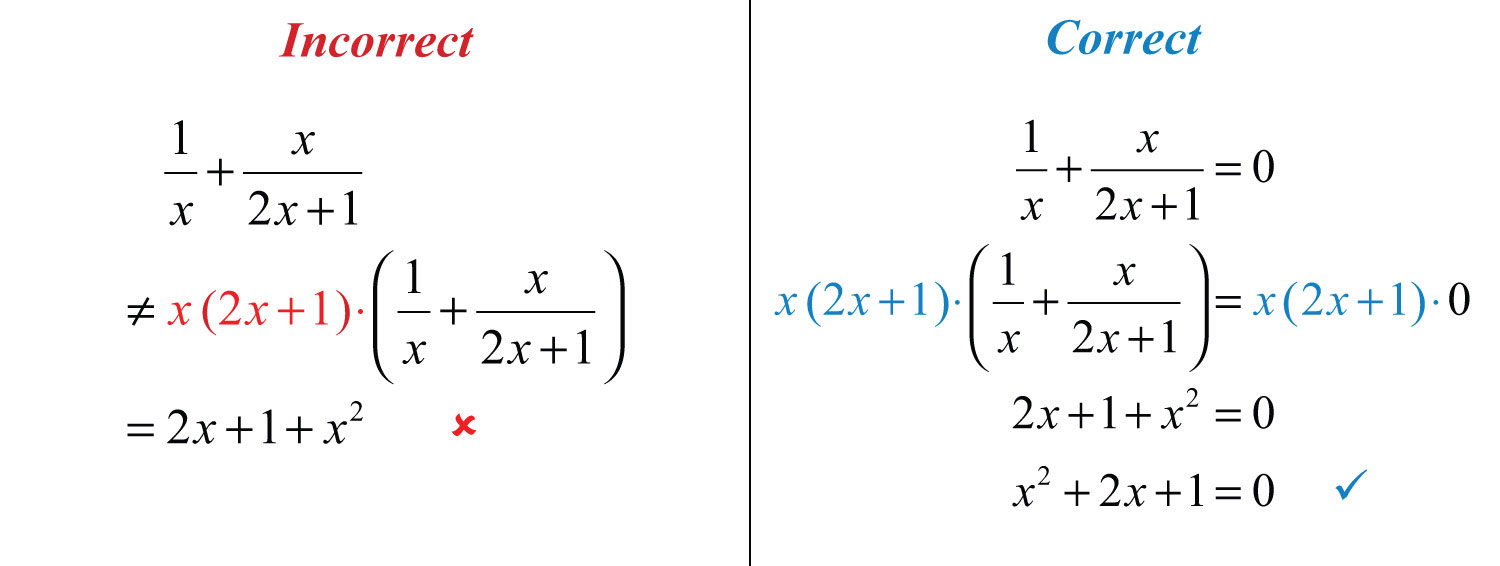
Literal Equations
Literal equations, or formulas, are often rational equations. Hence the techniques described in this section can be used to solve for particular variables. Assume that all variable expressions in the denominator are nonzero.
Example 6: Solve for x: .
Solution: The goal is to isolate x. Assuming that y is nonzero, multiply both sides by y and then add 5 to both sides.

Answer:
Example 7: Solve for c: .
Solution: In this example, the goal is to isolate c. We begin by multiplying both sides by the LCD, , distributing carefully.

On the right side of the equation, factor out c.

Next, divide both sides of the equation by the quantity .

Answer:
Try this! Solve for y: .
Answer:
Video Solution
(click to see video)Key Takeaways
- Begin solving rational equations by multiplying both sides by the LCD. The resulting equivalent equation can be solved using the techniques learned up to this point.
- Multiplying both sides of a rational equation by a variable expression introduces the possibility of extraneous solutions. Therefore, we must check the solutions against the set of restrictions. If a solution is a restriction, then it is not part of the domain and is extraneous.
- When multiplying both sides of an equation by an expression, distribute carefully and multiply each term by that expression.
- If all of the resulting solutions are extraneous, then the original equation has no solutions.
Topic Exercises
Part A: Rational Equations
Solve.
1.
2.
3.
4.
5.
6.
7.
8.
9.
10.
11.
12.
13.
14.
15.
16.
17.
18.
19.
20.
21.
22.
23.
24.
25.
26.
27.
28.
29.
30.
31.
32.
33.
34.
35.
36.
37.
38.
39.
40.
41.
42.
43.
44.
45.
46.
47.
48.
49.
50.
51.
52.
53.
54.
55.
56.
57.
58.
59.
60.
61.
62.
63.
64.
Part B: Literal Equations
Solve for the indicated variable.
65. Solve for r: .
66. Solve for b: .
67. Solve for P: .
68. Solve for : .
69. Solve for c: .
70. Solve for y: .
71. Solve for w: .
72. Solve for t: .
73. Solve for m: .
74. Solve for S: .
75. Solve for x: .
76. Solve for x: .
77. Solve for R: .
78. Solve for : .
Part C: Discussion Board
79. Explain why multiplying both sides of an equation by the LCD sometimes produces extraneous solutions.
80. Explain the connection between the technique of cross multiplication and multiplying both sides of a rational equation by the LCD.
81. Explain how we can tell the difference between a rational expression and a rational equation. How do we treat them differently?
Answers
1: −8/3
3: −1
5: −2/5
7: 5/2
9: −3
11: −6, 6
13: −4, 6
15: −1
17: −6, 8
19: −4, 6
21: −7, 4
23:
25:
27: −39
29: 4/3, 3/2
31: −1/3
33: −1/2, 1/2
35: 2/5
37:
39: −1/2
41:
43: −7
45: 5
47: −1
49:
51: −4
53: 5/3
55:
57: 1/2
59: −6, 4
61: 10
63: 1/3
65:
67:
69:
71:
73:
75:
77:
7.6 Applications of Rational Equations
Learning Objectives
- Solve applications involving relationships between real numbers.
- Solve applications involving uniform motion (distance problems).
- Solve work-rate applications.
Number Problems
Recall that the reciprocalThe reciprocal of a nonzero number n is 1/n. of a nonzero number n is 1/n. For example, the reciprocal of 5 is 1/5 and 5 ⋅ 1/5 = 1. In this section, the applications will often involve the key word “reciprocal.” When this is the case, we will see that the algebraic setup results in a rational equation.
Example 1: A positive integer is 4 less than another. The sum of the reciprocals of the two positive integers is 10/21. Find the two integers.
Solution: Begin by assigning variables to the unknowns.

Next, use the reciprocals and to translate the sentences into an algebraic equation.

We can solve this rational expression by multiplying both sides of the equation by the least common denominator (LCD). In this case, the LCD is .
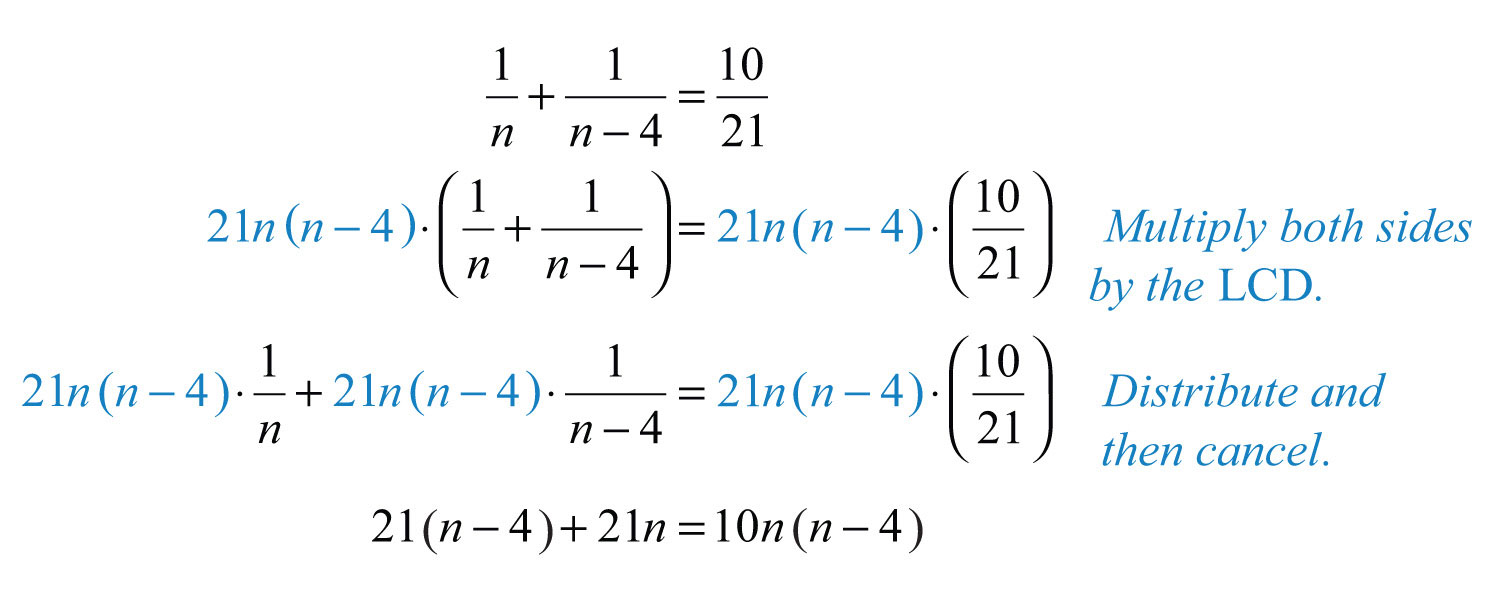
Solve the resulting quadratic equation.
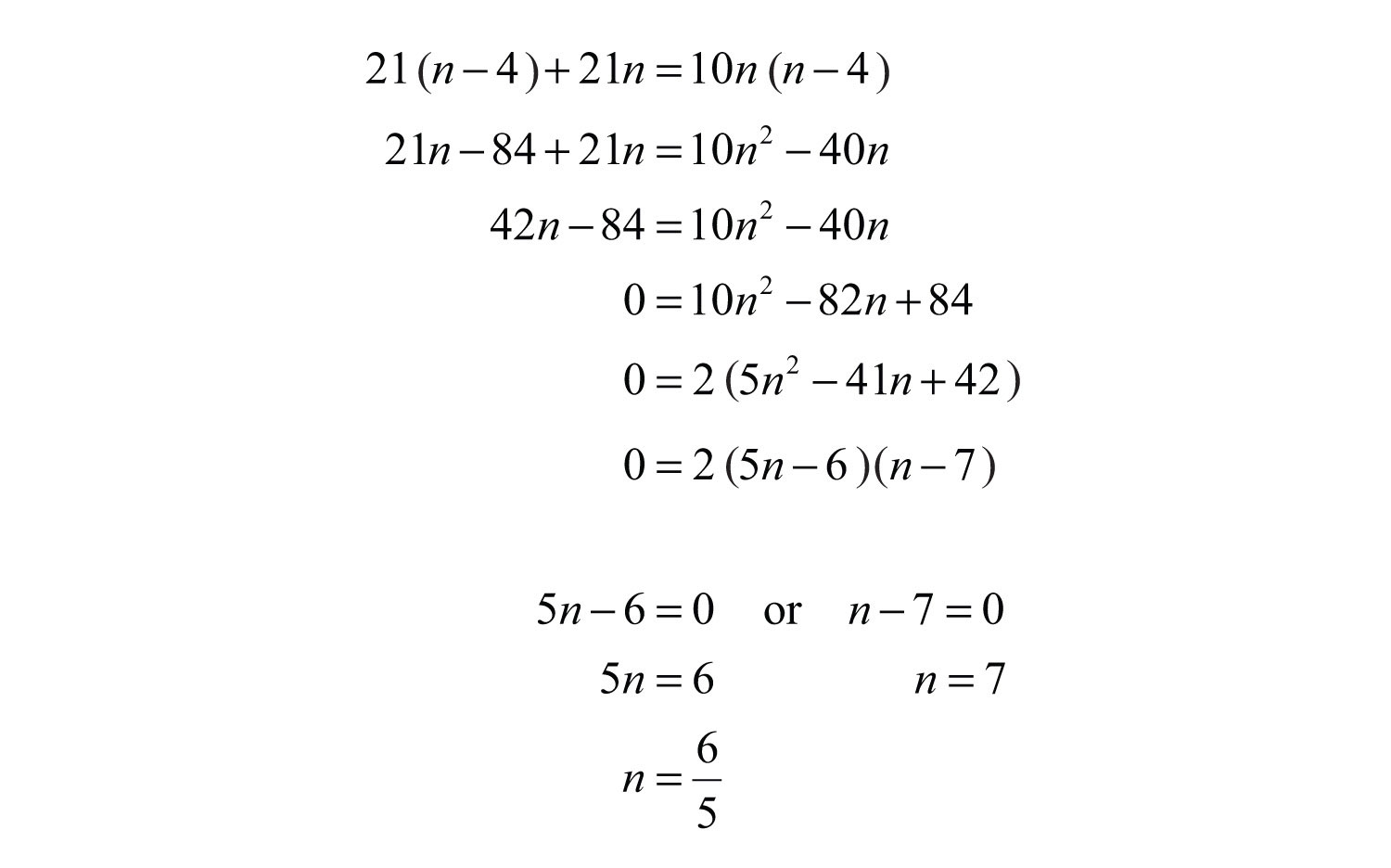
The question calls for integers and the only integer solution is . Hence disregard 6/5. Use the expression to find the smaller integer.

Answer: The two positive integers are 3 and 7. The check is left to the reader.
Example 2: A positive integer is 4 less than another. If the reciprocal of the smaller integer is subtracted from twice the reciprocal of the larger, then the result is 1/30. Find the two integers.
Solution:

Set up an algebraic equation.

Solve this rational expression by multiplying both sides by the LCD. The LCD is .
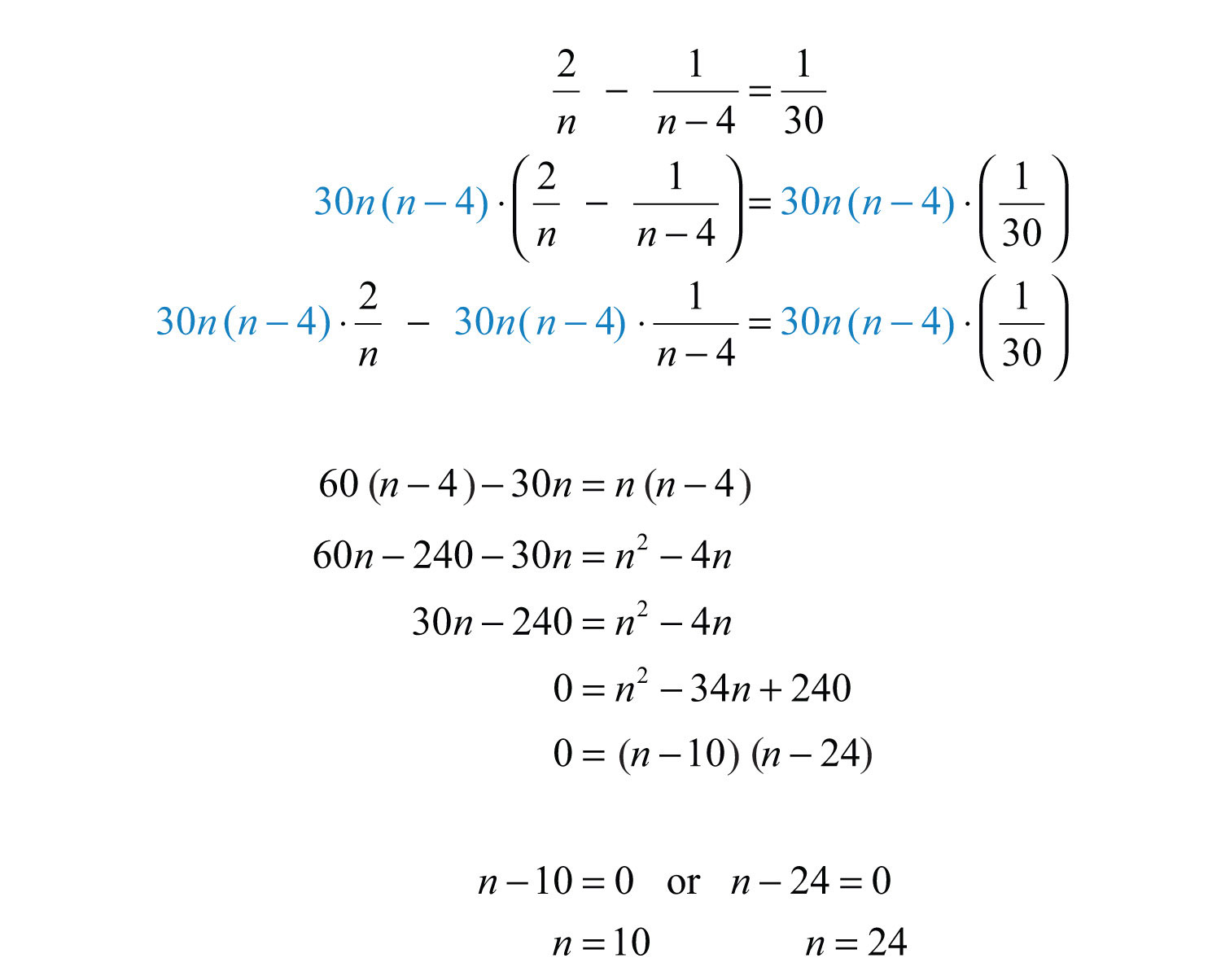
Here we have two viable possibilities for the larger integer. For this reason, we will we have two solutions to this problem.

As a check, perform the operations indicated in the problem.
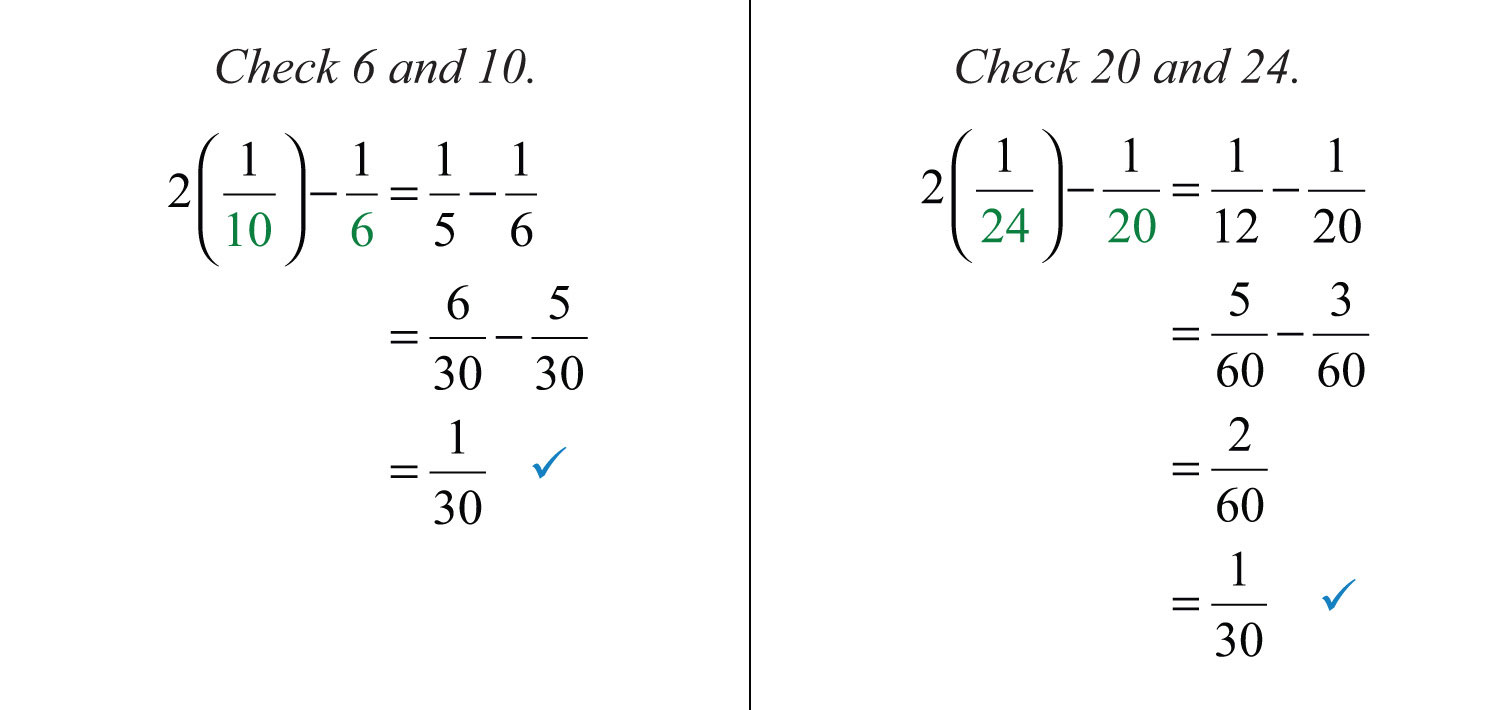
Answer: Two sets of positive integers solve this problem: {6, 10} and {20, 24}.
Try this! The difference between the reciprocals of two consecutive positive odd integers is 2/15. Find the integers.
Answer: The integers are 3 and 5.
Video Solution
(click to see video)Uniform Motion Problems
Uniform motionDescribed by the formula , where the distance, D, is given as the product of the average rate, r, and the time, t, traveled at that rate. problems, also referred to as distance problems, involve the formula

where the distance, D, is given as the product of the average rate, r, and the time, t, traveled at that rate. If we divide both sides by the average rate, r, then we obtain the formula

For this reason, when the unknown quantity is time, the algebraic setup for distance problems often results in a rational equation. Similarly, when the unknown quantity is the rate, the setup also may result in a rational equation.
We begin any uniform motion problem by first organizing our data with a chart. Use this information to set up an algebraic equation that models the application.
Example 5: Mary spent the first 120 miles of her road trip in traffic. When the traffic cleared, she was able to drive twice as fast for the remaining 300 miles. If the total trip took 9 hours, then how fast was she moving in traffic?
Solution: First, identify the unknown quantity and organize the data.


To avoid introducing two more variables for the time column, use the formula . Here the time for each leg of the trip is calculated as follows:

Use these expressions to complete the chart.
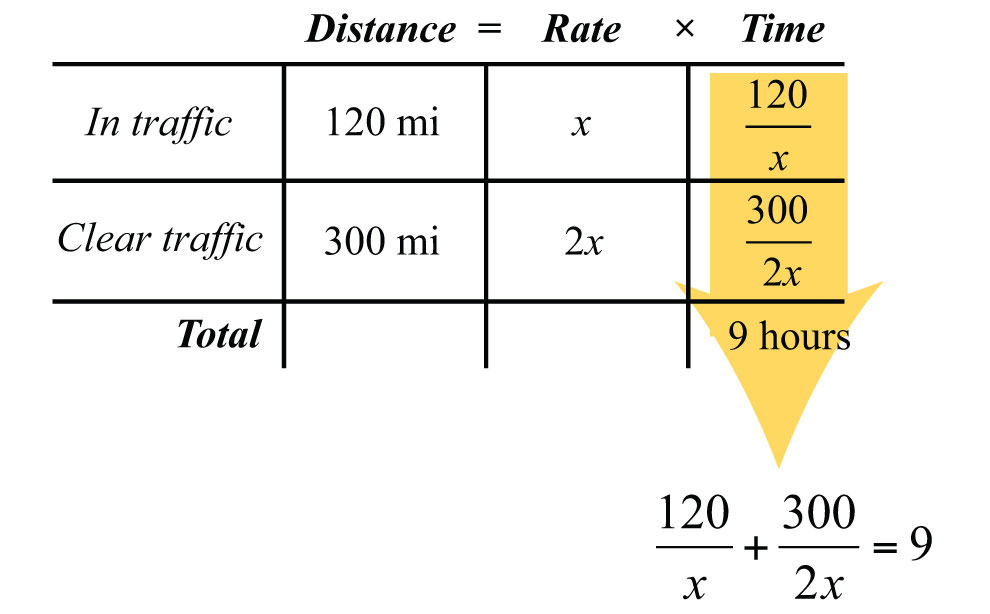
The algebraic setup is defined by the time column. Add the times for each leg of the trip to obtain a total of 9 hours:

We begin solving this equation by first multiplying both sides by the LCD, 2x.
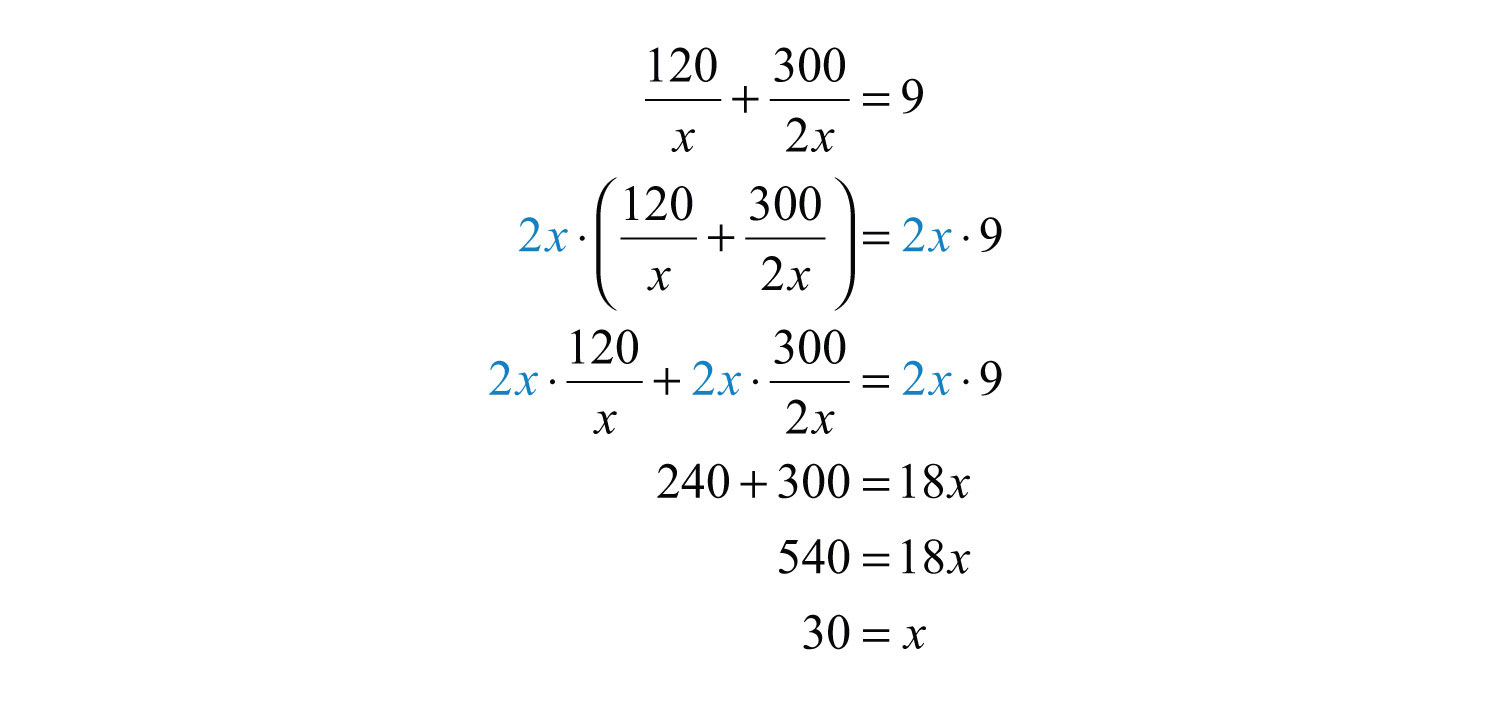
Answer: Mary averaged 30 miles per hour in traffic.
Example 6: A passenger train can travel, on average, 20 miles per hour faster than a freight train. If the passenger train covers 390 miles in the same time it takes the freight train to cover 270 miles, then how fast is each train?
Solution: First, identify the unknown quantities and organize the data.

Next, organize the given data in a chart.

Use the formula to fill in the time column for each train.

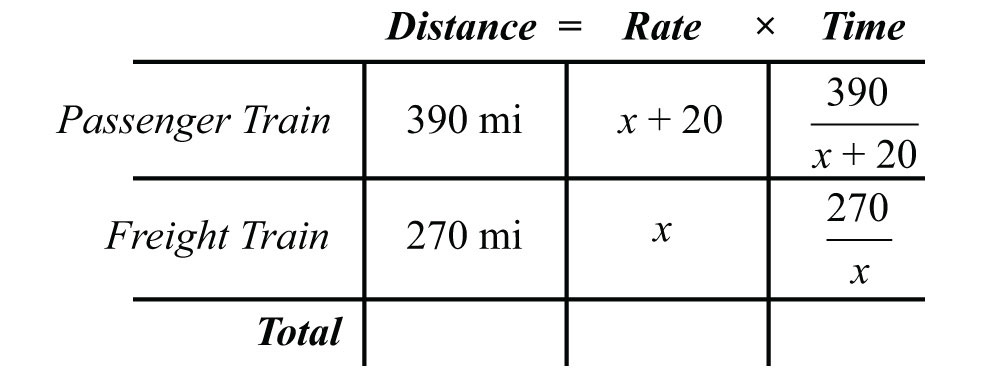
Because the trains travel the same amount of time, finish the algebraic setup by equating the expressions that represent the times:

Solve this equation by first multiplying both sides by the LCD, .

Use x + 20 to find the speed of the passenger train.

Answer: The speed of the passenger train is 65 miles per hour and the speed of the freight train is 45 miles per hour.
Example 7: Brett lives on the river 8 miles upstream from town. When the current is 2 miles per hour, he can row his boat downstream to town for supplies and back in 3 hours. What is his average rowing speed in still water?
Solution:

Rowing downstream, the current increases his speed, and his rate is x + 2 miles per hour. Rowing upstream, the current decreases his speed, and his rate is x − 2 miles per hour. Begin by organizing the data in the following chart:

Use the formula to fill in the time column for each leg of the trip.


The algebraic setup is defined by the time column. Add the times for each leg of the trip to obtain a total of 3 hours:

Solve this equation by first multiplying both sides by the LCD, .
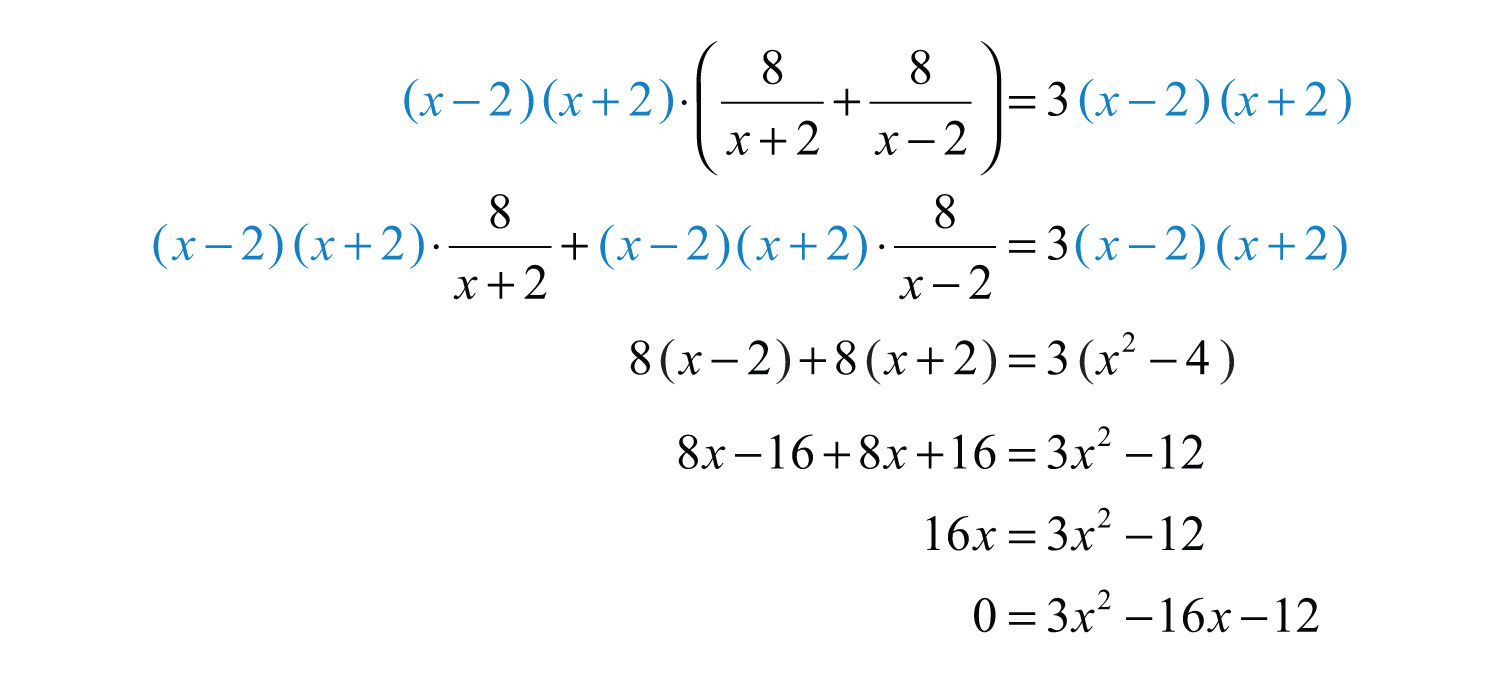
Next, solve the resulting quadratic equation.

Use only the positive solution, miles per hour.
Answer: His rowing speed is 6 miles per hour.
Try this! Dwayne drove 18 miles to the airport to pick up his father and then returned home. On the return trip he was able to drive an average of 15 miles per hour faster than he did on the trip there. If the total driving time was 1 hour, then what was his average speed driving to the airport?
Answer: His average speed driving to the airport was 30 miles per hour.
Video Solution
(click to see video)Work-Rate Problems
The rate at which a task can be performed is called a work rateThe rate at which a task can be performed.. For example, if a painter can paint a room in 8 hours, then the task is to paint the room, and we can write

In other words, the painter can complete of the task per hour. If he works for less than 8 hours, then he will perform a fraction of the task. For example,
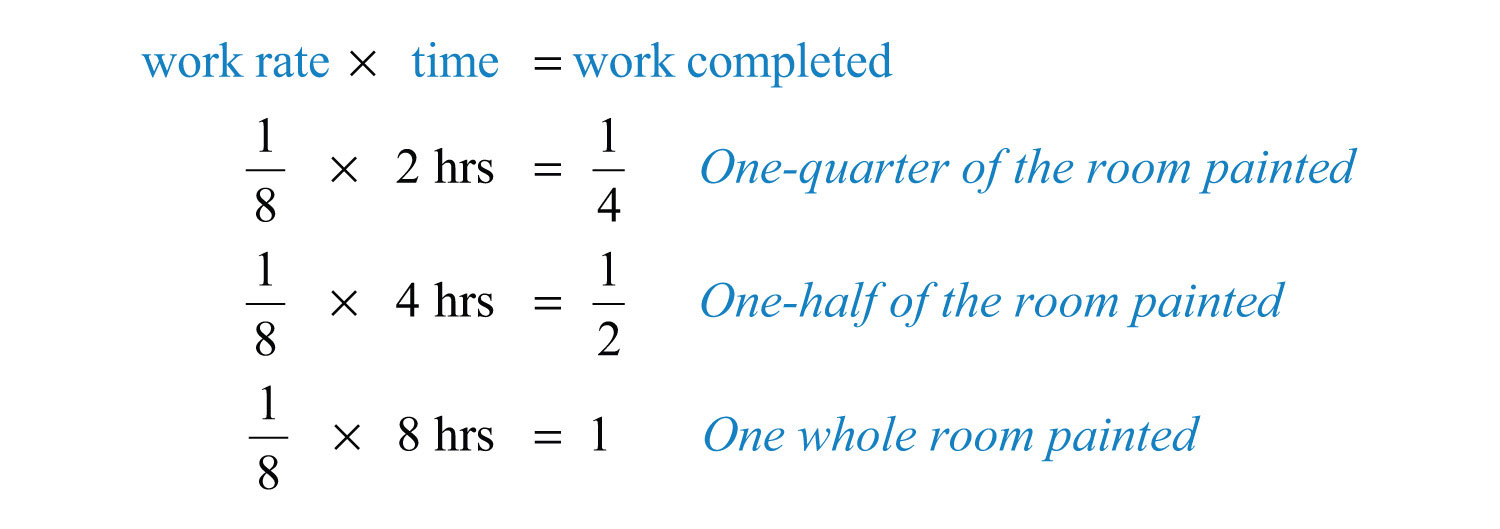
Obtain the amount of the task completed by multiplying the work rate by the amount of time the painter works. Typically, work-rate problems involve people working together to complete tasks. When this is the case, we can organize the data in a chart, just as we have done with distance problems.
Suppose an apprentice painter can paint the same room by himself in 10 hours. Then we say that he can complete of the task per hour. Let t represent the time it takes both of the painters, working together, to paint the room.
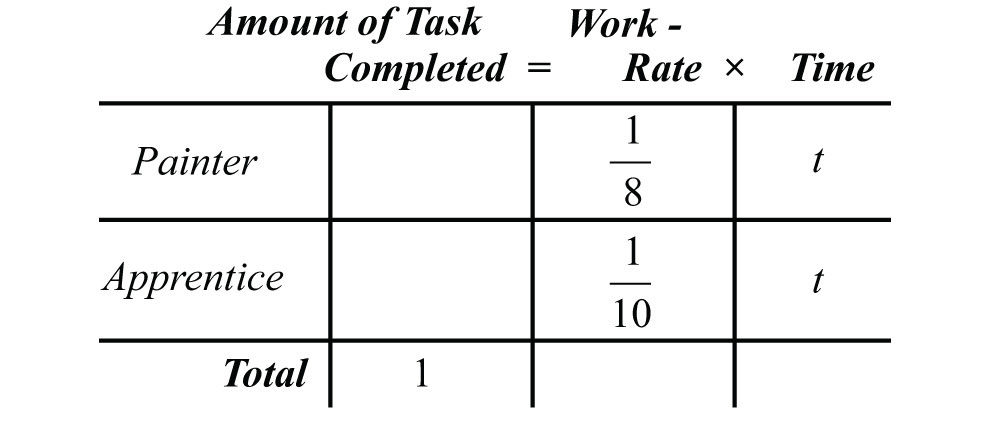
To complete the chart, multiply the work rate by the time for each person. The portion of the room each can paint adds to a total of 1 task completed. This is represented by the equation obtained from the first column of the chart:
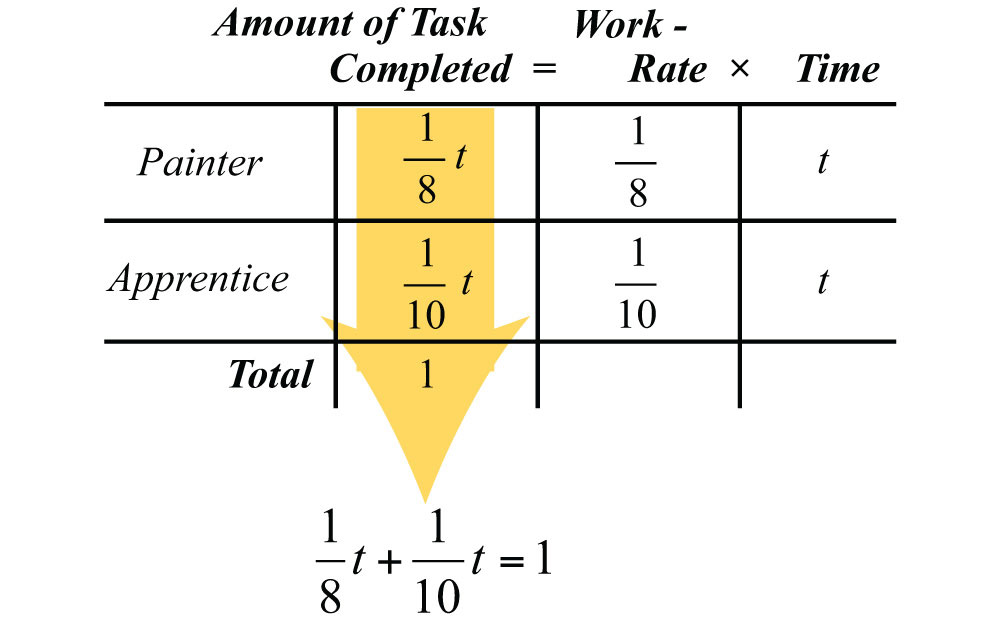
This setup results in a rational equation that can be solved for t by multiplying both sides by the LCD, 40.
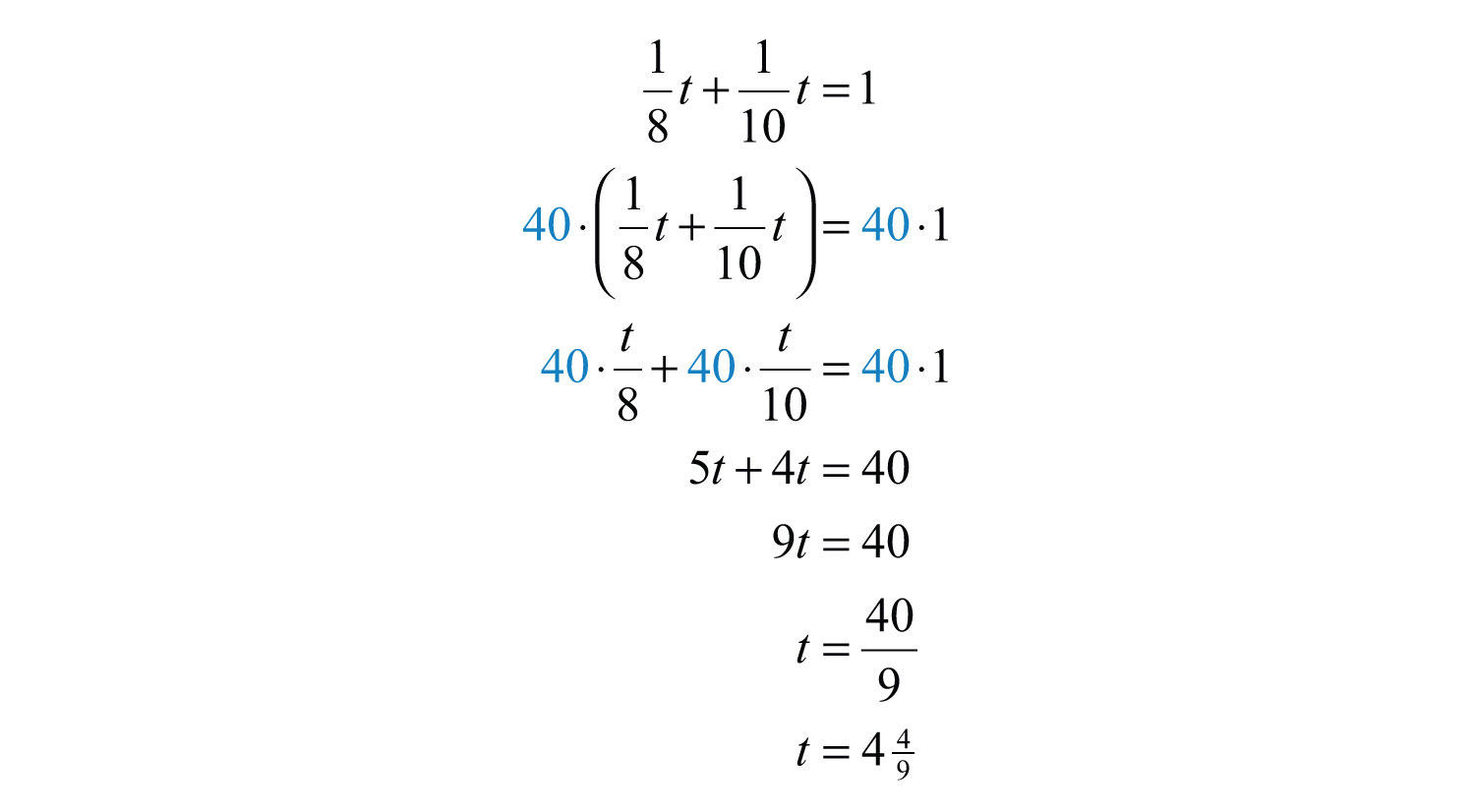
Therefore, the two painters, working together, complete the task in hours.
In general, we have the following work-rate formula, where and are the individual work rates and t is the time it takes to complete the task working together.:

Here and are the individual work rates and t is the time it takes to complete one task working together. If we factor out the time, t, and then divide both sides by t, we obtain an equivalent work-rate formula:

In summary, we have the following equivalent work-rate formulas:

Example 3: Working alone, Billy’s dad can complete the yard work in 3 hours. If Billy helps his dad, then the yard work takes 2 hours. How long would it take Billy working alone to complete the yard work?
Solution: The given information tells us that Billy’s dad has an individual work rate of task per hour. If we let x represent the time it takes Billy working alone to complete the yard work, then Billy’s individual work rate is , and we can write
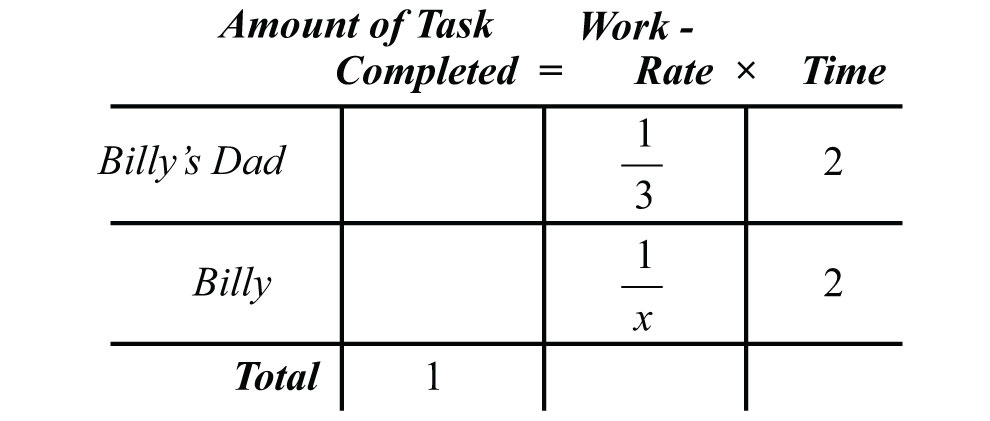
Working together, they can complete the task in 2 hours. Multiply the individual work rates by 2 hours to fill in the chart.
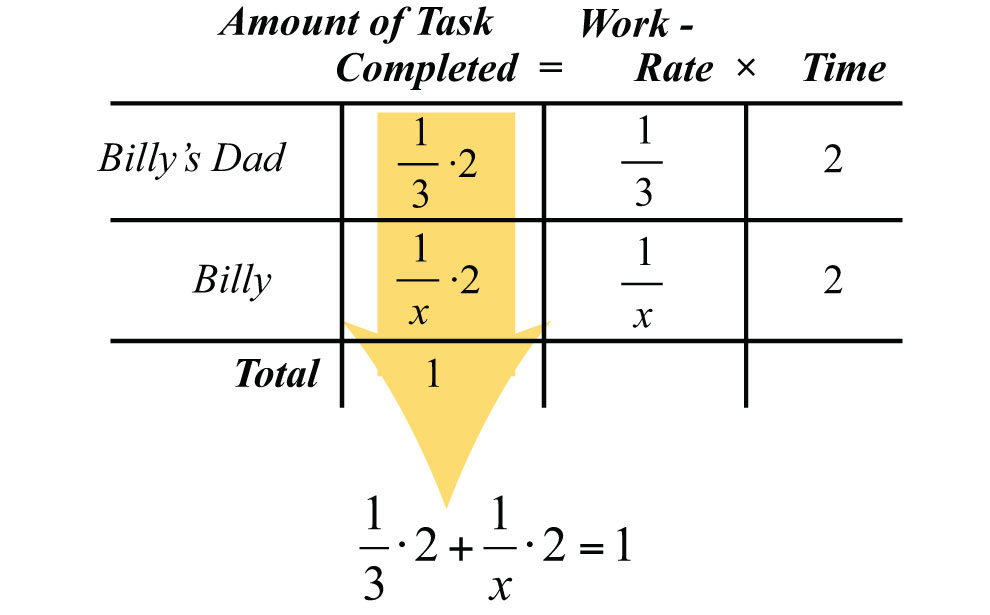
The amount of the task each completes will total 1 completed task. To solve for x, we first multiply both sides by the LCD, 3x.

Answer: It takes Billy 6 hours to complete the yard work alone.
Of course, the unit of time for the work rate need not always be in hours.
Example 4: Working together, two construction crews can build a shed in 5 days. Working separately, the less experienced crew takes twice as long to build a shed than the more experienced crew. Working separately, how long does it take each crew to build a shed?
Solution:

Working together, the job is completed in 5 days. This gives the following setup:
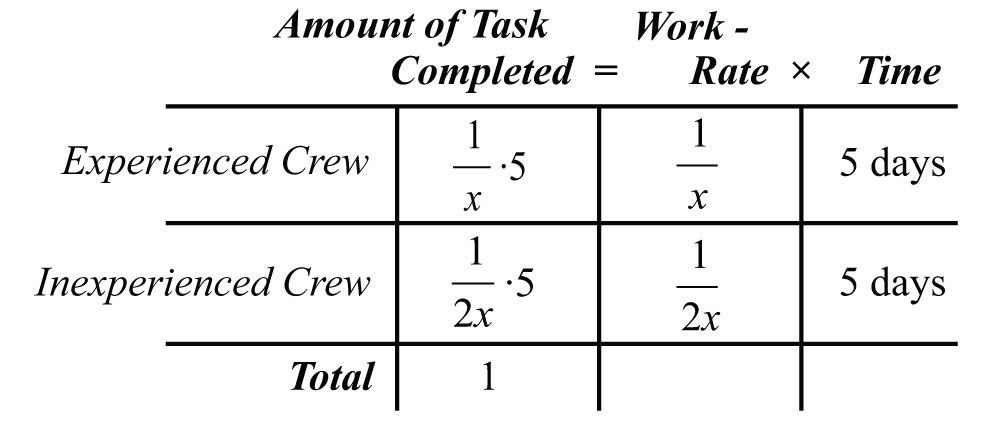
The first column in the chart gives us an algebraic equation that models the problem:

Solve the equation by multiplying both sides by 2x.
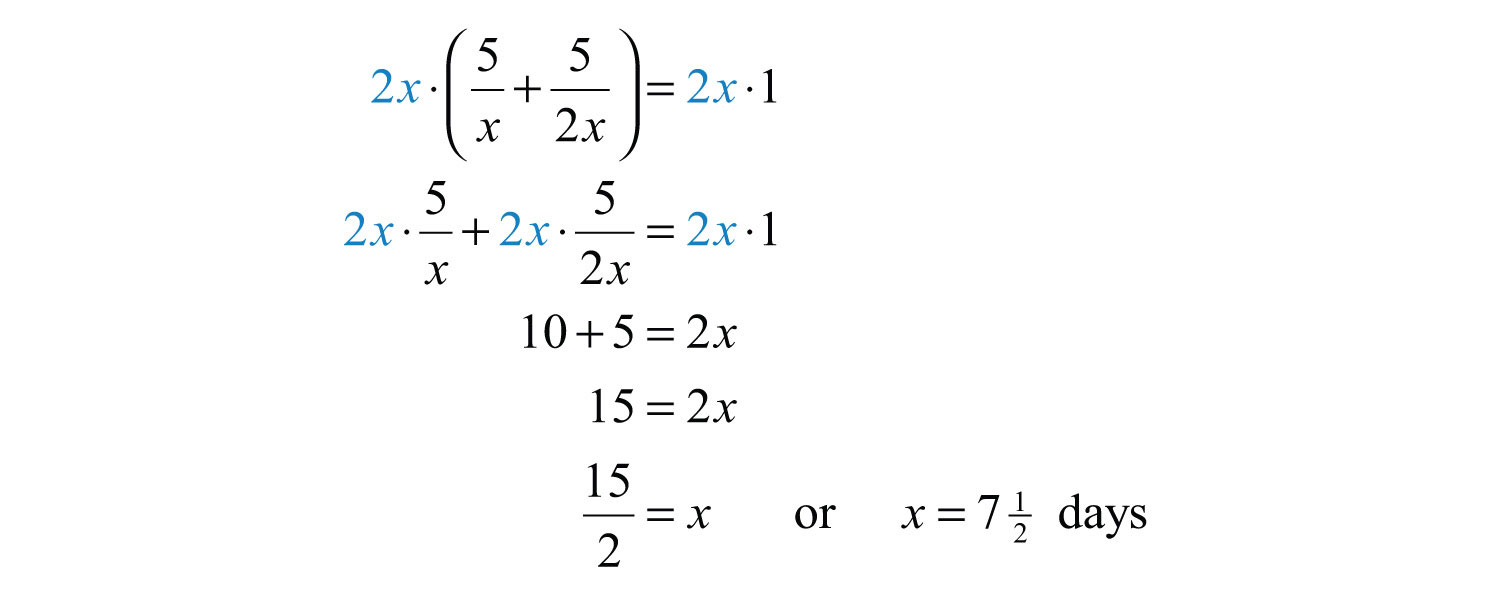
To determine the time it takes the less experienced crew, we use 2x:

Answer: Working separately, the experienced crew takes 7½ days to build a shed, and the less experienced crew takes 15 days to build a shed.
Try this! Joe’s garden hose fills the pool in 12 hours. His neighbor has a thinner hose that fills the pool in 15 hours. How long will it take to fill the pool using both hoses?
Answer: It will take both hoses hours to fill the pool.
Video Solution
(click to see video)Key Takeaways
- In this section, all of the steps outlined for solving general word problems apply. Look for the new key word “reciprocal,” which indicates that you should write the quantity in the denominator of a fraction with numerator 1.
- When solving distance problems where the time element is unknown, use the equivalent form of the uniform motion formula, , to avoid introducing more variables.
- When solving work-rate problems, multiply the individual work rate by the time to obtain the portion of the task completed. The sum of the portions of the task results in the total amount of work completed.
Topic Exercises
Part A: Number Problems
Use algebra to solve the following applications.
1. A positive integer is twice another. The sum of the reciprocals of the two positive integers is 3/10. Find the two integers.
2. A positive integer is twice another. The sum of the reciprocals of the two positive integers is 3/12. Find the two integers.
3. A positive integer is twice another. The difference of the reciprocals of the two positive integers is 1/8. Find the two integers.
4. A positive integer is twice another. The difference of the reciprocals of the two positive integers is 1/18. Find the two integers.
5. A positive integer is 2 less than another. If the sum of the reciprocal of the smaller and twice the reciprocal of the larger is 5/12, then find the two integers.
6. A positive integer is 2 more than another. If the sum of the reciprocal of the smaller and twice the reciprocal of the larger is 17/35, then find the two integers.
7. The sum of the reciprocals of two consecutive positive even integers is 11/60. Find the two even integers.
8. The sum of the reciprocals of two consecutive positive odd integers is 16/63. Find the integers.
9. The difference of the reciprocals of two consecutive positive even integers is 1/24. Find the two even integers.
10. The difference of the reciprocals of two consecutive positive odd integers is 2/99. Find the integers.
11. If 3 times the reciprocal of the larger of two consecutive integers is subtracted from 2 times the reciprocal of the smaller, then the result is 1/2. Find the two integers.
12. If 3 times the reciprocal of the smaller of two consecutive integers is subtracted from 7 times the reciprocal of the larger, then the result is 1/2. Find the two integers.
13. A positive integer is 5 less than another. If the reciprocal of the smaller integer is subtracted from 3 times the reciprocal of the larger, then the result is 1/12. Find the two integers.
14. A positive integer is 6 less than another. If the reciprocal of the smaller integer is subtracted from 10 times the reciprocal of the larger, then the result is 3/7. Find the two integers.
Part B: Uniform Motion Problems
Use algebra to solve the following applications.
15. James can jog twice as fast as he can walk. He was able to jog the first 9 miles to his grandmother’s house, but then he tired and walked the remaining 1.5 miles. If the total trip took 2 hours, then what was his average jogging speed?
16. On a business trip, an executive traveled 720 miles by jet aircraft and then another 80 miles by helicopter. If the jet averaged 3 times the speed of the helicopter and the total trip took 4 hours, then what was the average speed of the jet?
17. Sally was able to drive an average of 20 miles per hour faster in her car after the traffic cleared. She drove 23 miles in traffic before it cleared and then drove another 99 miles. If the total trip took 2 hours, then what was her average speed in traffic?
18. Harry traveled 15 miles on the bus and then another 72 miles on a train. If the train was 18 miles per hour faster than the bus and the total trip took 2 hours, then what was the average speed of the train?
19. A bus averages 6 miles per hour faster than a trolley. If the bus travels 90 miles in the same time it takes the trolley to travel 75 miles, then what is the speed of each?
20. A passenger car averages 16 miles per hour faster than the bus. If the bus travels 56 miles in the same time it takes the passenger car to travel 84 miles, then what is the speed of each?
21. A light aircraft travels 2 miles per hour less than twice as fast as a passenger car. If the passenger car can travel 231 miles in the same time it takes the aircraft to travel 455 miles, then what is the average speed of each?
22. Mary can run 1 mile per hour more than twice as fast as Bill can walk. If Bill can walk 3 miles in the same time it takes Mary to run 7.2 miles, then what is Bill’s average walking speed?
23. An airplane traveling with a 20-mile-per-hour tailwind covers 270 miles. On the return trip against the wind, it covers 190 miles in the same amount of time. What is the speed of the airplane in still air?
24. A jet airliner traveling with a 30-mile-per-hour tailwind covers 525 miles in the same amount of time it is able to travel 495 miles after the tailwind eases to 10 miles per hour. What is the speed of the airliner in still air?
25. A boat averages 16 miles per hour in still water. With the current, the boat can travel 95 miles in the same time it travels 65 miles against it. What is the speed of the current?
26. A river tour boat averages 7 miles per hour in still water. If the total 24-mile tour downriver and 24 miles back takes 7 hours, then how fast is the river current?
27. If the river current flows at an average 3 miles per hour, then a tour boat makes the 9-mile tour downstream with the current and back the 9 miles against the current in 4 hours. What is the average speed of the boat in still water?
28. Jane rowed her canoe against a 1-mile-per-hour current upstream 12 miles and then returned the 12 miles back downstream. If the total trip took 5 hours, then at what speed can Jane row in still water?
29. Jose drove 15 miles to pick up his sister and then returned home. On the return trip, he was able to average 15 miles per hour faster than he did on the trip to pick her up. If the total trip took 1 hour, then what was Jose’s average speed on the return trip?
30. Barry drove the 24 miles to town and then back in 1 hour. On the return trip, he was able to average 14 miles per hour faster than he averaged on the trip to town. What was his average speed on the trip to town?
31. Jerry paddled his kayak upstream against a 1-mile-per-hour current for 12 miles. The return trip downstream with the 1-mile-per-hour current took 1 hour less time. How fast can Jerry paddle the kayak in still water?
32. It takes a light aircraft 1 hour more time to fly 360 miles against a 30-mile-per-hour headwind than it does to fly the same distance with it. What is the speed of the aircraft in calm air?
Part C: Work-Rate Problems
Use algebra to solve the following applications.
33. James can paint the office by himself in 7 hours. Manny paints the office in 10 hours. How long will it take them to paint the office working together?
34. Barry can lay a brick driveway by himself in 12 hours. Robert does the same job in 10 hours. How long will it take them to lay the brick driveway working together?
35. Jerry can detail a car by himself in 50 minutes. Sally does the same job in 1 hour. How long will it take them to detail a car working together?
36. Jose can build a small shed by himself in 26 hours. Alex builds the same small shed in 2 days. How long would it take them to build the shed working together?
37. Allison can complete a sales route by herself in 6 hours. Working with an associate, she completes the route in 4 hours. How long would it take her associate to complete the route by herself?
38. James can prepare and paint a house by himself in 5 days. Working with his brother, Bryan, they can do it in 3 days. How long would it take Bryan to prepare and paint the house by himself?
39. Joe can assemble a computer by himself in 1 hour. Working with an assistant, he can assemble a computer in 40 minutes. How long would it take his assistant to assemble a computer working alone?
40. The teacher’s assistant can grade class homework assignments by herself in 1 hour. If the teacher helps, then the grading can be completed in 20 minutes. How long would it take the teacher to grade the papers working alone?
41. A larger pipe fills a water tank twice as fast as a smaller pipe. When both pipes are used, they fill the tank in 5 hours. If the larger pipe is left off, then how long would it take the smaller pipe to fill the tank?
42. A newer printer can print twice as fast as an older printer. If both printers working together can print a batch of flyers in 45 minutes, then how long would it take the newer printer to print the batch working alone?
43. Working alone, Henry takes 9 hours longer than Mary to clean the carpets in the entire office. Working together, they clean the carpets in 6 hours. How long would it take Mary to clean the office carpets if Henry were not there to help?
44. Working alone, Monique takes 4 hours longer than Audrey to record the inventory of the entire shop. Working together, they take inventory in 1.5 hours. How long would it take Audrey to record the inventory working alone?
45. Jerry can lay a tile floor in 3 hours less time than Jake. If they work together, the floor takes 2 hours. How long would it take Jerry to lay the floor by himself?
46. Jeremy can build a model airplane in 5 hours less time than his brother. Working together, they need 6 hours to build the plane. How long would it take Jeremy to build the model airplane working alone?
47. Harry can paint a shed by himself in 6 hours. Jeremy can paint the same shed by himself in 8 hours. How long will it take them to paint two sheds working together?
48. Joe assembles a computer by himself in 1 hour. Working with an assistant, he can assemble 10 computers in 6 hours. How long would it take his assistant to assemble 1 computer working alone?
49. Jerry can lay a tile floor in 3 hours, and his assistant can do the same job in 4 hours. If Jerry starts the job and his assistant joins him 1 hour later, then how long will it take to lay the floor?
50. Working alone, Monique takes 6 hours to record the inventory of the entire shop, while it takes Audrey only 4 hours to do the same job. How long will it take them working together if Monique leaves 2 hours early?
Answers
1: {5, 10}
3: {4, 8}
5: {6, 8}
7: {10, 12}
9: {6, 8}
11: {1, 2} or {−4, −3}
13: {4, 9} or {15, 20}
15: 6 miles per hour
17: 46 miles per hour
19: Trolley: 30 miles per hour; bus: 36 miles per hour
21: Passenger car: 66 miles per hour; aircraft: 130 miles per hour
23: 115 miles per hour
25: 3 miles per hour
27: 6 miles per hour
29: 40 miles per hour
31: 5 miles per hour
33: hours
35: minutes
37: 12 hours
39: 2 hours
41: 15 hours
43: 9 hours
45: 3 hours
47: hours
49: hours
7.7 Variation
Learning Objectives
- Solve applications involving direct variation.
- Solve applications involving inverse variation.
- Solve applications involving joint variation.
Direct Variation
Consider a freight train moving at a constant speed of 30 miles per hour. The equation that expresses the distance traveled at that speed in terms of time is given by

After 1 hour the train has traveled 30 miles, after 2 hours the train has traveled 60 miles, and so on. We can construct a chart and graph this relation.
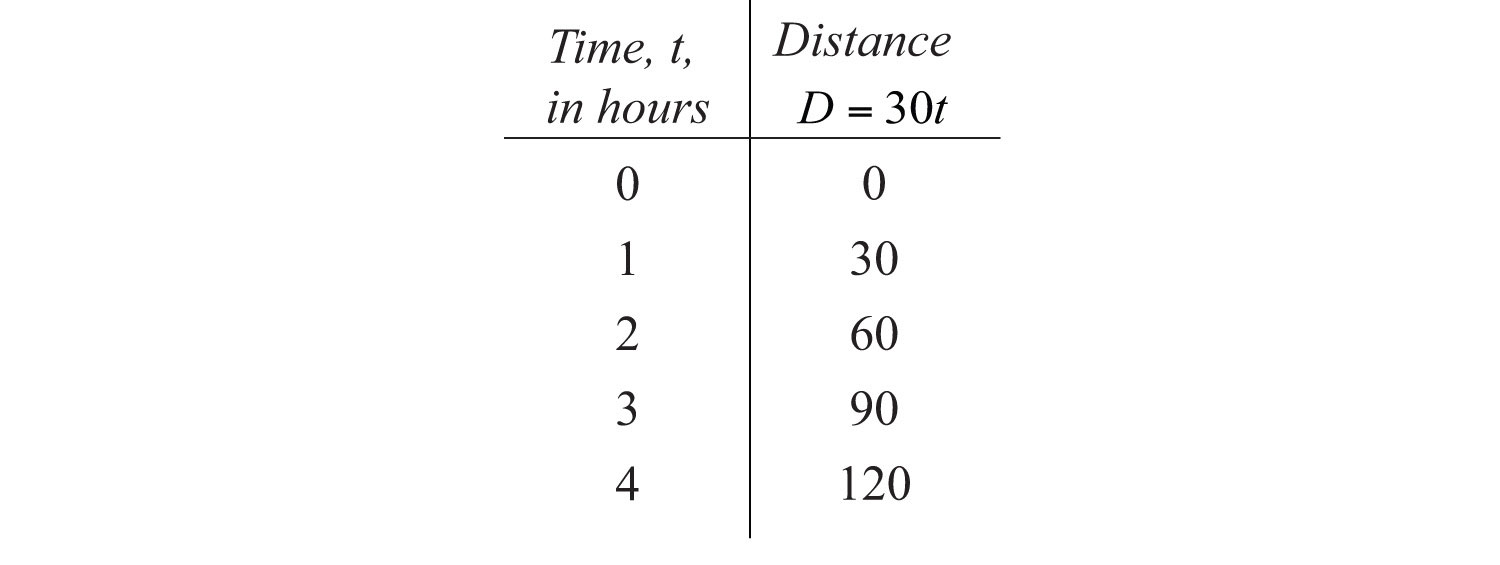
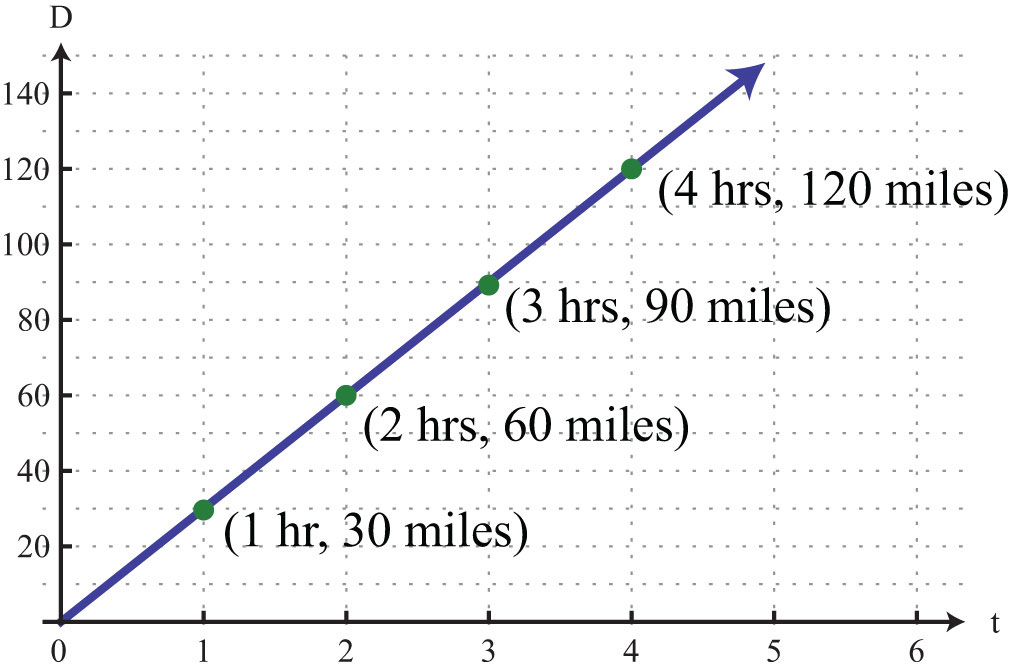
In this example, we can see that the distance varies over time as the product of the constant rate, 30 miles per hour, and the variable, t. This relationship is described as direct variationDescribes two quantities x and y that are constant multiples of each other: . and 30 is called the variation constant. In addition, if we divide both sides of by t we have

In this form, it is reasonable to say that D is proportional to t, where 30 is the constant of proportionality. In general, we have
| Key words | Translation |
|---|---|
“y varies directly as x” |
|
“y is directly proportionalUsed when referring to direct variation. to x” |
|
“y is proportional to x” |
Here k is nonzero and is called the constant of variationThe nonzero multiple k, when quantities vary directly or inversely. or the constant of proportionalityUsed when referring to the constant of variation..
Example 1: The circumference of a circle is directly proportional to its diameter, and the constant of proportionality is . If the circumference is measured to be 20 inches, then what is the radius of the circle?
Solution:

Use the fact that “the circumference is directly proportional to the diameter” to write an equation that relates the two variables.

We are given that “the constant of proportionality is ,” or . Therefore, we write

Now use this formula to find d when the circumference is 20 inches.

The radius of the circle, r, is one-half of its diameter.

Answer: The radius is inches, or approximately 3.18 inches.
Typically, we will not be given the constant of variation. Instead, we will be given information from which it can be determined.
Example 2: An object’s weight on earth varies directly to its weight on the moon. If a man weighs 180 pounds on earth, then he will weigh 30 pounds on the moon. Set up an algebraic equation that expresses the weight on earth in terms of the weight on the moon and use it to determine the weight of a woman on the moon if she weighs 120 pounds on earth.
Solution:

We are given that the “weight on earth varies directly to the weight on the moon.”

To find the constant of variation k, use the given information. A 180-pound man on earth weighs 30 pounds on the moon, or when .

Solve for k.

Next, set up a formula that models the given information.

This implies that a person’s weight on earth is 6 times her weight on the moon. To answer the question, use the woman’s weight on earth, , and solve for x.

Answer: The woman weighs 20 pounds on the moon.
Inverse Variation
Next, consider the relationship between time and rate,

If we wish to travel a fixed distance, then we can determine the average speed required to travel that distance in a given amount of time. For example, if we wish to drive 240 miles in 4 hours, we can determine the required average speed as follows:

The average speed required to drive 240 miles in 4 hours is 60 miles per hour. If we wish to drive the 240 miles in 5 hours, then determine the required speed using a similar equation:

In this case, we would only have to average 48 miles per hour. We can make a chart and view this relationship on a graph.
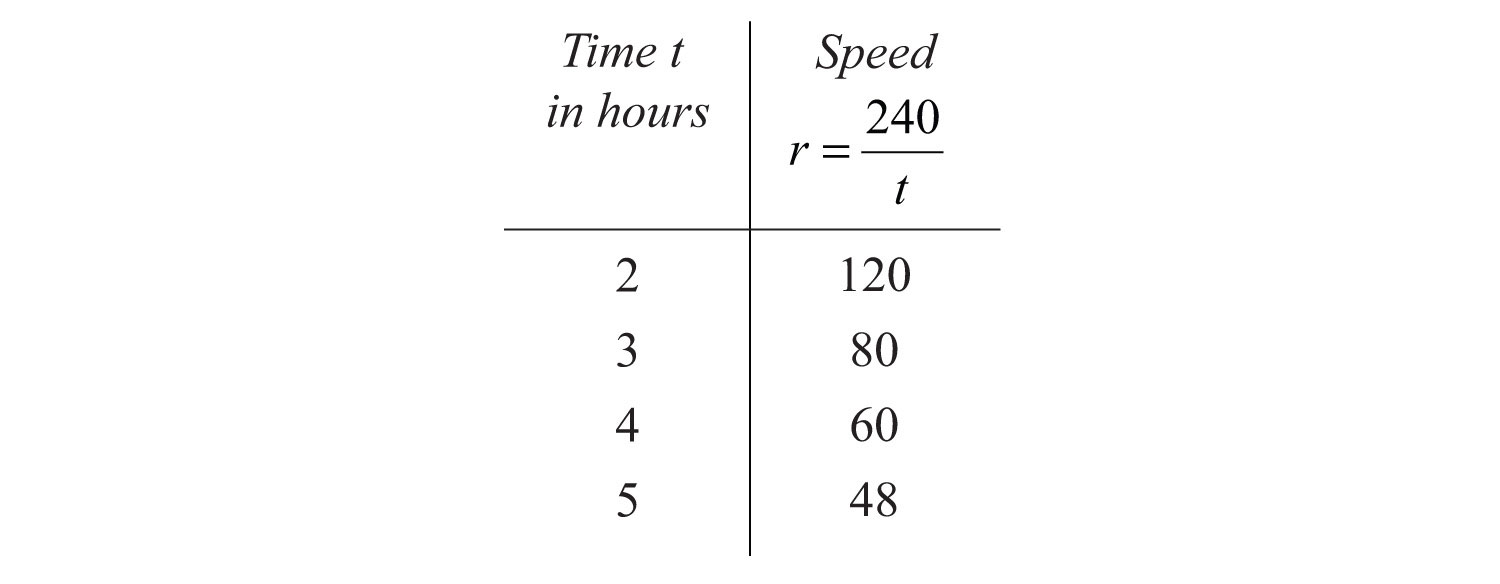
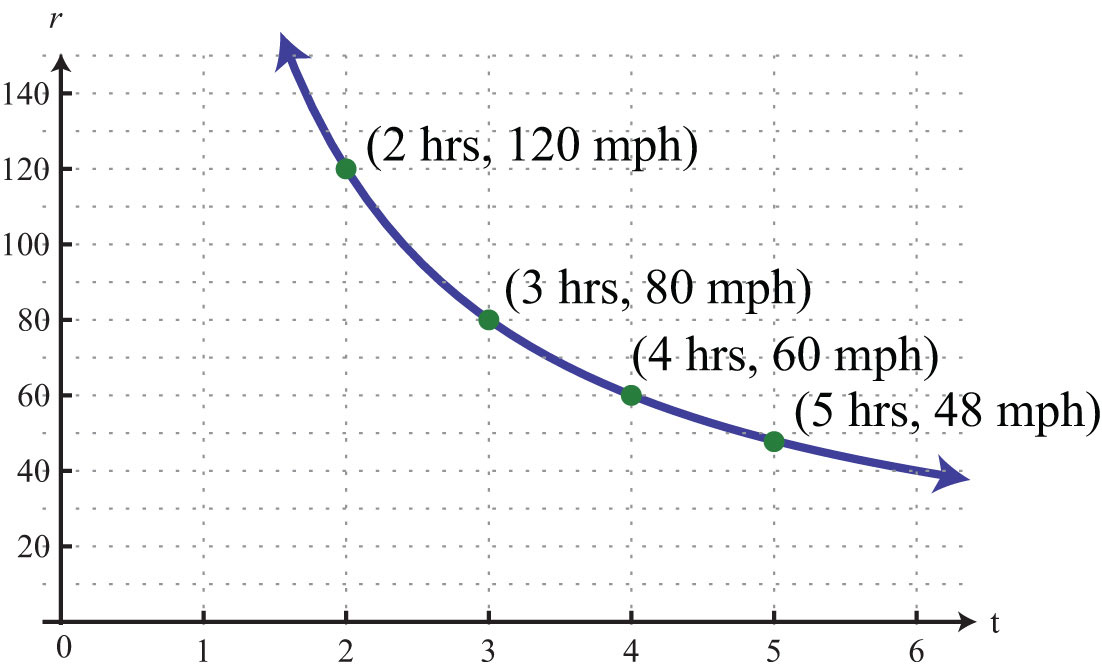
This is an example of an inverse relationship. We say that r is inversely proportional to the time t, where 240 is the constant of proportionality. In general, we have
| Key words | Translation |
|---|---|
“y varies inverselyDescribes two quantities x and y, where one variable is directly proportional to the reciprocal of the other: as x” |
|
“y is inversely proportionalUsed when referring to inverse variation. to x” |
Again, k is nonzero and is called the constant of variation or the constant of proportionality.
Example 3: If y varies inversely as x and when , then find the constant of proportionality and an equation that relates the two variables.
Solution: If we let k represent the constant of proportionality, then the statement “y varies inversely as x” can be written as follows:

Use the given information, when , to find k.

Solve for k.

Therefore, the formula that models the problem is

Answer: The constant of proportionality is 10, and the equation is .
Example 4: The weight of an object varies inversely as the square of its distance from the center of earth. If an object weighs 100 pounds on the surface of earth (approximately 4,000 miles from the center), then how much will it weigh at 1,000 miles above earth’s surface?
Solution:

Since “w varies inversely as the square of d,” we can write

Use the given information to find k. An object weighs 100 pounds on the surface of earth, approximately 4,000 miles from the center. In other words, w = 100 when d = 4,000:

Solve for k.

Therefore, we can model the problem with the following formula:

To use the formula to find the weight, we need the distance from the center of earth. Since the object is 1,000 miles above the surface, find the distance from the center of earth by adding 4,000 miles:

To answer the question, use the formula with d = 5,000.
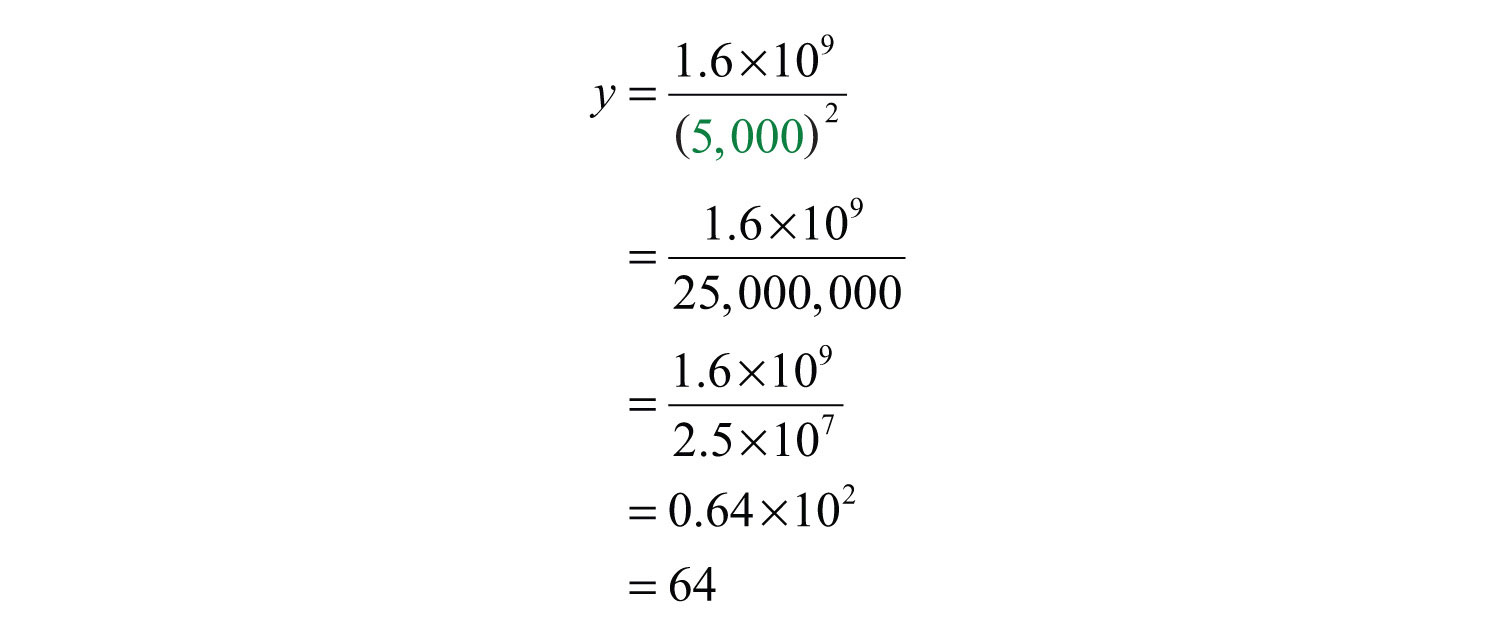
Answer: The object will weigh 64 pounds at a distance 1,000 miles above the surface of earth.
Joint Variation
Lastly, we define relationships between multiple variables. In general, we have
| Vocabulary | Translation |
|---|---|
“y varies jointlyDescribes a quantity y that varies directly as the product of two other quantities x and z: . as x and z” |
|
“y is jointly proportionalUsed when referring to joint variation. to x and z” |
Here k is nonzero and is called the constant of variation or the constant of proportionality.
Example 5: The area of an ellipse varies jointly as a, half of the ellipse’s major axis, and b, half of the ellipse’s minor axis. If the area of an ellipse is , where and , then what is the constant of proportionality? Give a formula for the area of an ellipse.

Solution: If we let A represent the area of an ellipse, then we can use the statement “area varies jointly as a and b” to write

To find the constant of variation, k, use the fact that the area is when and .

Therefore, the formula for the area of an ellipse is

Answer: The constant of proportionality is , and the formula for the area is .
Try this! Given that y varies directly as the square of x and inversely to z, where y = 2 when x = 3 and z = 27, find y when x = 2 and z = 16.
Answer: 3/2
Video Solution
(click to see video)Key Takeaway
- The setup of variation problems usually requires multiple steps. First, identify the key words to set up an equation and then use the given information to find the constant of variation k. After determining the constant of variation, write a formula that models the problem. Once a formula is found, use it to answer the question.
Topic Exercises
Part A: Variation Problems
Translate the following sentences into a mathematical formula.
1. The distance, D, an automobile can travel is directly proportional to the time, t, that it travels at a constant speed.
2. The extension of a hanging spring, d, is directly proportional to the weight, w, attached to it.
3. An automobile’s breaking distance, d, is directly proportional to the square of the automobile’s speed, v.
4. The volume, V, of a sphere varies directly as the cube of its radius, r.
5. The volume, V, of a given mass of gas is inversely proportional to the pressure, p, exerted on it.
6. The intensity, I, of light from a light source is inversely proportional to the square of the distance, d, from the source.
7. Every particle of matter in the universe attracts every other particle with a force, F, that is directly proportional to the product of the masses, and , of the particles and inversely proportional to the square of the distance, d, between them.
8. Simple interest, I, is jointly proportional to the annual interest rate, r, and the time, t, in years a fixed amount of money is invested.
9. The period, T, of a pendulum is directly proportional to the square root of its length, L.
10. The time, t, it takes an object to fall is directly proportional to the square root of the distance, d, it falls.
Construct a mathematical model given the following.
11. y varies directly as x, and y = 30 when x = 6.
12. y varies directly as x, and y = 52 when x = 4.
13. y is directly proportional to x, and y = 12 when x = 3.
14. y is directly proportional to x, and y = 120 when x = 20.
15. y varies directly as x, and y = 14 when x = 10.
16. y varies directly as x, and y = 2 when x = 8.
17. y varies inversely as x, and y = 5 when x = 7.
18. y varies inversely as x, and y = 12 when x = 2.
19. y is inversely proportional to x, and y = 3 when x = 9.
20. y is inversely proportional to x, and y = 21 when x = 3.
21. y varies inversely as x, and y = 2 when x = 1/8.
22. y varies inversely as x, and y = 3/2 when x = 1/9.
23. y varies jointly as x and z, where y = 8 when x = 4 and z = 1/2.
24. y varies jointly as x and z, where y = 24 when x = 1/3 and z = 9.
25. y is jointly proportional to x and z, where y = 2 when x = 1 and z = 3.
26. y is jointly proportional to x and z, where y = 15 when x = 3 and z = 7.
27. y varies jointly as x and z, where y = 2/3 when x = 1/2 and z = 12.
28. y varies jointly as x and z, where y = 5 when x = 3/2 and z = 2/9.
29. y varies directly as the square of x, where y = 45 when x = 3.
30. y varies directly as the square of x, where y = 3 when x = 1/2.
31. y is inversely proportional to the square of x, where y = 27 when x = 1/3.
32. y is inversely proportional to the square of x, where y = 9 when x = 2/3.
33. y varies jointly as x and the square of z, where y = 54 when x = 2 and z = 3.
34. y varies jointly as x and the square of z, where y = 6 when x = 1/4 and z = 2/3.
35. y varies jointly as x and z and inversely as the square of w, where y = 30 when x = 8, z = 3, and w = 2.
36. y varies jointly as x and z and inversely as the square of w, where y = 5 when x = 1, z = 3, and w = 1/2.
37. y varies directly as the square root of x and inversely as z, where y = 12 when x = 9 and z = 5.
38. y varies directly as the square root of x and inversely as the square of z, where y = 15 when x = 25 and z = 2.
39. y varies directly as the square of x and inversely as z and the square of w, where y = 14 when x = 4, w = 2, and z = 2.
40. y varies directly as the square root of x and inversely as z and the square of w, where y = 27 when x = 9, w = 1/2, and z = 4.
Part B: Variation Problems
Applications involving variation.
41. Revenue in dollars is directly proportional to the number of branded sweat shirts sold. If the revenue earned from selling 25 sweat shirts is $318.75, then determine the revenue if 30 sweat shirts are sold.
42. The sales tax on the purchase of a new car varies directly as the price of the car. If an $18,000 new car is purchased, then the sales tax is $1,350. How much sales tax is charged if the new car is priced at $22,000?
43. The price of a share of common stock in a company is directly proportional to the earnings per share (EPS) of the previous 12 months. If the price of a share of common stock in a company is $22.55 and the EPS is published to be $1.10, then determine the value of the stock if the EPS increases by $0.20.
44. The distance traveled on a road trip varies directly with the time spent on the road. If a 126-mile trip can be made in 3 hours, then what distance can be traveled in 4 hours?
45. The circumference of a circle is directly proportional to its radius. If the circumference of a circle with radius 7 centimeters is measured as centimeters, then find the constant of proportionality.
46. The area of circle varies directly as the square of its radius. If the area of a circle with radius 7 centimeters is determined to be square centimeters, then find the constant of proportionality.
47. The surface area of a sphere varies directly as the square of its radius. When the radius of a sphere measures 2 meters, the surface area measures square meters. Find the surface area of a sphere with radius 3 meters.
48. The volume of a sphere varies directly as the cube of its radius. When the radius of a sphere measures 3 meters, the volume is cubic meters. Find the volume of a sphere with radius 1 meter.
49. With a fixed height, the volume of a cone is directly proportional to the square of the radius at the base. When the radius at the base measures 10 centimeters, the volume is 200 cubic centimeters. Determine the volume of the cone if the radius of the base is halved.
50. The distance, d, an object in free fall drops varies directly with the square of the time, t, that it has been falling. If an object in free fall drops 36 feet in 1.5 seconds, then how far will it have fallen in 3 seconds?
Hooke’s law suggests that the extension of a hanging spring is directly proportional to the weight attached to it. The constant of variation is called the spring constant.
Figure 7.1 Robert Hooke (1635–1703)
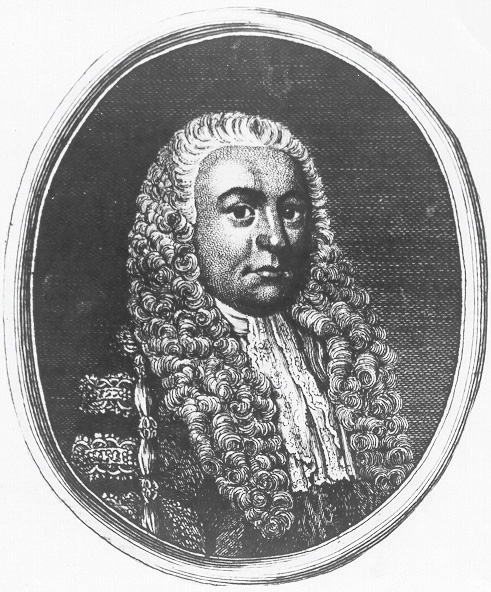
51. If a hanging spring is stretched 5 inches when a 20‑pound weight is attached to it, then determine its spring constant.
52. If a hanging spring is stretched 3 centimeters when a 2-kilogram weight is attached to it, then determine the spring constant.
53. If a hanging spring is stretched 3 inches when a 2‑pound weight is attached, then how far will it stretch with a 5-pound weight attached?
54. If a hanging spring is stretched 6 centimeters when a 4-kilogram weight is attached to it, then how far will it stretch with a 2-kilogram weight attached?
The breaking distance of an automobile is directly proportional to the square of its speed.
55. If it takes 36 feet to stop a particular automobile moving at a speed of 30 miles per hour, then how much breaking distance is required if the speed is 35 miles per hour?
56. After an accident, it was determined that it took a driver 80 feet to stop his car. In an experiment under similar conditions, it takes 45 feet to stop the car moving at a speed of 30 miles per hour. Estimate how fast the driver was moving before the accident.
Boyle’s law states that if the temperature remains constant, the volume, V, of a given mass of gas is inversely proportional to the pressure, p, exerted on it.
Figure 7.2 Robert Boyle (1627–1691)
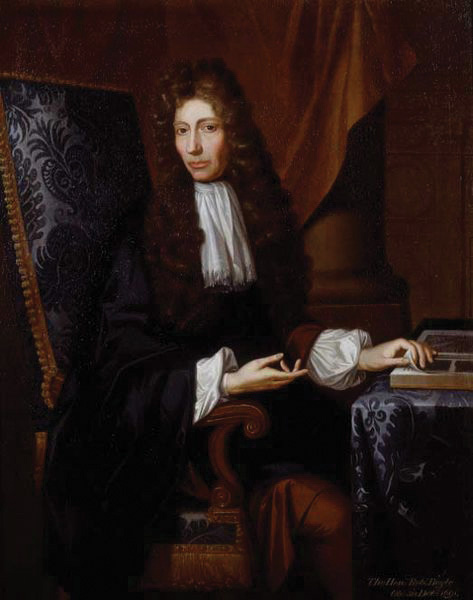
Portrait of Robert Boyle, from http://commons.wikimedia.org/wiki/File:Robert_boyle.jpg.
57. A balloon is filled to a volume of 216 cubic inches on a diving boat under 1 atmosphere of pressure. If the balloon is taken underwater approximately 33 feet, where the pressure measures 2 atmospheres, then what is the volume of the balloon?
58. If a balloon is filled to 216 cubic inches under a pressure of 3 atmospheres at a depth of 66 feet, then what would the volume be at the surface, where the pressure is 1 atmosphere?
59. To balance a seesaw, the distance from the fulcrum that a person must sit is inversely proportional to his weight. If a 72-pound boy is sitting 3 feet from the fulcrum, then how far from the fulcrum must a 54-pound boy sit to balance the seesaw?
60. The current, I, in an electrical conductor is inversely proportional to its resistance, R. If the current is 1/4 ampere when the resistance is 100 ohms, then what is the current when the resistance is 150 ohms?
61. The number of men, represented by y, needed to lay a cobblestone driveway is directly proportional to the area, A, of the driveway and inversely proportional to the amount of time, t, allowed to complete the job. Typically, 3 men can lay 1,200 square feet of cobblestone in 4 hours. How many men will be required to lay 2,400 square feet of cobblestone given 6 hours?
62. The volume of a right circular cylinder varies jointly as the square of its radius and its height. A right circular cylinder with a 3-centimeter radius and a height of 4 centimeters has a volume of cubic centimeters. Find a formula for the volume of a right circular cylinder in terms of its radius and height.
63. The period, T, of a pendulum is directly proportional to the square root of its length, L. If the length of a pendulum is 1 meter, then the period is approximately 2 seconds. Approximate the period of a pendulum that is 0.5 meter in length.
64. The time, t, it takes an object to fall is directly proportional to the square root of the distance, d, it falls. An object dropped from 4 feet will take 1/2 second to hit the ground. How long will it take an object dropped from 16 feet to hit the ground?
Newton’s universal law of gravitation states that every particle of matter in the universe attracts every other particle with a force, F, that is directly proportional to the product of the masses, and , of the particles and inversely proportional to the square of the distance, d, between them. The constant of proportionality is called the gravitational constant.
Figure 7.3 Sir Isaac Newton (1643–1724)

Source: Portrait of Isaac Newton by Sir Godfrey Kneller, from http://commons.wikimedia.org/wiki/File:GodfreyKneller-IsaacNewton-1689.jpg.
65. If two objects with masses 50 kilograms and 100 kilograms are 1/2 meter apart, then they produce approximately newtons (N) of force. Calculate the gravitational constant.
66. Use the gravitational constant from the previous exercise to write a formula that approximates the force, F, in newtons between two masses and , expressed in kilograms, given the distance d between them in meters.
67. Calculate the force in newtons between earth and the moon, given that the mass of the moon is approximately kilograms, the mass of earth is approximately kilograms, and the distance between them is on average meters.
68. Calculate the force in newtons between earth and the sun, given that the mass of the sun is approximately kilograms, the mass of earth is approximately kilograms, and the distance between them is on average meters.
69. If y varies directly as the square of x, then how does y change if x is doubled?
70. If y varies inversely as square of t, then how does y change if t is doubled?
71. If y varies directly as the square of x and inversely as the square of t, then how does y change if both x and t are doubled?
Answers
1:
3:
5:
7:
9:
11:
13:
15:
17:
19:
21:
23:
25:
27:
29:
31:
33:
35:
37:
39:
41: $382.50
43: $26.65
45:
47: square meters
49: 50 cubic centimeters
51: 1/4
53: 7.5 inches
55: 49 feet
57: 108 cubic inches
59: 4 feet
61: 4 men
63: 1.4 seconds
65:
67:
69: y changes by a factor of 4
71: y remains unchanged
7.8 Review Exercises and Sample Exam
Review Exercises
Simplifying Rational Expressions
Evaluate for the given set of x-values.
1. ; {−5, 0, 5}
2. ; {1/2, 2, 4}
3. ; {−3, 0, 3}
4. ; {−3, 0, 3}
State the restrictions to the domain.
5.
6.
7.
8.
State the restrictions and simplify.
9.
10.
11.
12.
13.
14.
15. Given , find , , and .
16. Simplify and state the restrictions.
Multiplying and Dividing Rational Expressions
Multiply. (Assume all denominators are nonzero.)
17.
18.
19.
20.
21.
22.
Divide. (Assume all denominators are nonzero.)
23.
24.
25.
26.
27.
28.
29.
30.
31. Given and , calculate and state the restrictions.
32. Given and , calculate and state the restrictions.
Adding and Subtracting Rational Expressions
Simplify. (Assume all denominators are nonzero.)
33.
34.
35.
36.
37.
38.
39.
40.
41.
42.
43.
44.
45. Given and , calculate and state the restrictions.
46. Given and , calculate and state the restrictions.
Complex Fractions
Simplify.
47.
48.
49.
50.
51.
52.
53.
54.
Solving Rational Equations
Solve.
55.
56.
57.
58.
59.
60.
61.
62.
63.
64.
65.
66.
67. Solve for a: .
68. Solve for y: .
Applications of Rational Equations
Use algebra to solve the following applications.
69. A positive integer is twice another. The sum of the reciprocals of the two positive integers is 1/4. Find the two integers.
70. If the reciprocal of the smaller of two consecutive integers is subtracted from three times the reciprocal of the larger, the result is 3/10. Find the integers.
71. Mary can jog, on average, 2 miles per hour faster than her husband, James. James can jog 6.6 miles in the same amount of time it takes Mary to jog 9 miles. How fast, on average, can Mary jog?
72. Billy traveled 140 miles to visit his grandmother on the bus and then drove the 140 miles back in a rental car. The bus averages 14 miles per hour slower than the car. If the total time spent traveling was 4.5 hours, then what was the average speed of the bus?
73. Jerry takes twice as long as Manny to assemble a skateboard. If they work together, they can assemble a skateboard in 6 minutes. How long would it take Manny to assemble the skateboard without Jerry’s help?
74. Working alone, Joe completes the yard work in 30 minutes. It takes Mike 45 minutes to complete work on the same yard. How long would it take them working together?
Variation
Construct a mathematical model given the following.
75. y varies directly with x, and y = 12 when x = 4.
76. y varies inversely as x, and y = 2 when x = 5.
77. y is jointly proportional to x and z, where y = 36 when x = 3 and z = 4.
78. y is directly proportional to the square of x and inversely proportional to z, where y = 20 when x = 2 and z = 5.
79. The distance an object in free fall drops varies directly with the square of the time that it has been falling. It is observed that an object falls 16 feet in 1 second. Find an equation that models the distance an object will fall and use it to determine how far it will fall in 2 seconds.
80. The weight of an object varies inversely as the square of its distance from the center of earth. If an object weighs 180 pounds on the surface of earth (approximately 4,000 miles from the center), then how much will it weigh at 2,000 miles above earth’s surface?
Sample Exam
Simplify and state the restrictions.
1.
2.
3.
4.
Simplify. (Assume all variables in the denominator are positive.)
5.
6.
7.
8.
9.
10.
11.
12.
13. Given and , calculate and state the restrictions.
14. Given and , calculate and state the restrictions.
Solve.
15.
16.
17.
18.
19.
20.
21. Solve for r: .
Set up an algebraic equation and then solve.
22. An integer is three times another. The sum of the reciprocals of the two integers is 1/3. Find the two integers.
23. Working alone, Joe can paint the room in 6 hours. If Manny helps, then together they can paint the room in 2 hours. How long would it take Manny to paint the room by himself?
24. A river tour boat averages 6 miles per hour in still water. With the current, the boat can travel 17 miles in the same time it can travel 7 miles against the current. What is the speed of the current?
25. The breaking distance of an automobile is directly proportional to the square of its speed. Under optimal conditions, a certain automobile moving at 35 miles per hour can break to a stop in 25 feet. Find an equation that models the breaking distance under optimal conditions and use it to determine the breaking distance if the automobile is moving 28 miles per hour.
Review Exercises Answers
1: 1/2, undefined, 1/2
3: 1/18, 1/9, 1/18
5:
7:
9: ;
11: ;
13: ;
15: , ,
17:
19:
21:
23:
25:
27:
29:
31: ;
33:
35:
37:
39:
41:
43:
45: ;
47:
49:
51:
53:
55: −3/5
57: −3
59: −10, 1
61: 3, 8
63: 3
65: Ø
67:
69: 6, 12
71: 7.5 miles per hour
73: 9 minutes
75:
77:
79: ; 64 feet
Sample Exam Answers
1: ;
3: ;
5:
7:
9:
11:
13: ;
15: 3/5
17: 4, 5
19: 4
21:
23: 3 hours
25: ; 16 feet




